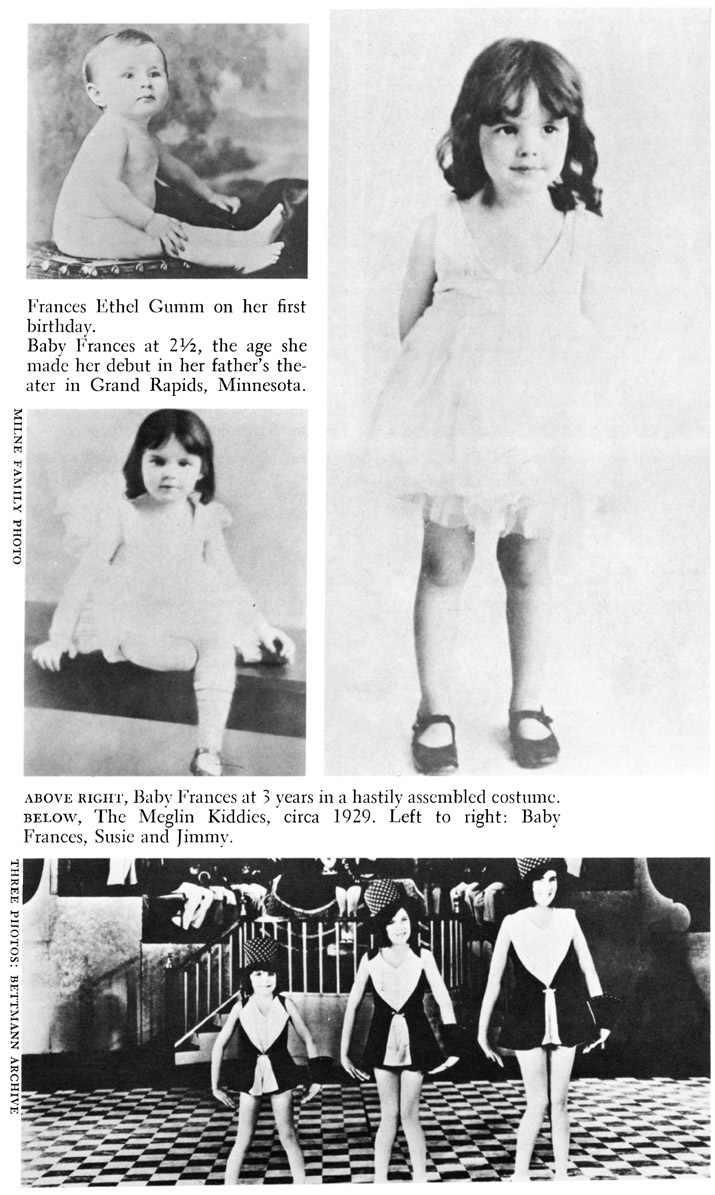
I played the stage, the Capitol,
And people said, “Don’t stop”;
Until you’ve played the Palace
You haven’t played the top.
For years I had it preached to me,
And drummed into my head;
Unless you played the Palace,
You might as well be dead.
... it became the Hall of Fame—
The mecca of the trade;
When you had played the Palace,
You knew that you were made.
So I hope you’ll understand
My wondrous thrill;
‘Cause Vaudeville’s back at the Palace,
And I’m on the bill.
—Roger Edens
23At the beginning of her severance from Mayer and the studio, Judy felt like a displaced refugee. There seemed no place for her to go. Her film career appeared to be behind her. Summer Stock was yet to be released, and she knew her performance had been creditable; but word had passed from studio to studio; rumor spread by mouth to press—Garland was an untouchable. At her own studio she had been replaced by Leslie Caron, Jane Powell, and Debbie Reynolds. At Twentieth Century-Fox, Marilyn Monroe had startled audiences and awakened studio executives in The Asphalt Jungle and All About Eve.
Mayer’s loan was little more than what recently had constituted a week’s salary. Admittedly, that amount was above the national yearly income for a family of four, but that had to be placed in its proper perspective. Judy had never handled her own money—had no conception of the cost of things. Since achieving stardom at MGM, she had lived in the manner of royalty. Houses were showcases; clothes were specially designed, cars and chauffeurs ordered on demand; secretaries answered mail; maids cleaned; cooks commanded kitchens; children were in the hands of nursemaids; bills were paid by accountants; and you never saw the money you earned. What she knew was that in order to keep all these things in running order, she must perform nonstop. Now the mechanism had ground to a heavy halt.
Panic set in. She was broke. In a similar situation average people would, perhaps, move to a small apartment, tend house themselves, take any kind of job to tide them over. But Judy had no idea how to accomplish such a foreign way of living.
Instead, she moved into the Beverly Hills Hotel—possibly one of the most luxurious hotels in the world, but the one she was accustomed to visiting when close friends and business associates came to California. Her suite (she had Liza and a nursemaid with her) cost over $150 a day. She never thought to ask, however, how much it was costing her; and had she, it is doubtful that she would have known what else to do. One thing was obvious, though: Mayer’s loan would not last long with such a high standard of living.
Louella Parsons (in her book Tell It to Louella) stated: “I have heard it said that much that happened to Judy was the fault of Hollywood. I can’t agree. I can only say, however, that it could only have happened in Hollywood.”
Hollywood citizenry is not notable for a sense of loyalty. Riven, at the time, by mushrooming clouds of McCarthyism, Hollywood trembled in fear. Pink subpoenae were being received at the most famous houses, commanding their occupants to appear before The Committee. But those who did not receive subpoenae were not free and clear; they could be guilty by association. It was an economic condition that the Hollywood elite had always had to survive. To be connected with a film that failed, a falling star, a has-been director could mean the taint would rub off on anyone too close. That is why there were during those years so many “comebacks” in Hollywood. One bad film and you were reduced to the status of “has-been.”
With that fear always hanging over their heads, members of the industry who had a free choice, could not afford the risk of hiring a star who might crack up at any moment and throw their budget or film into chaos. Judy was fully aware of her position. In some ways, she accepted this harsh truth with a sense of relief. Appearing before the cameras was unthinkable. She was sick and exhausted. For days she never got out of her hotel room. Then she was presented with her first weekly bill. The same anxieties and terrors as when she had seen her hospital bills grasped her, and Mayer’s loan was running out.
To further complicate her situation, she was without representation. She had, the last few years, been represented by the Berg-Allenberg Agency, but Phil Berg and Burt Allenberg had split. Berg, whose private client she was, no longer had an association with the office. Had she been a winner at that time, there is no question that Allenberg would have held tenaciously on to her agency commitment. It would seem, however, that no matter how reluctant he was in moral attitude to walk away from her, his business acumen won out.
Most plaudits have gone to Sid Luft, who was to be her future husband, and Abe Lastfogel, of the William Morris Agency, who would finally come to represent her, for starting Judy out on a new career—the concert stage. But in fact, it was Ethel who was responsible for the second phenomenon of stardom in her daughter’s life.
Now divorced from Gilmore, Ethel rushed to Judy’s side. Whatever her motive, whatever enmity had been between them, however complex Ethel’s reappearance in Judy’s life and Judy’s acceptance of that presence—each now desperately needed the other, and neither had anyone else to turn to. True, Ethel had two other daughters, but they had gone their own ways: Sue marrying bandleader Jack Cathcart and living in Las Vegas; Jimmy now married to Thomas Thompson and residing in Dallas. One of Ethel’s sisters, Norma, did live in Hollywood and was, in fact, struggling to make a career for herself as a singer. Married to a stunt man and fighting Judy’s image (her voice had a distinct Garland ring to it), Norma did not seem to Ethel to have a real future. Except for one brother, Frank Milne, the other close members of her large family were not part of the entertainment world, and as Frank was a gambler, Ethel did not approve of him and was always angry when Judy advanced him money. Ethel, not prepared yet to go it alone, turned to Judy.
It seemed perfectly clear to Ethel that since Judy had started on a stage with a live audience, she could begin again there. Convincing Judy that cabaret or theater exposure would not be as demanding as films, Ethel then had to set about, as she once had, to find an engagement. She never had to persuade Judy of the financial necessity of her working. Judy was almost too much aware of the fact, and it pained her gravely. Minnelli was not inclined, nor could he afford, to maintain a standard of accustomed living for them both individually.
Having been out of the business for years, Ethel could only hope to tap familiar and old haunts. She went to the Cal-Neva Lodge; and though the terms of that contract aren’t known, the fee Ethel was to receive was reported as fair and satisfactory. The two women then went to Roger Edens, who helped them put together an act. (This was fundamentally the same act that Judy later took to the Palladium.)
By the time Judy arrived at Cal-Neva Lodge, Summer Stock had previewed. After viewing it at a private showing, Billy Rose was prompted to write her an open letter in his syndicated column, Pitching Horseshoes, titling the letter “Love Letter to a National Asset” and addressing it to Judy at the Cal-Neva Lodge, Lake Tahoe, California. Rose (who had once been married to Fanny Brice) wrote in part:
I found your portrayal of a farm girl in “Summer Stock” as convincing as a twenty-dollar gold piece, and when you leveled on Harold Arlen’s old song, “Get Happy”—well, it was Al Jolson in lace panties, Maurice Chevalier in opera pumps! . . . Naturally you’re wondering why I’m taking heart in ball-pen and writing you this love-and-kudos letter right out in the open. Well, like everyone else, I read the front-page stories about you a couple of months back, and from the lines between the lines I sensed that you had been having a bout with the jim-jams yourself, and that you no longer cared much whether school kept or not. . . .
This letter—and I know it’s plenty presumptuous—is to point out, in case you haven’t thought of it yourself, how important it is to millions of people in this country that school continue to keep for Judy Garland. ... It gets down to this, Judy: In an oblique and daffy sort of way, you are as much a national asset as our coal reserves—both of you help warm up our insides.
The letter was signed “Your devoted fan, Billy Rose.”
All the principals in the Cal-Neva plan to present Judy Garland for the first time in a supper club are now dead, and with them died the explanation of why Judy never did honor that contract. She remained at the Lodge for several weeks at their expense and worked on musical arrangements with Roger Edens. But then she abruptly left and returned to the Beverly Hills Hotel, now checking into a seven-room suite, which included connecting rooms for Ethel; for a secretary, Myrtle Tully; and for Liza and her nursemaid. Judy then proceeded to indulge herself in an eating binge that within a very short time added an additional thirty pounds to her five-foot-two-inch frame.
Now, answerable only to herself, she was flaunting Hollywood and all the demands and restrictions being a film star had imposed. When her hair once again began to fall out, she clipped it short and wore it in a boyish style; and taking what little money remained, she bought an air ticket to New York, moving Liza and the nursemaid back to Minnelli’s care and sending Ethel to stay with Norma. The hotel was told to send the bill to her agents, Berg and Allenberg, although they no longer represented her.
In New York she checked into a luxury hotel, devoured almost every dish on the Room Service menu, walked all over Manhattan, and cheered New York to win over Philadelphia in the 1950 World Series. Friends extended her loans which enabled her to survive, but it was her exposure to the crowds of people who grasped her hands, the contact with fans who appeared to love and care for her that kept her alive.
She became exceptionally heavy. The joy, the ecstasy of her new personal freedom faded fast. The hotel bill was ballooning as quickly as she was. Anxiety riddled her body, stirring her into constant wakefulness; and there was not the pill availability she had had in California.
Plump, matronly-looking, on edge, she attended a cocktail party and at it met Michael Sidney Luft. Later she claimed it was love at first sight. Perhaps, but it is more likely that she simply responded to his flattering male attention, which had not been coming her way for a long time. Always a romantic, Judy needed romance in her life now more than ever before to help her reestablish her sense of “womanliness”; it is therefore, not difficult to understand Luft’s appeal for her.
He did not stand in judgment of anything she did. He was a rebellious spirit, rootless, and without any specific talent or trade. Born in New Rochelle, Luft had grown up in Bronxville, New York, and had attended the Hun School in Princeton, the University of Pennsylvania, and the University of Miami. Athletically inclined as a young man, he had always been a glib talker and a bit of a show-off. He came from a small middle-class Jewish family, and he seemed able to break ties quite early. At the age of nineteen he was living on his own in Ottawa, Canada, where he was involved in the production of an Aquacade. It was his first taste of professional show business, and it made a strong impression on him. On future records he claimed that in 1940 he had joined the Royal Canadian Air Force and that once discharged, he had traveled to Hollywood. In Hollywood he looked up an old schoolmate from Bronxville, dancer Eleanor Powell, who was then a star, and for a time was her secretary.
After that, records state he was a Douglas test pilot and a technical adviser on the flying sequences of a low-budget film called Charter Pilot The film was what was then called a “programmer”—meaning it was to be booked as the bottom half of a double feature. In it was actress Lynn Bari, known at the time as the Queen of the “B’s.” Luft married her and immediately stepped in to take over her career. His intention was to promote an independent film with himself as producer and Miss Bari as star. A lovely-looking lady, a reliable performer, and a popular supporting player, Miss Bari, unfortunately, did not have the charisma on which stars and independent films are banked, and so for eight years Luft floundered through a marriage in which his wife was the bigger wage earner—but through no business acumen attributable to him.
Broad-shouldered, bedroom-eyed, easy-mannered, Luft had a freewheeling, unrestrained attitude that had a special charm for Judy. It was new; it was exciting; and there was a sense of surprise at her own attraction to him. He was not at all like her previous husbands.
She returned to Los Angeles, and Luft followed. Neither had a job, and both were involved in divorce actions. They saw each other constantly, and what he said, coupled with Ethel’s initial push, nagged at her. In essence, it was “The hell with films—why not the stage?” And if the stage—why not the Palace? He also suggested he manage her career. But Judy still had too much respect for the Hollywood “system” and was inclined to believe she needed a strong and well-established Hollywood agency. She went to Phil Berg, who was now with Abe Last-fogel at William Morris. Berg discussed it with Abe and they met with Judy. The next day the new alliance was announced in Variety:
Hollywood, October 10 [1950]:
Judy Garland signed an agency deal with the William Morris office, which will function hereafter as her representatives [sic] in all phases of show business. First move will be to set up guest shots on radio, but the star will not be available for T.V. work “for the time being.”
In the same issue of Variety was an announcement that “finally free” from her Metro contract, Judy Garland was “back in harness.” There was mention of the possibility of her replacing Mary Martin in South Pacific, recording two Decca albums, and/or doing a film or stage musical version of Booth Tarkington’s Alice Adams for Jerry Wald and Norman Krasna at RKO. But the most significant item in the short article mentioned talk of a late-January European trip.
Judy discussed the idea of her giving a concert at the Palace with Abe Lastfogel. Lastfogel did not laugh at her—which she was afraid he might. He did, however, discuss the advisability of trying out the act first before reaching New York. He asked, “Why not the Palladium in London?” Judy replied, “Why not?” but she never gave it serious consideration.
All talk of film and stage activity soon faded. She did record an album and appear on eight radio shows with Bing Crosby and in a Lux Radio Theatre adaptation of Easter Parade. It was just enough work to keep the wolves away from their door —“their” implying Luft and herself. Luft was now acting as her business manager and handling all incoming revenue. It could not have been an easy task, for Judy still had a mountain of debts, including moneys owed the Government for back taxes.
During her CBS radio performance of Easter Parade, there was an incident that on the surface might have seemed rather unspectacular in the life of a famous person. She met a devoted fan, a man named Wayne Martin who for fourteen years had submerged his own personal life into a total and vicarious absorption in Judy’s life and career. A thoughtful, quiet, semi-scholarly man, he had been a loner much of his life, living in a Hollywood apartment that was a jumble of Garland “artifacts": records; clippings; pictures; a few letters from Judy, signed to him in “her left-handed longhand.” Wayne Martin was no teen-ager, romantic boy, or shy Romeo. Asked to define his fanatic dedication, which persisted and was constant through the years that followed that first meeting, Martin was quoted as saying, “As soon as the overture starts, a feeling comes over the whole audience—the anticipation and the love. When she sings, there’s a cry from her being. People want to help her.”
The Garland Cult had surfaced.
24Liza, speaking to a Time interviewer from the floor of her apartment as she hugged her dog and smoked cigarettes, talked about the years with Luft and her mother. “We started moving around a lot from one house to another. Usually we moved in the night. That was probably because Mama was so broke and maybe she owed money to landlords. Anyway, every time we moved, I’d find myself in a different school. Private, if we could afford it; public, if we couldn’t. As a result, I hated school.”
And speaking to Stephen K. Oberbeck of Good Housekeeping magazine, she recalls, “When Mama was down in the dumps, I’d say, ‘Come on, Mama, let’s go to the park and ride the roller coaster.’“
This wasn’t the life Judy had wanted for Liza. She would have had it another way if it were possible. Money always seemed the key. She had worked all her life, and there wasn’t anything there for Liza’s security and future. Luft promised her he could change all this, and she believed him because she wanted desperately to do so.
On March 23, 1951, she went into court to obtain her divorce from Minnelli, charging mental cruelty and telling Judge McKay from the witness stand in a slow, deliberate voice, “He [Minnelli] secluded himself and he wouldn’t explain why he left me alone so much.”
Even for Hollywood, the provisions for Liza were most unusual. Judy was to have legal custody, but the child would spend six months each year with each parent. However, in the words of the pact, “.. . The child will be given utmost ‘freedom of locomotion’ and changes from one home to the other will be irregular to avoid the child developing a feeling of regimentation.”
Whatever differences Judy and Minnelli had had in the past, it seems he knew that Judy adored Liza and that Liza loved her mother, and that the bond between them was far more important than the rigors Liza might suffer or the circumstances she could possibly be exposed to in spending six months with Judy.
Certainly there was little chance of the child’s becoming “regimented.” She was catapulted from mother to father, from one extreme to the other. Minnelli remained in Hollywood, living out the Hollywood success syndrome, remarrying a socialite, running a formalized home, and attending and giving glittering parties. His wife, Denise, lived in a world of couturier clothes, “in” restaurants, “acceptable” people, and current fashions.
For the time being, however, Liza was to remain with her father. All arrangements had been made and the booking confirmed. Judy would open at the London Palladium on a Monday night, the ninth of April, 1951. Abe Lastfogel handled all the details. Once in London, the Foster Agency, representing William Morris (Lastfogel), was to take over. A very nervous and overweight Judy embarked for England on the lie de France with her secretary, Myrtle Tully, and Buddy Pepper, her accompanist. Pepper and Judy knew each other from childhood when they had both attended Mrs. Lawlor’s school. A product of vaudeville and a former friend of David Rose (who had been the one to encourage him to become a songwriter), he and Judy had much in common, though they had not seen each other for years; this eased the tension of the sailing.
Reporters boarded the ship at Plymouth and seemed shocked at the weight she had gained. (The next day, after reading their comments, Judy told Pepper, “From what I’ve read, I feel like the Fat Lady from Barnum and Bailey’s” and roared with laughter.) When Judy disembarked, crew and passengers remaining on board hung out of portholes to wave her goodbye; ships in the harbor flashed signals spelling out her name; and the lie de France gave a long, thunderous blast of its horn. Friends greeted her in London, and that was reassuring. Kay Thompson was appearing at the Cafe de Paris, and Danny Kaye had just ended an engagement at the Palladium, where he had been received with wild enthusiasm.
To look at her, it was hard to believe that less than six years had passed since the filming of The Clock, for in that short time her soft beauty had become harsh neon. She was twenty-eight and looked fifteen years older. She wasn’t plump. She was fat, weighing over one hundred fifty pounds—the fat devouring her tiny frame, distorting her features into a gargoyle caricature of herself. Her hair was sparse and dyed an ugly rubber-tire black. Dressed badly, but smiling winningly, she nonetheless captured the press. They loved her with a slavish devotion, and so, it seemed, did all of Great Britain. In spite of her feeling that she had been greeted with open arms, the night before the opening she was sleepless and terror-stricken. By daybreak she was pacing up and down her hotel room, still racked with fear. “I kept rushing to the bathroom to vomit,” Judy has said of that night. “I couldn’t eat; I couldn’t sleep; I couldn’t even sit down.”
When the Blitz was at its grittiest, when even the nightingales found it hard to sing in Berkeley Square, there had been Judy singing and dancing up the yellow brick road, giving English romantics a glimpse of happiness even in the darkest days of the war. A grateful nation would not forget this. Though it was springtime, 1951, there was still evidence of the war wherever you looked. Bombing sites waited reconstruction, their brick and mortar entrails still exposed. Charred and crumbling walls loomed darkly through the cold gray rain. Meat and sugar were still rationed. There was a shortage of cloth, paper, and string. Men tediously home-dry-cleaned their one worn suit; women made do with whatever they had.
Industry had virtually shut down for the war years and was slow now in beginning again. This meant that the entire country still had a look of the late thirties to it. Appliances were outdated by American standards—lighting and heating obsolete; cars and clothes were old-fashioned. The British film industry hadn’t yet regained its prewar status, and so American products and Hollywood stars came in for a great deal of idolatry.
The day of the concert, April 14, 1951, the press gave her encouragement and wished her well. It was the first time any press had been kind to her in years, and she drew some confidence from it. Some of the nervousness began to pass, but she still felt she might not be able to sustain herself without Sid.
After several overseas calls entreating him to join her, he hopped a plane, arriving only a few hours before her first appearance. He stayed close to her side, helping her fight her way into the theater through a cold, gray drizzle—hundreds of screaming, kerchiefed girls snatching at her, kissing her, shoving placards that read GOOD LUCK, JUDY in her face, and scrambling for autographs. When Sid finally got her to her dressing room, she was only half conscious. She kept repeating her fears and reminding everyone that she hadn’t worked at all in almost three years and had given a show in public only a few times since she had been a child.
Talking to Joe Hyams (then of Photoplay magazine), she said of those last moments before she went onstage, “There were only minutes left. I had to get hold of myself. I said to myself, ‘What’s the matter, you dope? If you don’t cut this out, you won’t be able to sing’. . . . Standing in the wings, waiting to go on, I became paralyzed. My knees locked together and I walked on [stage] like a stiff-legged toy soldier.”
She should have had no professional doubts, for the only things off-key in her entire act were the two dresses she wore. The first, a flared lemon-yellow organza shot with glitter, made her look like a barrel of melting butter. It was still better than the black dress that followed. But that hardly seemed to matter —for when she finally stepped out of the shadows of the wings onto that huge stage, she was welcomed with a real Palladium roar that caused her to stumble. In a moment she had regained her footing. “Good old Judy!” yelled the audience. She blew them kisses; and when they had quieted, told them, “This is the greatest moment of my life.” Her voice trembled as she spoke, and her audience rose to their feet and cheered her.
One of the most striking features of her show was its thoroughgoing music hall quality. None of it was accidental. The early years were now paying off. All of Ethel’s training, Roger Edens’ coaching, Mickey Rooney’s goading were put to use. She approached the act in a typical variety manner, treating it as pure entertainment, never allowing herself to be overproduced, placing herself on an equal footing with her audience, consciously working to give everyone a good time, and firmly secure in the knowledge that audiences reacted to good lyrics. She gave each song a clear and lively interpretation.
After the first applause had subsided, she sang an introductory song telling how Danny Kaye had impressed upon her that she must play the Palladium. Then she went into a full-throated rendition of
It’s a long, long way to Piccadilly,
But at long last here I am!
Clutching the mike, she joked about her size.
“More to love!” her audience yelled back.
In her first number she was so overly anxious that the fury of her voice made the microphone tremble with her. She opened with “The Boy Next Door,” “Embraceable You,” and “Lime-house Blues.” Then she kicked off her shoes. “My feet hurt,” she confided. The audience laughed heartily. She thumped around the stage in her stocking feet and kept time to her singing with her big toe. She mopped her brow and wiped the tip of her nose with the back of her hand. “It’s not ladylike but extremely necessary,” she confessed. The audience was in the hollow of her hand.
It was to be a retrospective performance of all her past hits, and she began by being casual, discreetly hoydenish, her voice rich and vibrant—filling every nook and cranny of the gargantuan theater, expressing a new joyousness, a new aspect of herself. Toward the end, all lights but one went out. There was Judy in her stocking feet, sitting on the edge of the stage, the microphone so close to her lips that each tremor was echoed. The eyes were wide with wonder, scanning the darkness overhead, looking for bluebirds. There was an incredible transference. Judy sat trembling in adolescent wonder and hope and trust. She was the universal child of dreams.
In the moment of striking blackness that followed the last soaring note (Would she make it—would she? Yes! She did! Bravo! Cheers!) of the song, she replaced her shoes and, doing a small turn as the lights came on, as she began to exit, tripped over a microphone wire and fell flat and hard on her rear. Sid immediately shouted from his box seat out front, “You’re great, baby. You’re great!” And Kay Thompson, who was standing at the side of the stage, screamed, “Get back up! They love you!” The audience rose en masse as Buddy Pepper rushed to her and helped her to her feet. She was laughing nervously.
“That’s probably one of the most ungraceful exits ever made,” she said in that voice that often sounded as though it had tripped over microphone cords itself. Then she introduced Buddy Pepper.
The audience shouted back at her, “Good old Judy!” as they had before. She went offstage, but returned for an encore.
“Good night,” she finally yelled out over their whistles and screams. “Good night. I love you very much!” But she was brought out again—this time the stage looking like a conservatory, so filled with floral tributes was it.
The next morning the London Times reported: “Miss Judy Garland not only tops the bill at the Palladium this week, she also runs away with the show.”
All the Palladium reviews were raves. Not one faulted Judy’s performance, though they humorously criticized her costumes.
With the nightly excitement of her Palladium appearances, she was in very high spirits. After each performance her dressing room was mobbed and at least one celebrity would come backstage to congratulate her. She was up all night and slept most of the day. London was the Ritz Hotel or the theater or the Cafe de Paris.
When her engagement ended, four weeks later, a severe depression set in. It was a rainy May. London was gray and damp and shabby. For the first time she looked around her. There was a sense of the unreal, and she felt both longing and guilt at being separated from Liza for so long. Tension began between Sid and herself. She was, therefore, in the beginning, anxious and looking forward to the tour before them. Foster had set a tour of the provinces; but she decided to first go to Paris with Sid to buy some new dresses, and came back with two Balmain originals that, at least, were tasteful.
She opened at the Empire in Glasgow on May 21, at the Edinburgh Empire on May 29; spending June 10, her birthday, in Paris; returning the following night to open at the Palace in Manchester. A man in the audience called out for her to sing “Embrace Me.” “I’d love to,” she called back. She forgot lyrics to a song—and admitted it, and the audience encouraged her onward. When someone asked for “The Trolley Song,” she said, “I’m glad you asked for that one—we rehearsed it.”
On she went, the smell of train stations in her nostrils, the sound of thundering applause in her ears. The Empire in Liverpool, June 18; the Royal in Dublin, July 2; the Birmingham Hippodrome, July 9. In Birmingham she even made an 11:30 A.M. personal appearance at Lewis’ department store.
So closed her tour of Great Britain.
It took thirteen hours then to fly back across the Atlantic, but all that long distance Judy could recall to mind those last moments in Birmingham.
“Good night, good-bye, I love you very much,” she called out.
And to the last member of the audience, they stood and sang to her—"Auld Lang Syne.”
25In no fewer than twelve films she had played the wide-eyed, stagestruck girl who did or did not make the Palace. When she returned to New York after her triumph at the Palladium, that celluloid fantasy became her one real, main, and driving force. Walking through the streets of New York alone, as she was now able to do, she would end up always in front of the Palace, sensing more than irony in the fact that the Palace had become a cinema cathedral, and overcome with the injustice of that fact. Somehow, she told friends, the management must be persuaded to reinstate the two-a-day at the Palace—to bring back vaudeville.
No matter how triumphant her Palladium appearance had been, in her eyes she had not yet played the top until she played the Palace. She discussed it with Luft, and he went to Abe Lastfogel.
It was not difficult to understand the lure the Palace had for Judy. From 1913 to 1933, it had been the quintessence of the tops, the most refined in vaudeville, with the nation’s greatest entertainers performing twice a day, including Sunday. All the great stars of the past had played the Palace—Nora Bayes, Sophie Tucker, Fanny Brice, Eddie Cantor, Eva Tanguay, George Jessel, the Cohans and the Foys, Gallagher and Shean, the Dolly Sisters, “The Divine Sarah” Bernhardt, Ethel Barry-more, Lillian Russell, Will Rogers—all the top entertainers of the early twentieth century.
Then came the harsh times of the Depression. It was a losing scrimmage, but the Palace fought to keep vaudeville alive and the theater solvent by combining motion pictures and vaudeville acts. After three years vaudeville “died” more or less officially, and the Palace adopted a straight picture policy, which it maintained until 1949. In that year the theater again combined feature films with live entertainment; but it had lost the breathlessly young quality, the tingling excitement, the splendor and glory of vaudeville in its vigorous prime.
Judy’s success at the Palladium, the phenomenon of the mushrooming Garland Cult, her amazing versatility which enabled her to communicate quivering emotion and follow it with comic pratfalls, the driving vibrato that leaped, soared, swept across the footlights straight up to the second balcony of the great English music hall, encouraged the management of the Palace to go along with Luft and Lastfogel. The Palace could return to a live two-a-day routine, and Judy Garland was the only, the natural choice to launch the historic event. And so it was made public that on October 16, 1951, Judy Garland would open at the Palace, playing two shows a day, Sundays included.
Before her concert years Judy had always portrayed a wholesome, vulnerable, determined, and cheerful young woman, graciously childlike, always seeking to please, smiling bravely in the face of adversity. She was, of course, still that same woman, but now a new side of her personality had emerged. She no longer had to pose. She could do what she wanted: she was able to glut herself with food; say all the outrageous things she had always thought but not said; demand the love she had previously believed she might not deserve; sleep late; dress flashily; and live in an unmarried state with a man she loved. In effect, she was rejecting her past as all those in her past had once rejected her.
A wave of understanding swept across the nation’s rejects— the men and women who had never been accepted as they were. Judy’s incredible rebirth; the unleashing of her true spirit; her defiance of convention; and most of all, the true beauty of her soul that soared from her in song, the honest pain and anguish she exposed when singing, caused them to rise up and at any cost to reach her, to let her know she was not alone, that they would protect her, that they understood, that they accepted her for herself and perceived her need for both a dialogue and an outstretched hand.
This was Judy’s new audience. They were to be not only in the palm of her hand, but also staunchly in her corner. As soon as the announcement hit the papers that she was to reopen the two-a-day at the Palace, they hitched, walked, bused until they reached New York; and once there, they let Judy know of their presence. This army of protectors was a new experience to her. There was no question that she immediately encouraged their devotion.
It was October in New York—a brisk, beautiful autumn. Vivien Leigh was the talk of the film world with her screen performance of Blanche Dubois in A Streetcar Named Desire; Gertrude Lawrence was thrilling audiences on Broadway opposite newcomer Yul Brynner in The King and I. Katharine Hepburn had returned to the theater to do Shakespeare in a brilliant production of As You Like It; and at Madison Square Garden, Marlene Dietrich startled a circus audience by appearing as ringmaster, dressed in a brief costume of her own design—black tights, top hat, and a scarlet cutaway jacket. She stood in the dark immensity of the ring, took the microphone, and said to the entranced audience in her inimitable deep, warm, cavernous voice, “He-looo, are you having any fun?”
Harry Truman was in the White House, with Alben Barkley as Vice President. North Korea had invaded South Korea, and the United States had sent in troops. Joseph McCarthy and the Senate Investigating Committee filled the press and the television screens as the “Hollywood Ten” went “on trial” before an unconstitutional committee of which a young man named Richard Nixon was a prosecuting attorney. Jacqueline Bouvier had not yet met John Kennedy, but she had just written the winning essay for Vogue’s Prix de Paris stating that the three men she would’ve liked to have known were Charles Baudelaire, Oscar Wilde, and Sergei Diaghilev.
Ladies’ skirts were at an all-time ugly length—mid-calf; but this time Judy’s gowns were designed for her by Irene Sharaff, the well-known MGM designer, and good taste and good sense established a style for the performance that had not existed in her appearance at the Palladium. In fact, there was the ambience of a Metro extravaganza about the entire production.
Under Luft’s supervision the Palace had been completely renovated, the decor having an essence of Hollywood grandeur and a heavy-handed Hollywood touch. Judy’s act was staged and directed by that old bullwhipper himself, Charles Walters; Roger Edens did all the special lyrics and musical arrangements; and Hugh Martin, who had written the score of Meet Me in St. Louis and given her the great hit “The Trolley Song,” accompanied her. All of these artists were mentioned in the program as “appearing through the courtesy of MGM Studios.” One might, with a sense of irony, say Judy was as well!
Priceless paintings were borrowed from the extensive collection of E. F. Albee and exhibited in the lobby; flashing crystal chandeliers replaced the outdated lighting; walls were painted a creamy ivory and trimmed in glistening gold; and a red velvet carpet was spread from the curb in front of the theater right up to the stage.
Opening night, a solid police cordon was called out to keep in check the mass of fans that teemed Duffy Square. Tickets were a $6 top, and the house was sold out, with signs reading NO STANDING ROOM. Backstage, Judy, pacing nervously amid the huge bouquets in her dressing room and flanked by Luft and accompanist Hugh Martin, was filled with the same last-minute opening-night terror she had experienced at the Palladium.
She was dressed in stylish black; but she was aware that while slimmer than she had been in England, she was still grossly overweight, and that an audience blazing with jewels worn by society figures and film stars—an audience of famous people like the Duke and Duchess of Windsor, Marlene Dietrich, Gloria Swanson, Durante (who had once played the Palace himself), and Jack Benny—now being shown to their seats, had never seen her fat.
She was scheduled to appear in the second half of the program, directly following the intermission—the usual spot for the top act in a vaudeville revue. After an overture led by orchestra conductor Don Albert, which included a medley of Garland hits, a teeterboard group opened the show. They were followed by the youthful Doodles and Spider, who were making their first Broadway appearance—though they had previously scored heavily at The Blue Angel. Then came Smith and Dale, the grand old vaudeville team who had, in 1909, headlined the first Ail-American vaudeville bill in Europe. Continental dancing stars Giselle and Francois Szony, a brother-and-sister act, appeared next. Comedian Max Bygraves, who had appeared with Judy at the Palladium, closed the first half.
As the plush and elegant red velvet curtains opened after the intermission, Don Albert raised his baton, and a group of eight young men billed as Judy’s Eight Boy Friends danced out onstage and introduced her. Judy stood, keyed up in the wings, snapping her fingers, tapping her foot to the beat of the music. Stepping from the wings on cue, she remained initially concealed by her chorus line of youthful male hoofers. There was a flash of her black velvet gown as they parted to let her through. On her appearance the audience stood and shouted, applauding wildly. Judy stepped to the footlights. The applause grew. She cupped her hands and yelled, “Hello!” at the top of her voice. The audience laughed, and Judy with them. Judy was more at ease and in command than she had been at the Palladium. She felt a rapport with the audience; and as Don Albert led the orchestra into her opening number—“Until You Play the Palace”—they quieted and sat down while Judy remained at the footlights for the opening bars. It was a warm and welcoming gesture.
The “Palace” number was reminiscent of the Palladium opener—“It’s a Long Way to Piccadilly”—in that Judy was having a musical dialogue with her audience. She related a few facts about her career, kidded the newspapermen about probably reporting that she needed to lose another ninety pounds, and then paid homage to the Palace and the great stars who had preceded her, singing their greatest hits—Fanny Brice’s “My Man,” Sophie Tucker’s “Some of These Days,” and Eva Tanguay’s “I Don’t Care.”
By now the audience was cheering her on to do her own songs. She was beginning to feel the power, the chemistry, the connection between the audience and herself. Tossing the microphone wire over her shoulder in a gesture that was pure camp (she had used a similar gesture at the Palladium but with not so much bravado), she set the mood for the performance to follow. Striding back and forth across the stage, she welcomed Hugh Martin and then launched into “You Made Me Love You,” after which she belted out “Rock-a-Bye Your Baby,” “The Trolley Song,” “For Me and My Gal,” and “Come Rain or Come Shine.” She picked up her skirt to reveal an orange crinoline petticoat and wiped her brow with a matching orange handkerchief. “Gotta have some water,” she exclaimed. “You don’t know how hot it is up here.” Then, taking a pitcher and a glass off the top of Hugh Martin’s piano, she walked to the footlights with it. “Anybody want a glass of water?” she asked in a clear, ringing voice. She used a lot of the same dialogue she had introduced into her English performances, but made it sound completely spontaneous. Returning to the piano, she did some dance steps, this time without falling, and on an almost blacked-out stage managed a few smooth and humorous pratfalls with Charles Walters.
Leaving the Eight Boy Friends to do a number on their own, she startled the audience on her return to the footlights by having stripped down to black tights, a dashing tuxedo top, and a top hat to sing “Hallelujah, Come On, Get Happy!” from Summer Stock. It was perhaps the most theatrical moment in the show, for despite her weight the Garland legs were still exquisite and difficult to tear one’s eyes from. The house rose to a tumultuous ovation at the end of this number, and the continuing applause covered the opening bars of “This Is My Lucky Day.”
While Judy’s Eight Boy Friends once again held the stage, she changed costumes, reappearing this time in chalky tramp makeup and baggy hobo costume and assisted by an agile male partner, Jack McClendon, did the “We’re a Couple of Swells” number from Easter Parade. The true gamin in her shone forth. She grinned mischievously through blacked-out teeth, fluttered her battered hat, and batted her painted eyes. The audience screamed out their approval; and she stood there—the lonely tramp: the Chaplin pose Ethel had taught her so many years before—and waited. It was a long time before silence came. When it did, she went down to the footlights, battered hat in hand, sitting down in the footlight trough. Only one light on her face remained; the rest of the stage was in blackness. Cupping her chin in her hands and with tears in her eyes, she sang “Somewhere Over The Rainbow.”
The theater had never seemed more alive than it did with Judy poised on the edge of the stage in that cavernous darkness voicing a lost child’s pitiful lament; and there wasn’t a dry eye in the house when she was done. She stood, and for a full three minutes the audience cheered and applauded her. “I’m not good at making speeches,” she finally faltered. “What can I say except bless you, good night, and I love you very much.”
At that point the usherettes came down the aisles and filled the stage with floral tributes, and it was many minutes more before the audience would let her leave.
Once again, as in London (though now polished and used to best advantage), her performance carried little admixtures of “salesmanship”—perhaps Walters and Lastfogel and Luft might have called it “showmanship.” In many ways this tainted the essential purity of her performance, but it did infuse her with a new image. There was a certain frenzy in her attitude— the quick staccato steps alternating with impatient striding across the stage, the whiplike tossing of the microphone cord over her shoulder, grabbing the instrument itself in an almost desperate manner, the impassioned energy in the delivery of her songs.
There was no question that in an effort to fit up-to-date American entertainment values she had permitted herself to be “presented”—that is, slightly industrialized. The act was flashy, and some thought it succeeded in spite of this, not because of it.
Quoting Harold Clurman:
[Judy] is at bottom a sort of early twentieth-century country kid, but the marks of the big city wounds of our day are upon her. Her poetry is not only in the things she has survived, but in a violent need to pour them forth in vivid popular form, which makes her the very epitome of the theatrical personality. The tension between the unctuously bright slickness which is expected of her medium and environment and the fierceness of what her being wants to cry out produces something positively orgastic in the final effect.
This was a historic night for her. She now knew that she had opened a new and exciting door in her career; there was the admiration of her peers, the adulation of her fans, a basket of roses sent by Minnelli in Liza’s name to make her feel her child was with her; and there was Sid Luft, glowing, cheering, loving. There had been a call from Ethel, and its effect remained the only tinge of uneasiness she had. Instinctively she knew Sid and Ethel would someday cross swords, and she was honest enough with herself to know who must win and to feel the first pangs of a guilt toward Ethel that would never again desert her.
Backstage was pandemonium. Mobs of reporters, photographers, and well-wishers crowded around her, all telling her how wonderful she was. “Thank you, thank you,” she repeated again and again, grasping, holding on to each extended hand. “Are you coming to my party?” she would inquire. “You must come to my party. I’ll probably go straight home and collapse, but you must go to my party!” Everyone laughed.
Luft had planned a reception for her at the “21” Club. She changed into an ultrafeminine blue tulle off-the-shoulder. The confusion had already set in. She was the toast of Broadway, but she was dressed like a Hollywood starlet at a studio preview.
At least five thousand fans blocked her exit. “I’ve been on this beat twenty years,” a policeman said. “I’m telling you I’ve never seen anything like it.” Sid and four policemen guided her through the crowd. All around her rose shouts of “Judy! Bravo! Bravo!” To Judy they must have drowned out even the harsh sounds of nighttime Manhattan.
The sophisticated and crowded interior of the “21” Club looked a bit like a Metro spectacular. It seemed everyone was there and toasting Judy in the most expensive champagne. Luft was ostensibly the host, but in fact, Judy was picking up the tab. It did not diminish her excitement as she waited with all her supporters for the morning newspapers to carry the reviews.
But what a grand irony that Robert Garland, the man whose name she had borrowed and then kept as her own twenty years before, was the man chosen by the Journal-American to review the show! “There were shining show people in the good old days,” he wrote. “There can be shining show people now. Witness Miss Garland. It is as if vaudeville had been waiting somewhere for her to come along, and she, in turn, for vaudeville.”
But perhaps the most moving review was written by Clifton Fadiman and appeared in Holiday magazine several months later. “As with all true clowns,” wrote Mr. Fadiman,
. . . she seemed to be neither male nor female, young nor old, pretty nor plain. She had no “glamour,” only magic. She was gaiety itself, yearning itself, fun itself.
. . . She wasn’t being judged or enjoyed, not even watched or heard. She was only being felt, as one feels the quiet run of one’s own blood, the shiver of the spine, Housman’s prickle of the skin; and when looking about eighteen inches high sitting hunched over the stage with only a tiny spotlight pinpointing her elf face, she breathed the last phrases of “Over the Rainbow” and cried out its universal, unanswerable query, “Why can’t I?,” it was as though the bewildered hearts of all the people in the world had moved quietly together and become one, shaking in Judy’s throat, and there breaking.
For nineteen weeks she played to packed houses. The grind was brutal. On a Sunday less than four weeks after she had opened she collapsed and was rushed to the Le Roy Hospital on Sixty-first Street, and there treated by a Dr. Udall Salamon for nervous exhaustion. By midweek she was back onstage. It was a marathon engagement. Eight hundred thousand people came to see her—breaking every existing record at the Palace.
She closed on a Sunday, February 24, 1952. Jimmy Stewart and Lauritz Melchior, the Metropolitan Opera star, were in the audience. Both joined her onstage at the finale, and Mr. Melchior, who was to follow her into the Palace, led the audience in a music tribute, singing—as her last English audience had sung—"Auld Lang Syne.”
The past would appear over and done with—swept away, lost, forgotten in the vitality of her new self, her newfound life-style. Luft was by her side. They were living a brassy, late-night life, thriving on nightclub smoke, surrounded by new faces—Broadway folk, nightclub habitués, musicians, and gamblers. She had earned $20,000 a week at the Palace and had never seen a penny of it, trusting Luft and Lastfogel to handle the finances. The Garland bandwagon had greased its motor and refueled, and the world was once again climbing aboard. But Judy loved the feeling of being “surrounded.” She was, in fact, very happy. Liza was on her mind, but she dreamed of a new future for the child, and she was looking forward to their being reunited.
She was, in fact, heading toward California. For on April 26, she was to open at the Philharmonic Auditorium in Los Angeles.
Hollywood columnists Sheilah Graham, Hedda Hopper, and Mayer’s old friend Louella Parsons all announced from their Hollywood perches that Judy was on “thecomeback road”
26In an interview before her Los Angeles opening Judy told the world, “Sid has done it for me; that’s my fella.” And Luft had added: “I love Judy. I want to protect her from the trauma she once knew. I don’t want her to be bewildered or hurt again. I want her to have happiness.”
Judy was desperately in love and experiencing new sensations. There was a certain abandon in her feelings toward Luft that she had never felt before. Sid was tough, strong, and opinionated. From the onset of their relationship he was Number One and Judy the follower. She loved the role. It made her feel extremely feminine. She told herself she would be protected now, cared for, understood. But at heart she remained dreadfully insecure. Accordingly, she found herself constantly testing him. Therefore, there was never truly a time when they didn’t have “spats.”
While still with Luft, she wrote an article for Coronet magazine titled “How Not to Love A Woman,” in which she stated, “We [women] must know, beyond doubt, that we’re safe with you [men]. That you can take it, that you are not bluffing about your strength and most of all, that you care enough to win.” And in another part of the article she writes, “We will seem to be fighting you to the last ditch for final authority . . . But in the obscure recesses of our hearts, we want you to win. You have to win. For we aren’t really made for leadership. It’s a pose.”
Luft was not about to yield his leadership or hand Judy the reins, as she might have feared. Yes, there were moments of confusion, twinges of alarm, an instinct that perhaps she should pull back. Always moved by the passage in the Bible in the Book of Ruth, “Whither thou goest, I will go, and where thou lodgest, I will lodge,” she comments at the end of her Coronet article on this philosophy: “We weep because we think of it as a beautiful description of woman the follower. To many of us it means that you [men] alone must be the leader. If you are, nothing else really matters.”
There was, however, that key word “leader”—its interpretation and the confusion it brought to Judy. Luft had a strength that was born of toughness, not courage, and an ability not so much to lead as to drive others who could help him satisfy his own needs. In Judy’s case and at this point in her life, the latter worked as a positive force. Luft craved the limelight, a showy, ostentatious life—wanted to be “in the big time.” He had already come to terms with his own inability to gain these ends by himself. All of which gave his one true talent—the art of promoting—a thrust forward.
Luft was, however, no Mike Todd or P. T. Barnum. Lacking their genius, he had to first have a presold product. Where he could not succeed in making Lynn Bari a star of the first magnitude, he could take a star—Judy—and keep her in orbit. There were perhaps other agents, managers, promoters (who would have come into no more than 10 percent of the take) who could have done the same thing. But no one was willing to take the time, give the dedication, and risk the chance of personal jeopardy that working with Judy imposed. This was Luft’s additive—the extra ingredient that enabled him to get Judy on her feet, bigger, better, and more of a money-maker than ever before. In effect, he took over her life on a twenty-four-hour-a-day basis. He bullied her, pushed her, praised her, beat her down, picked her up—at each turn carefully weighing which would in the end get her up on that stage playing to packed houses.
Until the very end of her affiliation with Luft, Judy claimed she never saw any of the money she made and in the early years never inquired about its disposition. Her feeling that Luft had to be Number One was a good assessment of his personality. By the time they were headed for California, he exerted full control over her. His ability to do this was one of his greatest attractions for Judy and certainly a complete reversal of the passivity of David Rose and the aestheticism of Vincente Minnelli. Only Mayer—and before him, Ethel—had ever made her sense that another power was greater than her own. Mayer was ostensibly out of her life, but Ethel was waiting for her in Los Angeles. Judy had not seen her in a year, and Luft and Ethel had not yet met. That meeting was scheduled shortly after their arrival in California. Depending on whose viewpoint one subscribed to, it was both fatal and highly successful. Each took an instant dislike to the other, and Ethel was made to understand that she was now the complete and total outsider.
Ethel was bereft. She was also aware that she stood no chance of cracking through the wall Luft placed between Judy and herself, because he would be on constant guard. She was extremely disturbed. She developed a painful ulcer, and her own resources were now shrunken so that her standard of living had to be altered. She had become fearful of her financial future—having always relied on Judy’s support, she feared Luft might influence Judy to withdraw it; but she was also concerned that he might exert other influences on Judy and that she might be losing her place in her daughter’s life.
Sought out by the press, Ethel made some unflattering remarks about Luft, ambiguously saying she thought he was bad for Judy but not specifying how or why. As soon as the newspaper report appeared, she had second thoughts on what she had done and tried to contact Judy, but to no avail—being told her daughter could not be reached. Asking the stranger to whom she was speaking (who was someone obviously in Judy’s employ) if Judy was disturbed by the newspaper report, Ethel received the reply that she was not. But, of course, this did not represent the truth. Judy was bitterly hurt and very protective of Luft. She refused to see Ethel while she was in Los Angeles. Fate stepped in and decreed that they were not to see each other again, though their tremendous mutual ability to create deep-rooted disturbances in the other’s life was far from over. Luft could pressure Judy not to see Ethel, but later it was beyond his capacity to exorcise Ethel’s ghost from her daughter’s psyche.
Judy could not have perceived it at the time, but her record run at the Palace had already made her a legend. The resurgent star now found herself with a frenzied following. Scalpers were getting $100 a pair for tickets to the opening at the Los Angeles Philharmonic Auditorium, and all seats were sold out to the premiere performance weeks before April 26, the scheduled date. Opening night was a replay of the Palace opening—wild applause and shouts of Bravo! rang through the huge old hall— and the engagement was sold out for the entirety of its four-week run.
There was nothing Hollywood despised more than failure, and nothing it venerated more than popular success. Having grown up in this selfsame society, Judy was geared to its values. Each day she rose with the terrible anxiety that that night the show would fail and Hollywood shake its success-oriented head. “Well, we were right,” she was afraid people would say. She also began to question the meaning of her concert success, for Hollywood people were fairly contemptuous of any medium through which only scant thousands could be reached. Their power remained in packaging for millions; and among themselves they cast doubts that Judy, looking fat and matronly, would have succeeded without the power of film magnetism that they had invested in her. The whispers were not kept in private corridors, and so their innuendos came back to whistle like a stubborn wind beneath her dressing-room door.
Even Luft’s encouragement and Liza’s proximity could not ease the rumblings of anxiety that she was beginning to experience. No sooner had she arrived in Hollywood than she began to push to leave it. Luft was working on a San Francisco appearance to follow, and that gave her something concrete to look to.
Her record Judy at the Palace (Copyright 1951, Decca Records, Inc.) had just been released and was selling extremely well, and she had signed a five-year contract with RCA Victor Records. There was no reason for her to feel insecure—but nonetheless, she did. Her final decree of divorce came through before she completed her Los Angeles appearance. She was a free woman. To Judy that meant only that she was now free to marry the man she loved.
On June 11, 1952, Judy took one day away from her San Francisco concert appearance at the Curran Theatre and she and Luft were married in a simple, five-minute ceremony at the Hollister, California, ranch of a wealthy friend. That night Judy was back performing at the Curran. It was a preview of what their married life was to be like.
Only hours after the ceremony Luft was sued by Lynn Bari, claiming that Judy had earned $750,000 in 1951 and that Luft, as her manager, had received a large portion of it. Miss Bari asked the court to raise Luft’s $200 monthly support payments to their son to $500. Judge Burke in Superior Court in Hollywood ordered that the amount of $400 monthly be paid over.
Their court problems did not end there. Ethel—angry, pressed by her own fears and financial needs—now went to court to claim nonsupport from her “high-salaried” daughter. Judy was profoundly disturbed and confused. In the end, incensed that Ethel would trot their differences out into public and into court, she stood her ground, declaring that her mother was a capable piano and singing teacher, having instructed her, and was qualified to run a movie theater as well. She then had records produced to show what moneys had been paid to Ethel in the past. Ethel’s case fell through. A greater estrangement was created between mother and daughter.
It did not help that on July 19, Ethel “bared her soul” to columnist Sheilah Graham in a coast-to-coast interview. “Judy has been selfish all her life,” she declared. “That’s my fault. I made it too easy for her. She worked, but that’s all she ever wanted, to be an actress. She never said, ‘I want to be kind or loved,’ only ‘I want to be famous.’ ” She added that she wanted nothing further from Judy and that she wished the press would forget her as Judy most obviously had done.
Ethel then took a $60-a-week job at Douglas Aircraft, working on the assembly line, and immediately confided this news to a few of her friends who happened to be members of the press.
Judy was pregnant and had been since her San Francisco concert. In the advanced stages of the pregnancy she took very sick. She was swollen with edema and dangerously overweight. Luft was seldom at home, his twenty-four-hour-a-day supervision ending with her inability to appear onstage. The honeymoon was over. Judy has said, “From the beginning Sid and I weren’t happy. I don’t know why. I really don’t. For me it was work, work, work; and then I didn’t see much of Sid. He was always dashing off to places lining up my appearances. I wasn’t made any happier looking into mirrors seeing myself balloon out of shape from liquids trapped in my body.”
The doctors claimed her condition was caused by a metabolic imbalance and that the weight was, indeed, liquid trapped in her body. New fears set in: she would lose Sid; she would lose the baby; her concert career was over—having been only a flash in her life; she would die in delivery. (There was still the painful and frightening remembrance of Liza’s birth.)
On December 8, 1952, she gave birth to a little girl. They named her Lorna. The child was healthy and beautiful, and Judy seemed to feel renewed and happy. It was to be the one bright and happy spot in her life for quite a while; for on January 5, 1953, less than four weeks later, Ethel fell dead in the parking lot of Douglas Aircraft of a heart seizure that had occurred at seven-thirty in the morning. She was discovered between two parked cars on her hands and knees, as though desperately trying to crawl for help.
Judy collapsed. It was not one of those convenient “collapses” famous stars have in order to avoid the press. She was not hiding under a bed so that she did not have to answer questions—though to be sure, the whole sordid, unsavory story of Judy’s “abandonment” of Ethel in these last days of dire circumstances was rehashed, in the press. Forgotten was the Judge’s just decree after studying all the evidence: that Judy not pay Ethel support. It made a far more dramatic story for the press to ignore that.
The irony, of course, was that Judy had been supporting her mother since she had been a very small child. All their lives their roles had been reversed in that respect. And had Ethel been cautious with the money Judy gave her, neither of them need ever have had financial insecurities. The further irony was that only in the last six months of Ethel’s life had Judy withdrawn monthly support, having maintained Ethel at times when she herself was deeply in debt. Actually, Ethel had more security than Judy, having received cash for a theater she and Gilmore had owned in Dallas and having a small income from investments made with Judy’s early earnings.
It is hard to understand why, if Ethel felt she must work, she chose a factory assembly-line job when there were many more lucrative jobs open to her. She could certainly have secured a position in publicity, costuming (she was still an expert seamstress), theater management, booking, or, as previously mentioned, as a piano teacher or coach. She also had a large family whom she, through Judy’s bounty, had been very good to all the years of Judy’s career and whom she certainly could have called on had she truly been in need.
The court suit for support, then, appears to have been a vituperative action initiated in anger and meant to censure or embarrass Judy on one hand and on the other, threaten Judy— as the old hotel-room-desertion act had once done—into complying with Ethel’s will. In short, it was a form of emotional blackmail.
But Judy’s feelings regarding Ethel were too deep-rooted and too complex to permit her to see anything clearly. Once more she had “misbehaved,” causing grievous results, and there was no longer any way to get Ethel to forgive her. It should not have mattered. But it did. For the rest of Judy’s life it mattered.
Somehow she managed to fly to the funeral, though doing so was entirely against the doctor’s orders. Midway through the service she broke down. Luft held her up until the end. Then, leaning heavily on him and another friend, Judy managed to make it to the car. Immediately afterward, she went to pieces and took to her bed. It was the beginning of a two-year-long relapse—the worst breakdown she had suffered or would suffer in her life. Any chance she and Luft might have had of a successful marriage appears to have been snuffed out during this period.
It was a lonely time and a monotonous time. She seemed to have been beaten back and deserted by the world. Luft was constantly away from home on business trips. Expecting the initial bonanza of her concert appearances to go on, he had not protected the huge sums she had made from the Palladium, the Palace, the Philharmonic, or the Curran. Her 1951 and 1952 income tax had gone unpaid, and as those had been peak years, the tax was astronomical—over $300,000. Once more she was immersed in debt, and in her present condition she could not imagine how she could ever rise above it. Her morale was never lower; and to add to this, whenever Luft was home, it seemed he had come there to appear in court to receive scoldings from a judge for not paying child support or alimony to Lynn Bari.
Luft began to press her to pull herself together so that she could work. Whatever his true motives might have been, the result did at least get Judy to her feet. She could not without returning once more to the pills, the crash diets. Luft now believed Judy should return to films in a package that they owned and in a film of which he would be the producer. If successful, it would establish him as a film producer and mean he could take over the family’s support. It was something to grab hold of for Judy. The immediate search for a film property began.
Back in the early 1940’s, Judy had done a great many radio shows. In January, 1941, she had appeared on the CBS Silver Theatre program in Love’s New Sweet Song, for which she wrote the original script that True Boardman adapted for presentation. In December, 1942, she had starred on radio with Walter Pidgeon and Adolphe Menjou in the CBS Lux Radio Theatre adaptation of A Star Is Born. At the time she had felt it was the finest performance she had given, and it had led to her first yearnings to play a full-fledged dramatic role. She had, in fact, discussed the idea of her doing a remake of A Star Is Born for the studio at that time but was told a radio appearance was one thing, a film role quite another. She was too young and the image all wrong. In a way, though, thanks to the seed that performance had planted in her head, it had led to her starring in The Clock. Now it all came back to her.
If she was to do an independent film—why not a remake of A Star Is Born? Something must have clicked in Luft’s promotional mind. Instinct probably told him the property was right for Judy, but that it had to be a musical version. With that decision, he set about the first phases of getting such a tremendous production into operation.
27Up to the time of the publication of this book, Sid Luft has had only two films under his production aegis. Both were produced in the same year (1954) and at the same studio (Warner’s).
One film was the brilliant musical version of A Star Is Born directed by George Cukor, starring Judy Garland and James Mason. The other was a substandard Western entitled The Bounty Hunters, which starred Randolph Scott and was directed by André de Toth.
Directed by William Wellman, and starring Fredric March and Janet Gaynor, the original A Star Is Born had been a Hollywood classic and one of the film industry’s top grossers.
If it was Luft’s decision to petition George Cukor to direct this version with Judy, then, indeed, his contribution to the final product is insured. Cukor’s cinema is a subjective cinema, consistently exhibiting his exquisite taste and style. He is never fearful of a commitment and he is masterly in his direction of women. By 1954 he had already directed Katharine Hepburn in A Bill of Divorcement, Little Women, Sylvia Scarlet, Holiday, The Philadelphia Story, Adam’s Rib, and Pat and Mike (a very comforting knowledge to Judy); Garbo in Camille; Norma Shearer in Romeo and Juliet; Crawford in Susan and God and A Woman’s Face; Bergman in Gaslight; Jean Simmons in The Actress; and Judy Holliday in Born Yesterday.
Never having directed a musical (since, he has contributed Les Girls, Let’s Make Love, and My Fair Lady to that form), Cukor was hesitant about accepting the assignment. The Moss Hart script, however, was a literate and moving adaptation of the original (by Dorothy Parker, Alan Campbell, Robert Carson, and Wellman); and it dealt with actors, a subject that holds a large attraction to Cukor, who had used it in many films to very good advantage (i.e., The Royal Family on Broadway, Sylvia Scarlet, The Actress, Dinner at Eight, Les Girls, A Star Is Born, Let’s Make Love, and Heller in Pink Tights).
In A Star Is Born, Judy was once again to play a girl named Esther. Esther had also been the name of the character she portrayed in Meet Me in St. Louis—certainly her best performance in her Metro years. The coincidence appeared to be a good omen. The story dealt with the love affair and marriage of an aging, alcoholic movie star (Norman Maine) and the young woman (Esther Blodgett) who, in their first encounter, saves him from making a drunken spectacle of himself before an audience of his own peers. Later Maine discovers Esther has a voice with a quality of true greatness and helps her in her own climb to the top of film stardom, renaming her Vicki Lester. But as she ascends, he slips badly—drinking so heavily he has to be institutionalized. Vicki decides that to save Maine she has to give up her own career. Overhearing this decree, Maine martyrs himself and frees her by walking out of their elegant Malibu Beach house and drowning himself, leaving Vicki to continue her ascent to stardom.
The film was an important one for Judy in more meaningful ways than as a career vehicle. The story, which twelve years before had intrigued her as a dramatic opportunity, now bore a deep relationship to her own life. The more she studied the script, the more painful, the more impossible it became for her to chance losing it. The peregrinations of her mind might seem difficult to map but not in the final analysis to understand, for the script enabled Judy to play out two of her own fears and fantasies. She was at one time both Norman Maine—the star who in a desperate need for love devoured all those around him—and the great star’s “lover,” giving completely, unselfishly, and with complete understanding. She had great compassion for the character of Maine—the great star who was alternately being called a has-been and then having to fight the terror of one new comeback after another; the great star who could not fight his greater weakness (alcohol) and so allowed it to become his excuse, his crutch, and in the end, his true executioner. By playing Vicki Lester (Esther Blodgett) she was able to show the world how self-sacrificing love must be if one does love such a star. In the melodramatic but moving last part of the film Norman Maine commits suicide to save those he loved. It was a romantic notion, but from that point forward in her life Judy would consider that possibility many times.
She had been off the stage two years, away from films four years; and though her last film, Summer Stock, had been a success and her last concert a smash hit, the press now treated her as a has-been and she had suffered the poorest public relations. It had started with Ethel’s interviews; and had been compounded by Ethel’s court case and untimely death. But Judy’s public image seemed smashed beyond repair more by the airing of all her financial woes than by anything else. She did, indeed, appear a spoiled, unthinking, irresponsible woman. She had made more money in one year than any newspaper reporter could have dreamed of making in a lifetime, and she had spent it foolishly—and not paid her taxes—which reporters most assuredly had to do each year. Edema had given her a bloated, drunken look. It was insinuated that Judy Garland was an alcoholic and that the reason she had not appeared in two years was that no management would risk a drunken performance.
The fears, the fantasies—they were a Garland pattern; and they were the basis of Norman Maine’s character and of Judy’s strong identification with that role. They were the impetus that gave her own role such force, poignancy, and urgency. She had to convey to the world how much Norman Maine must be loved and accepted. She had to make the public understand how lonely and cold it was at the top. In essence, her stunning performance of Vicki Lester (Esther Blodgett) was a closing plea before a worldwide audience for her own defense.
Cary Grant was initially set to play Norman Maine. It was fortunate for the end product of the film that his own good sense caused him to withdraw. It would have been unreal for an audience to believe that Grant—the suave, million-dollar movie idol who was known to be a health nut—could be an alcoholic has-been. Ray Milland had done it in The Lost Weekend, but Milland’s screen image had not been so well established as had Grant’s. James Mason was cast. It was a brilliant and successful choice. Mason’s portrayal stands out as one of his best in a career filled with great performances.
In all her Metro years Judy had never been given the opportunity to submerge herself completely in a role, for no part had demanded that of her. She had been able to rely on a simple understanding of the character she might be playing (for they were never deep or complex). By interpreting the character with a basic honesty and being able to graft her own personality onto that character, she had been totally believable even in the most inane of roles. Vicki Lester was her first true challenge as an actress. (The Clock had been a departure, and Meet Me in St. Louis, sensitive; but neither performance had demanded so much of her.) Not only was the role complex, but her own need to be Vicki Lester and to convince her audience of the honesty of Vicki Lester’s great love and of the sincerity of her intention was of a very complex nature.
Norman Mailer, in Marilyn, attempting to throw light on that star’s ability to become a character she was playing, states:
In the depths of the most merry and roistering moments an actor can have on stage there is still the far-off wail of the ghoul. For a good actor is a species of necrophile—he makes contact with the character he is playing, inhabits a role the way a ghoul invests a body. Indeed, if the role is great enough, the actor must proceed through a series of preparatory acts not unrelated to magical acts of concentration, ritual, and invocation.
So, as the first days of shooting passed, as Judy became more and more mesmerized by Vicki Lester, as Vicki Lester began to take over from Judy Garland—the torment, the concentration, the invocation that was to plague her for the long, long duration of the film’s production began. Every night before a scheduled morning scene she would have to more or less invest Vicki Lester’s psyche in her own. And all the time this terrible confusion, this first identification with the role of Norman Maine was there to haunt her. Vicki simply could never sway in her love and devotion for Maine. If she did, somehow it was a betrayal of Judy’s own self; for after all, she was also Norman Maine. And the deeper she got into the film, the more inevitable Norman Maine’s—and, therefore, her own—destruction and suicide seemed to be. It was a harrowing and debilitating experience, and there were nights when the exhaustion overwhelmed her and mornings when she simply could not face the pain of the scene she was to play.
Within a few weeks of the commencement of photography, the trouble began. She had had to submit to a crash diet before she stepped in front of the cameras. Diet pills and sleeping pills once more became a pattern and were interspersed with the severe emotional highs and lows of her performance; the extreme hard work the part required; the tough, unrelenting direction of Cukor; and the total professionalism of James Mason. Then came the incredible decision to reshoot the entire first month’s footage in Cinemascope. From that point, Judy, though she was the only one to adamantly object to this scrapping of a full month’s work and starting over, had Luft always at her heels, pushing her on, giving her no chance to stand still. In a unique agreement, Luffs deal with Warner Brothers stipulated that the entire negative cost of the film be recouped before he and Judy received their share. Originally budgeted at $2.5 million, by the end of principal photography the film’s cost had soared to over $6 million. Luft and Judy were broke during most of the production and deeper in debt than ever at the end; and as the cost rose, so did Luft’s desperation.
The pressure was felt by everyone connected with the film. Some broke beneath it. Hugh Martin, who was the arranger and composer for the film, walked out. (Harold Arlen and Ira Gershwin did the final score with special outside material by Leonard Gershe and Roger Edens. This was the famous “Born in a Trunk” number which Luft had bought outright for Judy.) In all, five cameramen and four costume designers also walked off the film; and new key people had to be found who could still maintain a sense of continuity to the production.
The press had a holiday. Judy was once again, as in the past, blamed for all the problems a production was having. Finally Judy confronted the reporters. “I’m a little tired of being the patsy for the production delays on this film,” she told them testily. “It’s easy to blame every production delay on the star. This was the story of my life at Metro when I was a child actress. When some problem came up and they couldn’t lick the delay, no matter who caused it, it was always blamed on the star. Whoever was responsible figured that the star could get by without a bawling out. They couldn’t.”
Cukor at least had a sense of humor. “First they said it would never start,” he commented, “then that it would never stop.”
Ten months from the first day of shooting it finally did stop. By that time Judy was irrevocably rehooked on pills, and her love for Luft had turned to a churning and extremely painful hostility, a grave sense of betrayal and rejection. To Luft this must have seemed incongruous. He was, after all, only attempting to make her once again top of the heap and the two of them rich. In the end he was to blame Judy for his inability to get another picture off the ground.
The film premiered simultaneously at the Paramount and Victoria theaters in New York. The opening was televised with Judy as guest of honor. The ads for the film said, “Just about every celebrity in town will be there!”—and they were.
“Star is a massive effort,” Time magazine said.
The star, Judy Garland, was a thirty-two year old has-been as infamous for temperament as she is famous for talent. What’s more, all the producers’ worst dreams came true. Day after day, while the high-priced help— including Judy’s husband Sid Luft—stood around waiting for the shooting to start, Judy sulked in her dressing room. In the end Star took ten months to make, cost six million dollars. But after Judy had done her worst in the dressing room, she did her best in front of the camera, with the result that she gives what is just about the greatest one-woman show in modern movie history.
And Time closed with the line “... Judy Garland makes a stunning comeback.”
There was that word “comeback” again! Well, at that precise moment, in spite of the difficulties in her marriage, the financial harassments, the physical exhaustion, and the superdependence once again on the pills, her audience loved her; the press forgave her.
Now the future did look beautiful. She was once more standing at the top looking down. True, the film would never make her rich; the deal Luft had made and the money the production had cost made that impossible. It would not even help her get out of debt with the Government; the interest and penalties mounted terrifyingly on her back taxes, making the amount owing astronomical and seemingly impossible to repay.
But there was a new interest in her records; she was up for an Academy Award; and she was once again pregnant.
The night of the Awards she had just given birth to her third and last child, Joseph Wiley (called Joey from his birth), in the new maternity wing of the Cedars of Lebanon Hospital in Hollywood. She was touted to win, and the excitement in Hollywood was high. Feeling it was right for Judy and good for the film, Luft had gotten both Judy and the hospital to agree to permit a television crew to come in and at the proper moment, when the Price-Waterhouse man at the Awards show opened the sealed envelope for the name of the winner of Best Actress of the Year, to relay Judy’s reaction from her hospital bed across the nation.
Makeup men, hairdressers, and technicians swarmed in her room, and filled her doorway. She was propped up in the bed and nervously waiting as she watched the television monitor that had been set up in her room. The moment came. The envelope was opened and the contents read.
Grace Kelly had been selected by the members of the Academy as Best Actress of the Year for her performance in The Country Girl.
There was an insane, surreal moment. No one said anything. Then the crew immediately began dismantling the hookup. In less than ten minutes it was all over and they had left with all their equipment. She was a loser and alone. It was after ten o’clock, and all the hospital-room lights were turned off.
Judy was still propped up, still made up for the television cameras when the night nurse came in with the sleeping pills.
28That night ushered a new terror into her life—a series of phobias: fear of appearing onstage, of entering stores and cars, of flying—that was to be difficult for her to overcome. And there was serious trouble at home. Realizing that A Star is Born was not going to ease their financial problems and unable to get another film off the ground, Luft convinced her she must go back to doing concerts. The doctors could not trace the problem, but she had not felt well since Joey’s birth. What she needed was rest, home, a sense of roots, and someone to take care of her. Luft’s answer was to leave her home with the children while he traveled from one end of the country to the other to find her work.

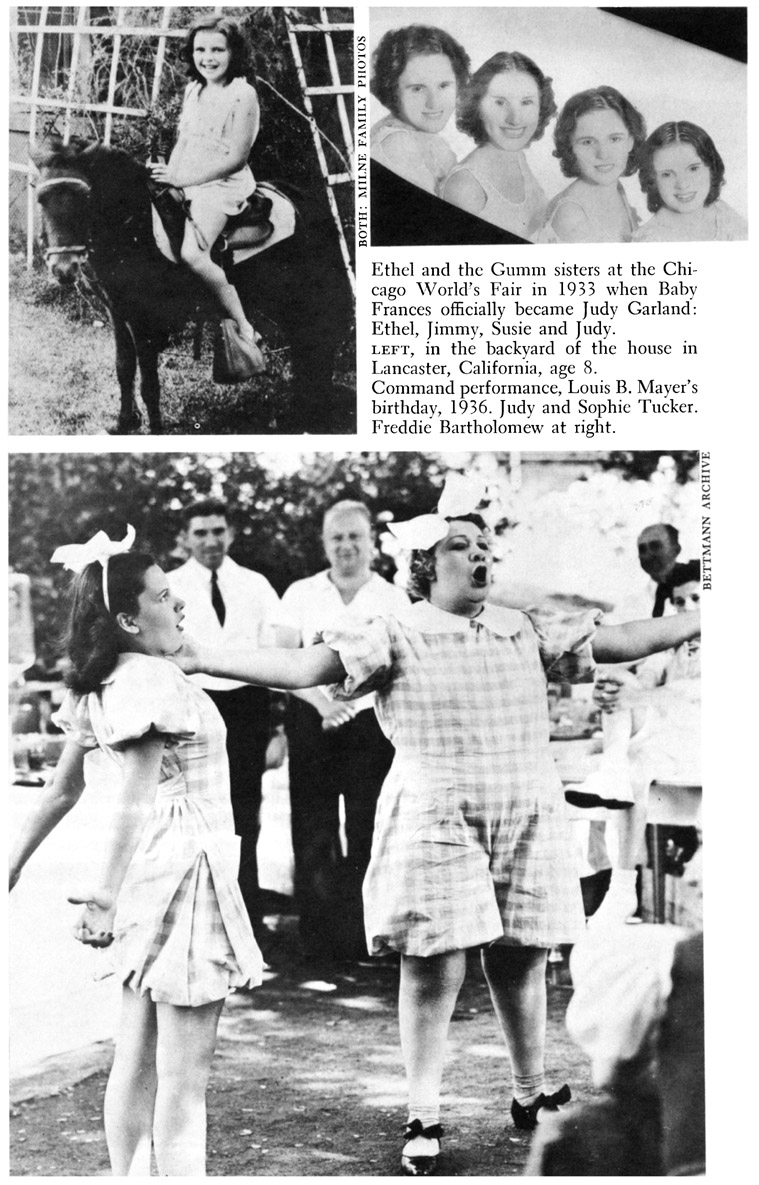
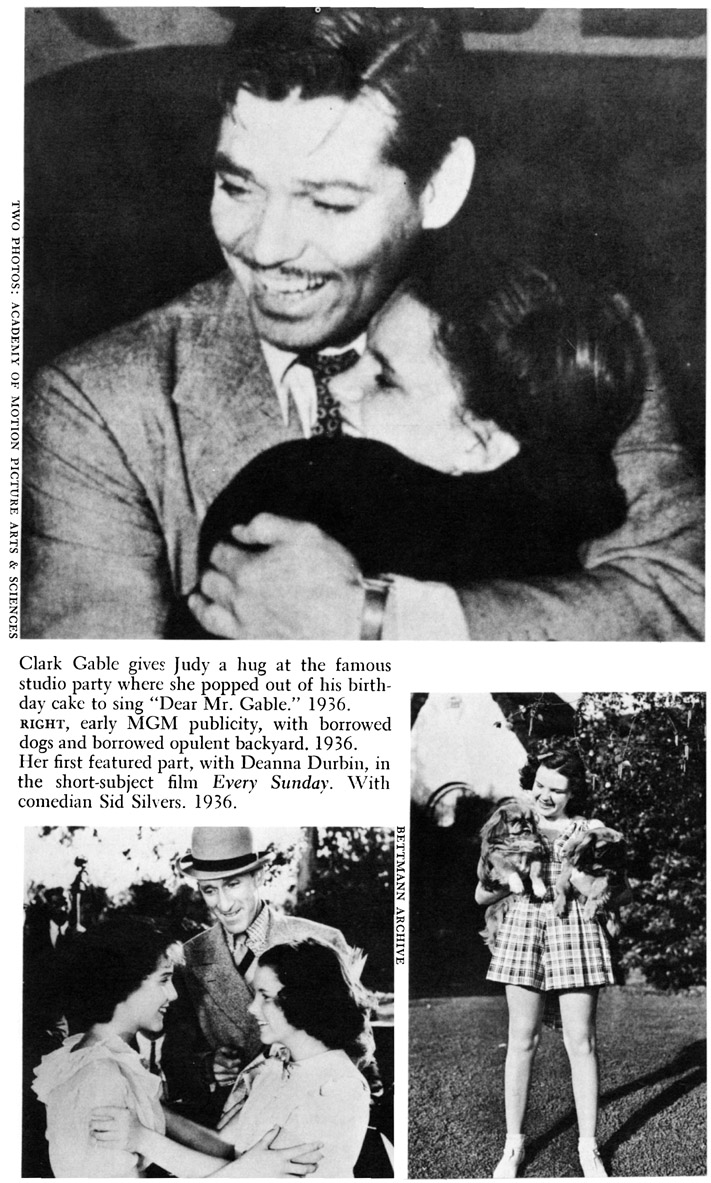
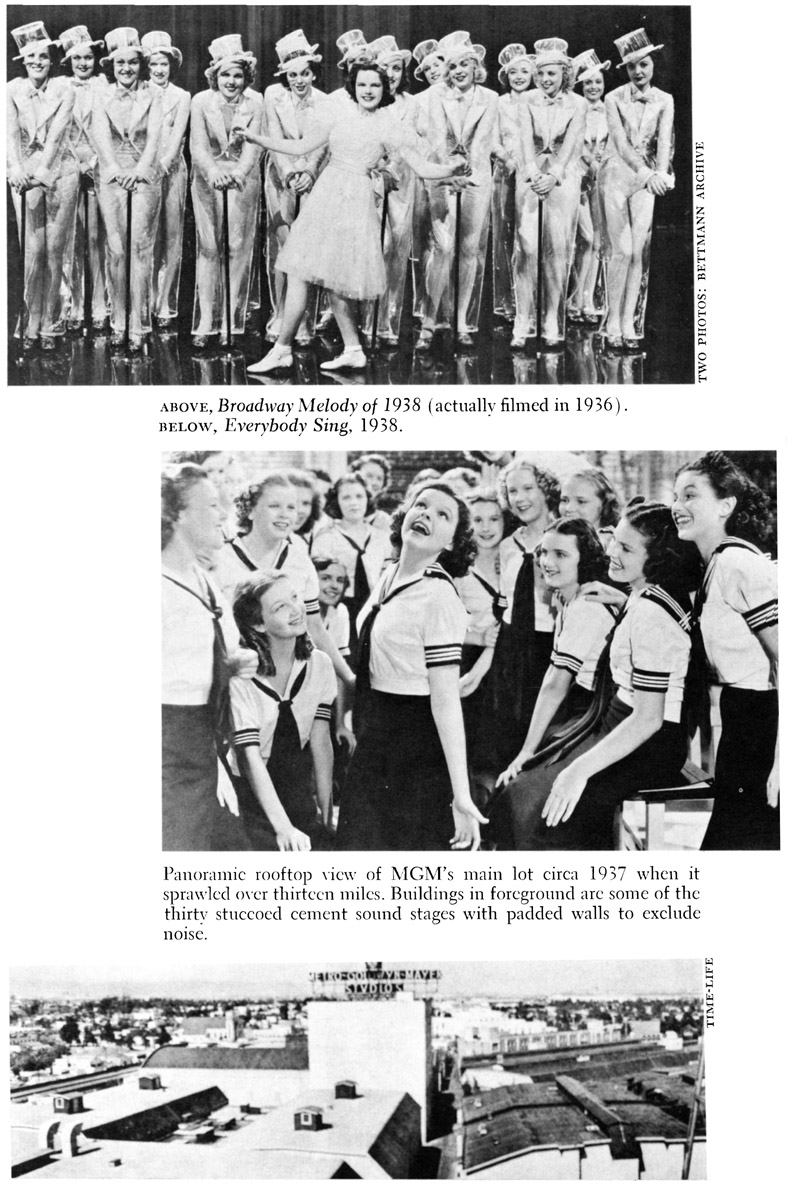
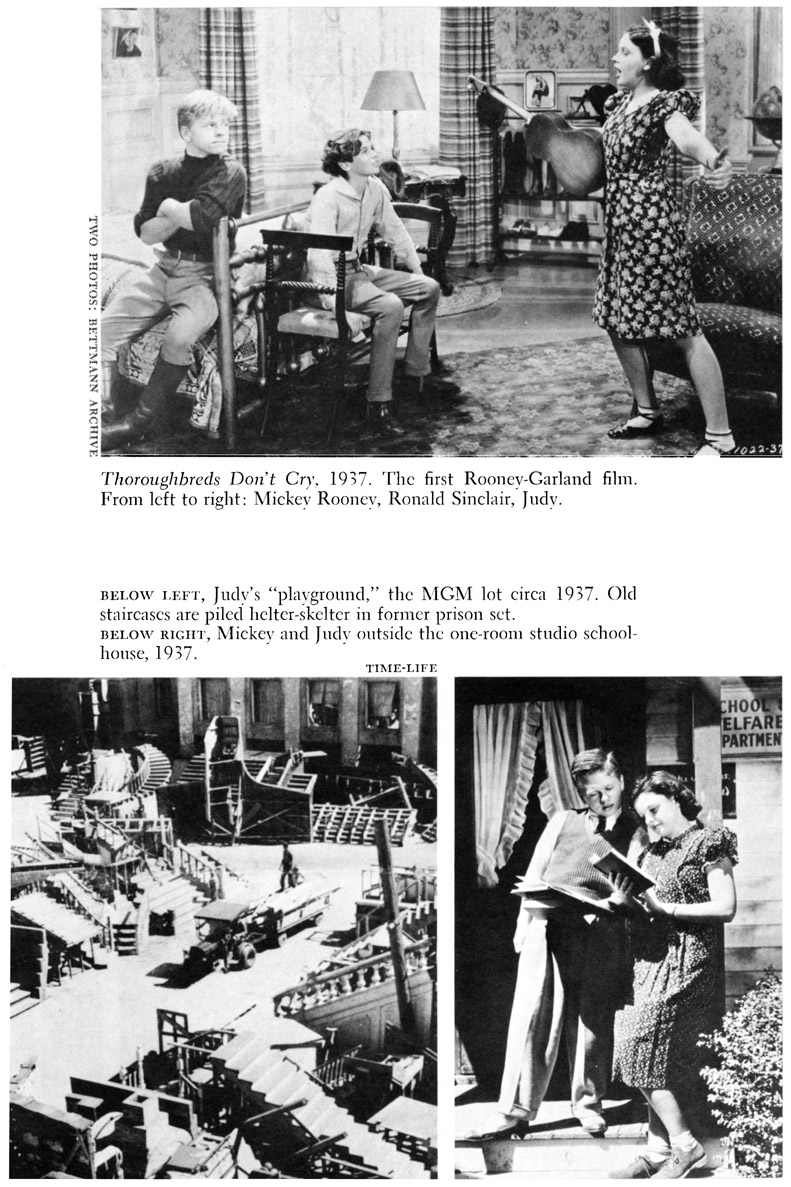
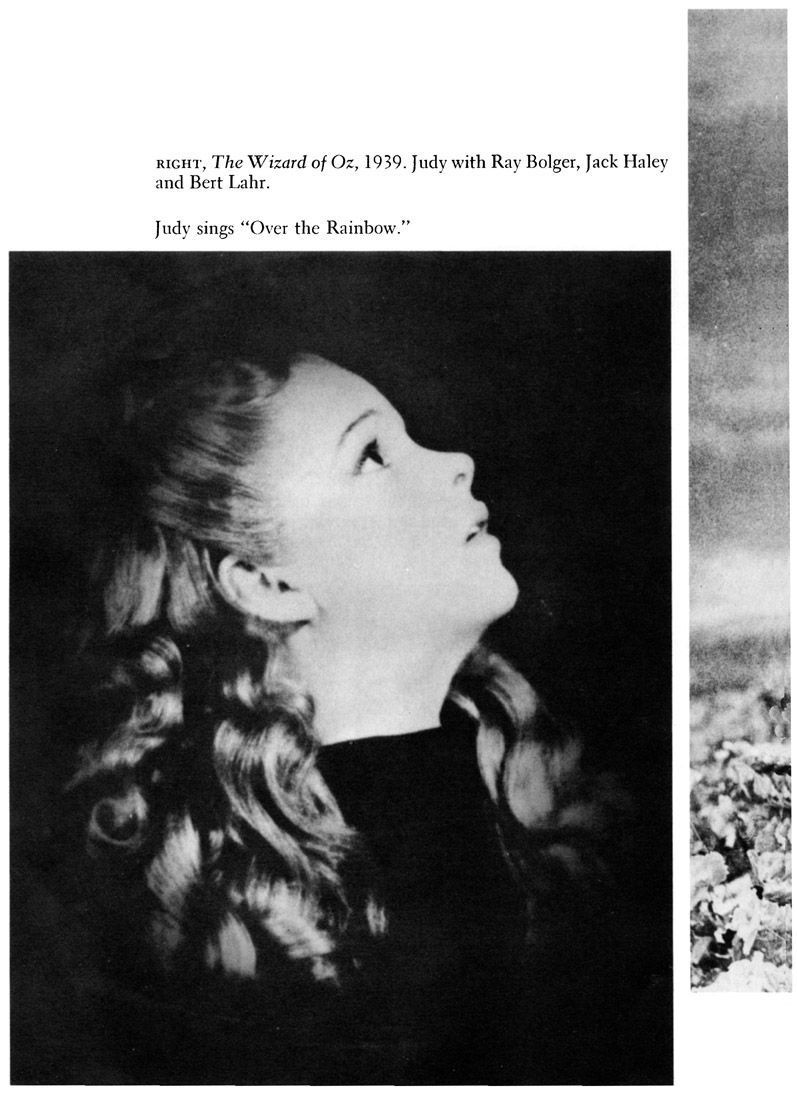
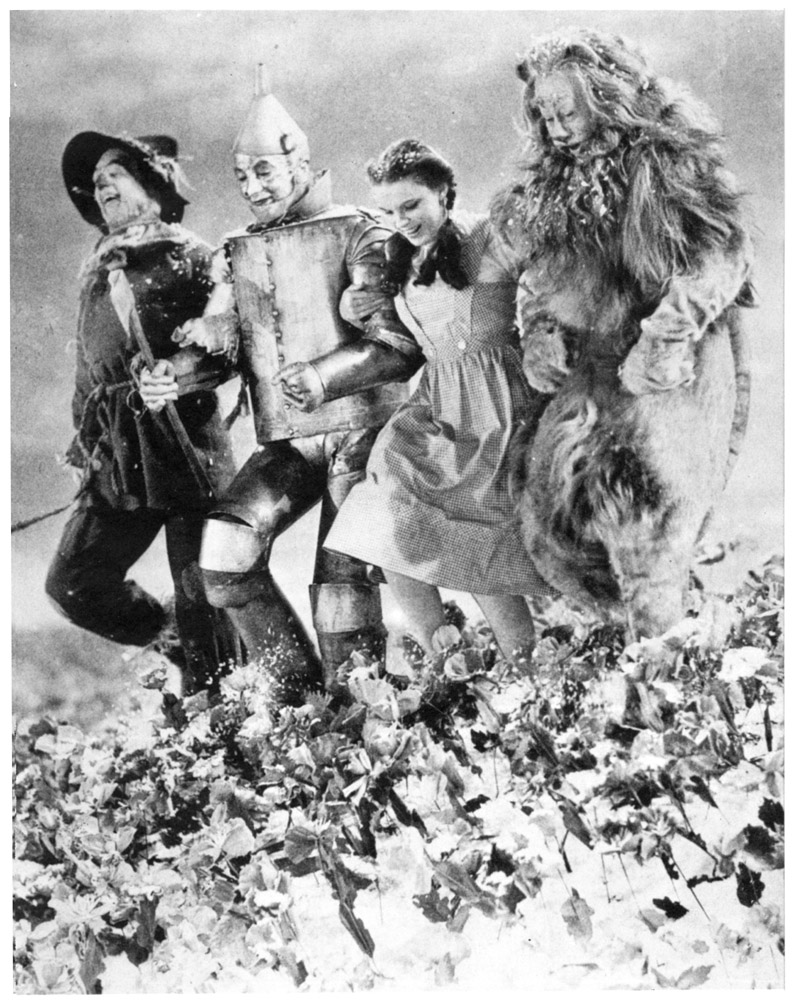
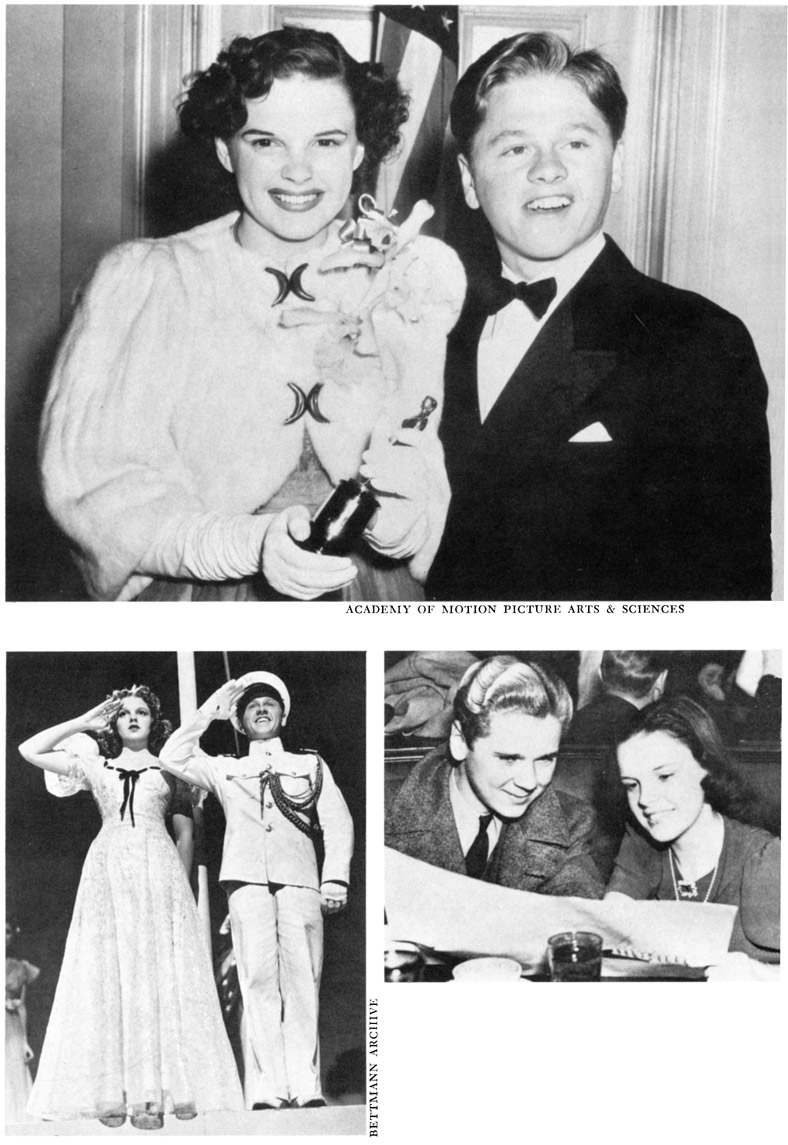
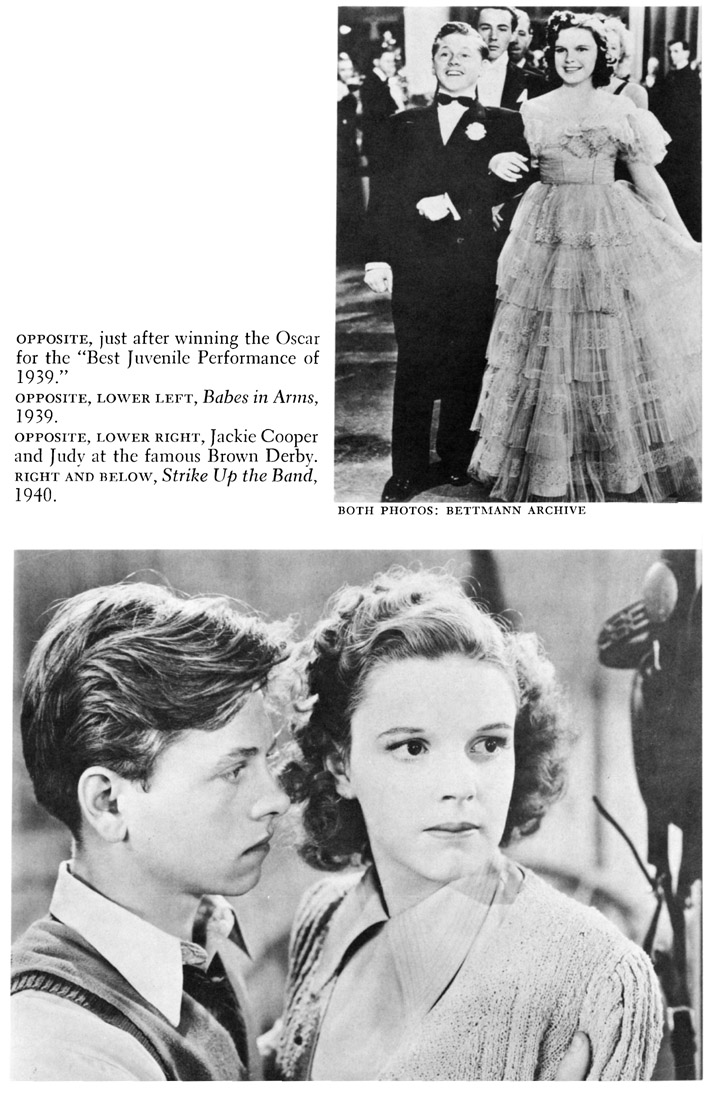
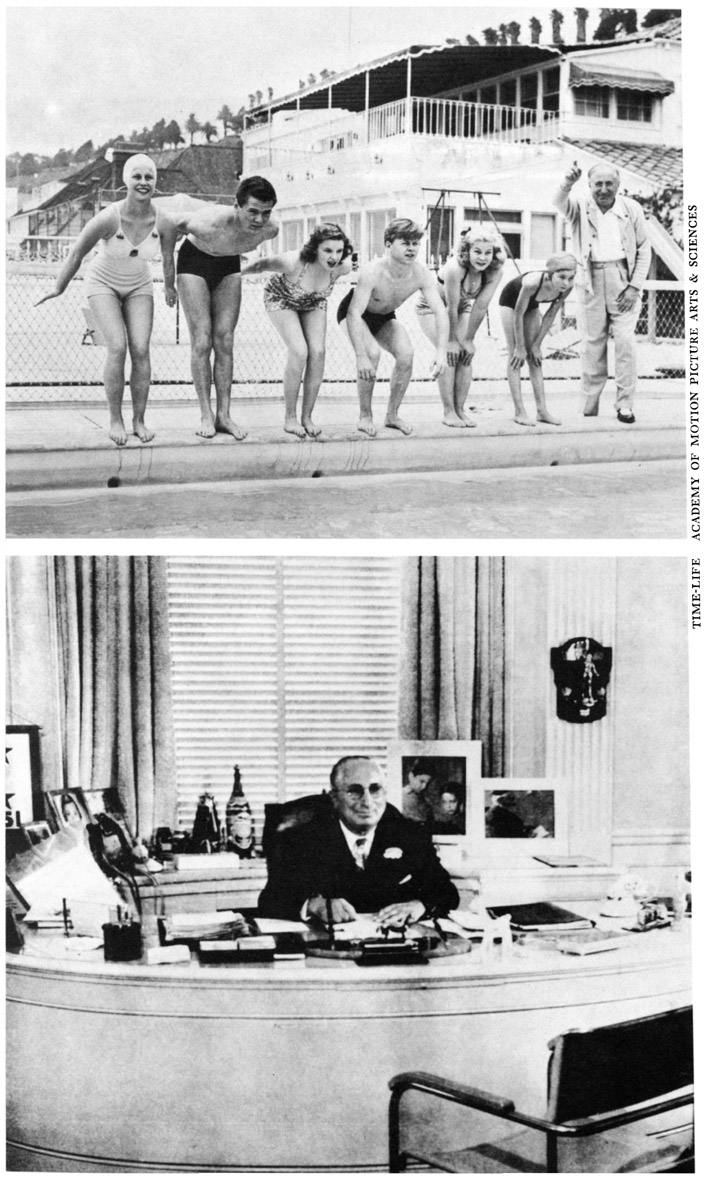
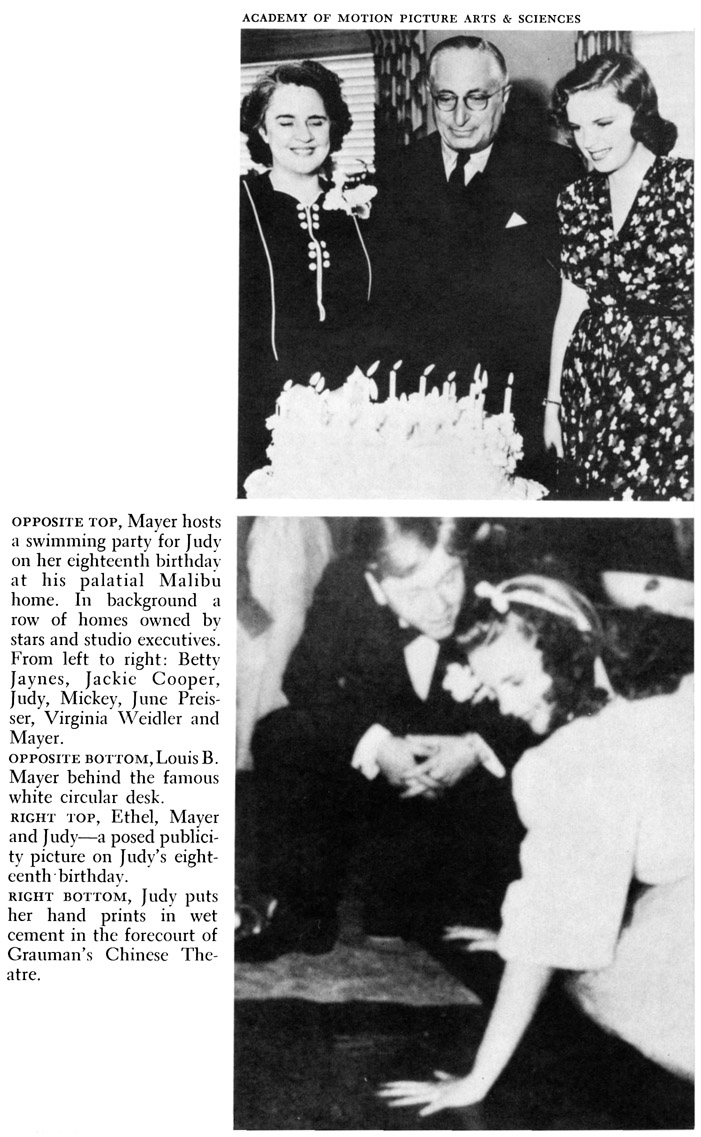
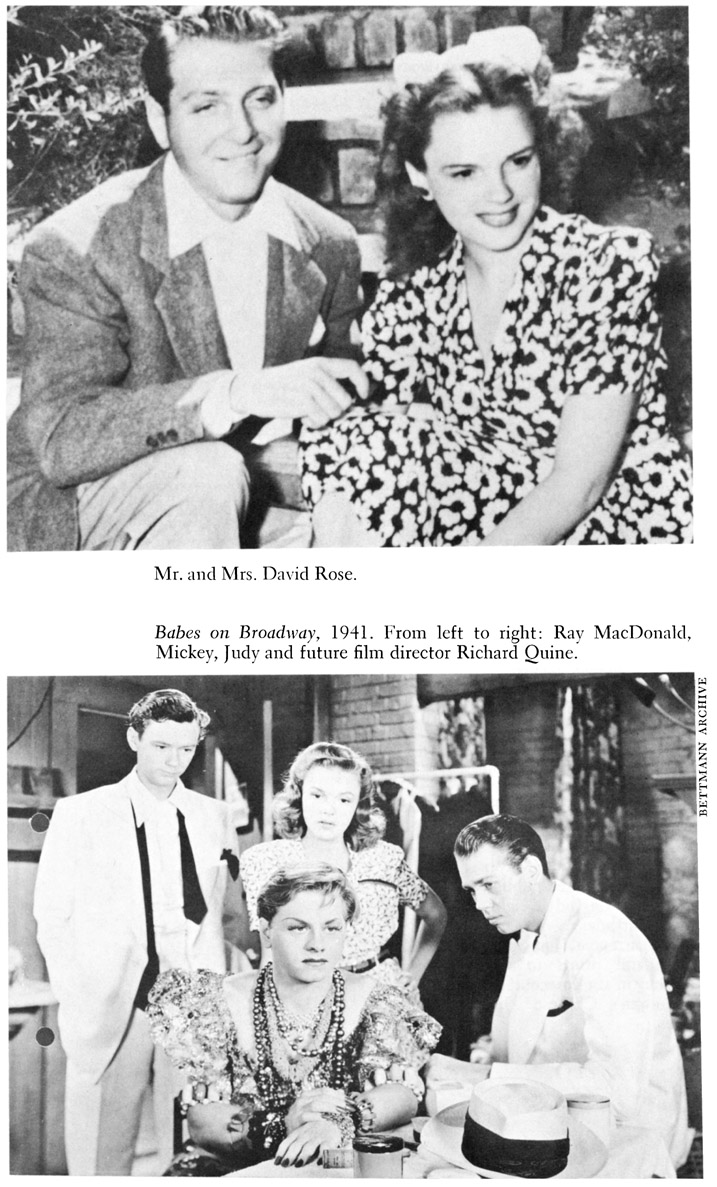
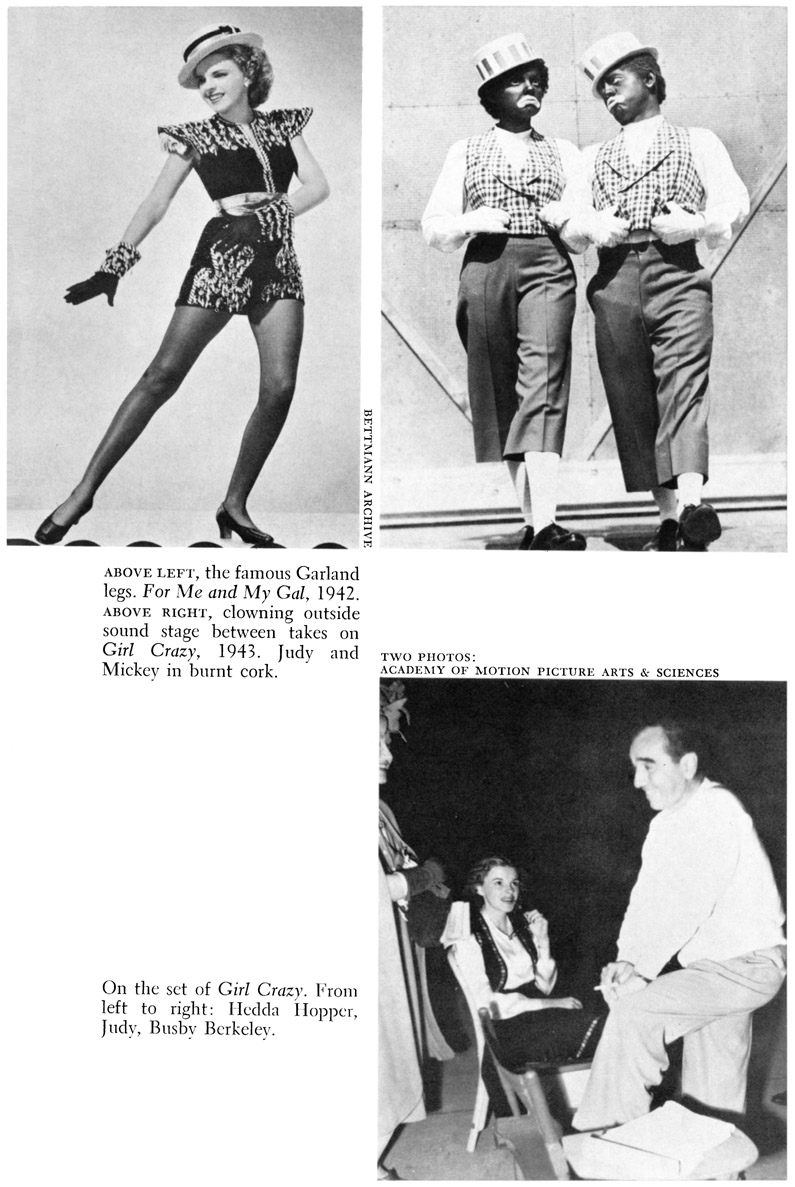
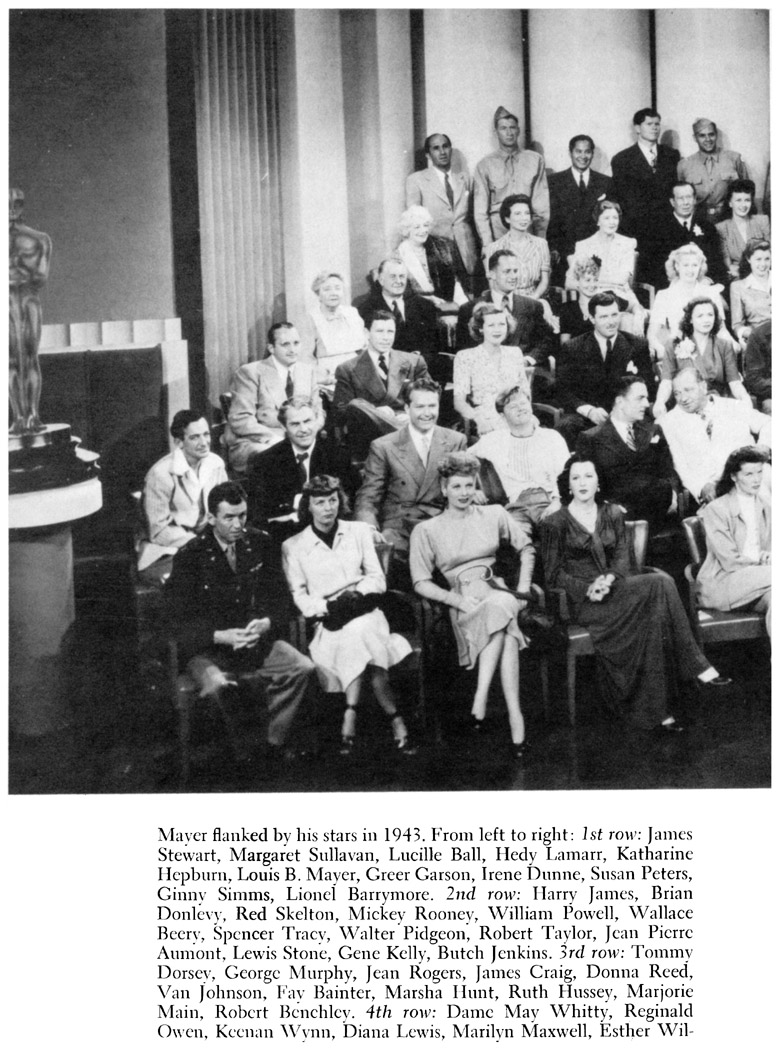
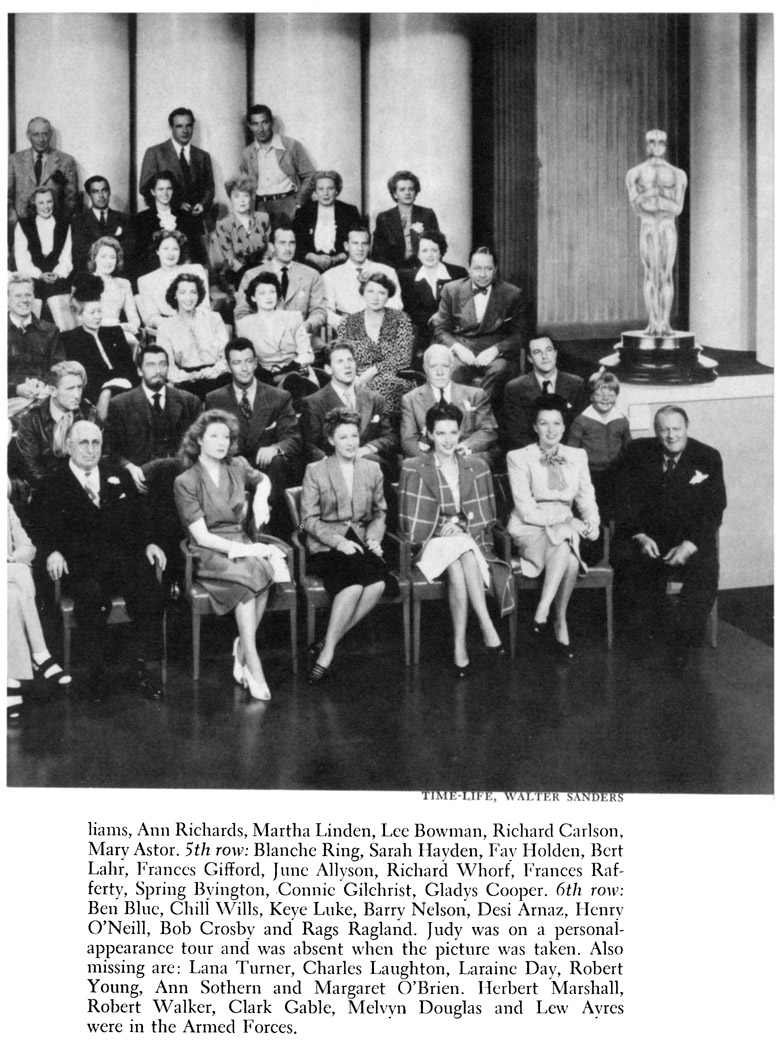
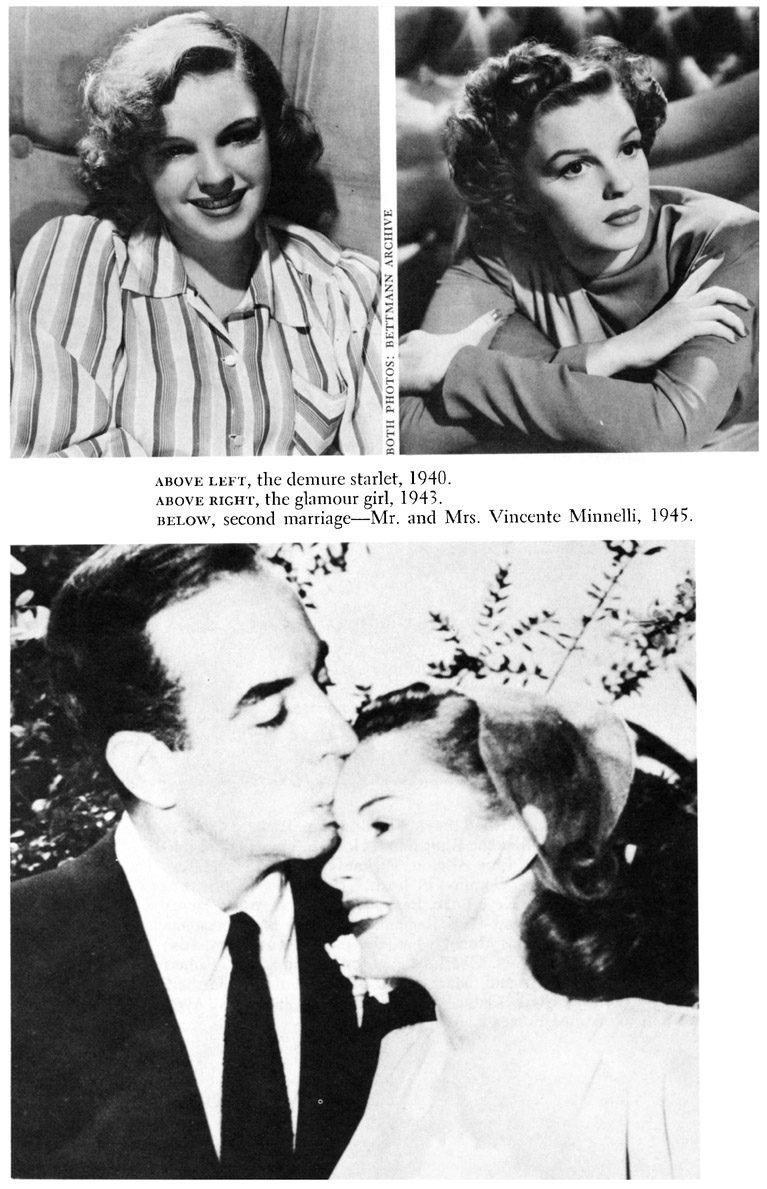
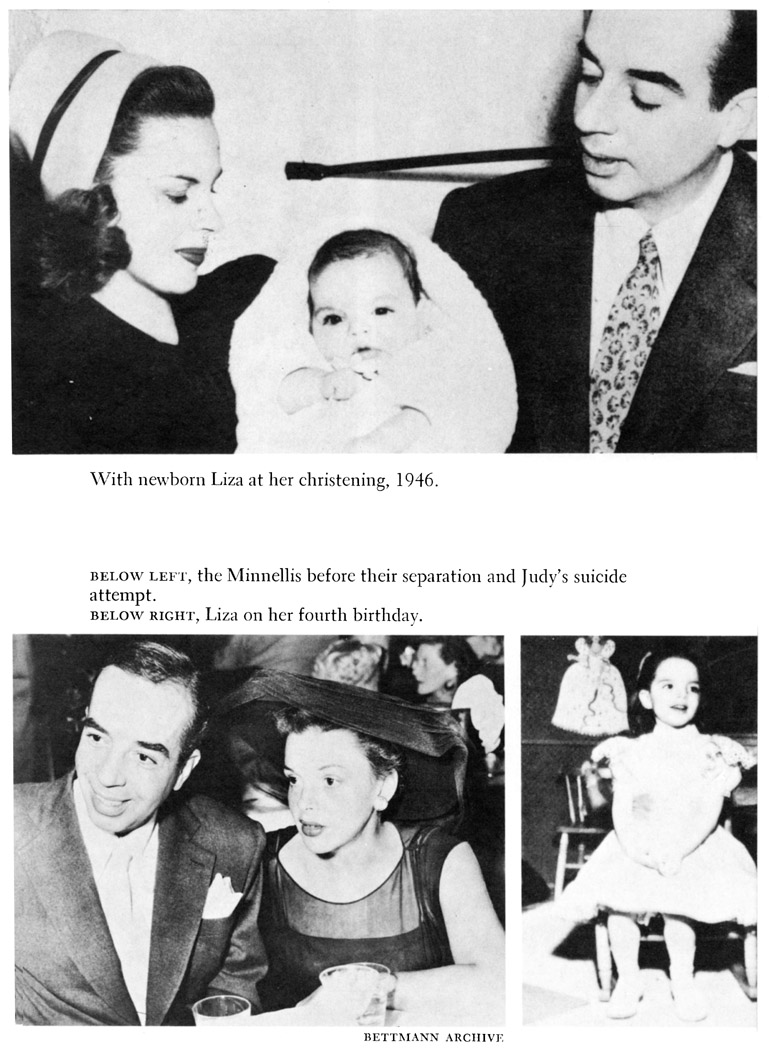
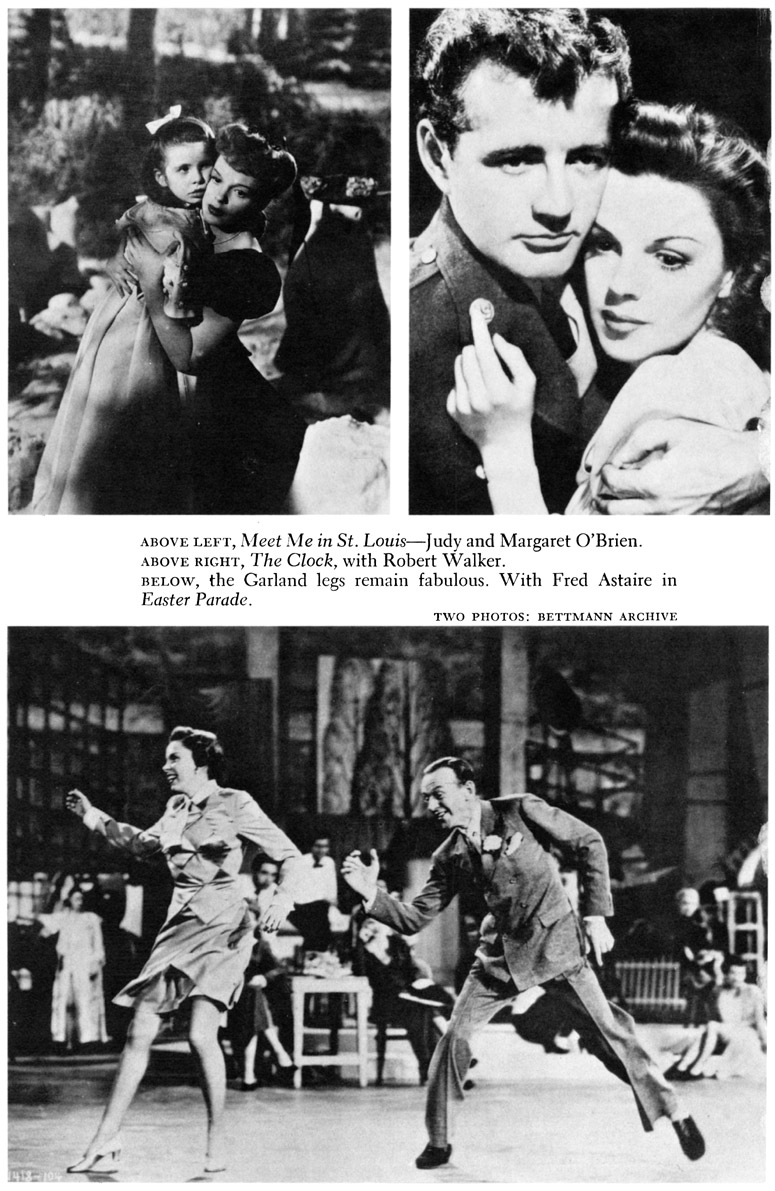
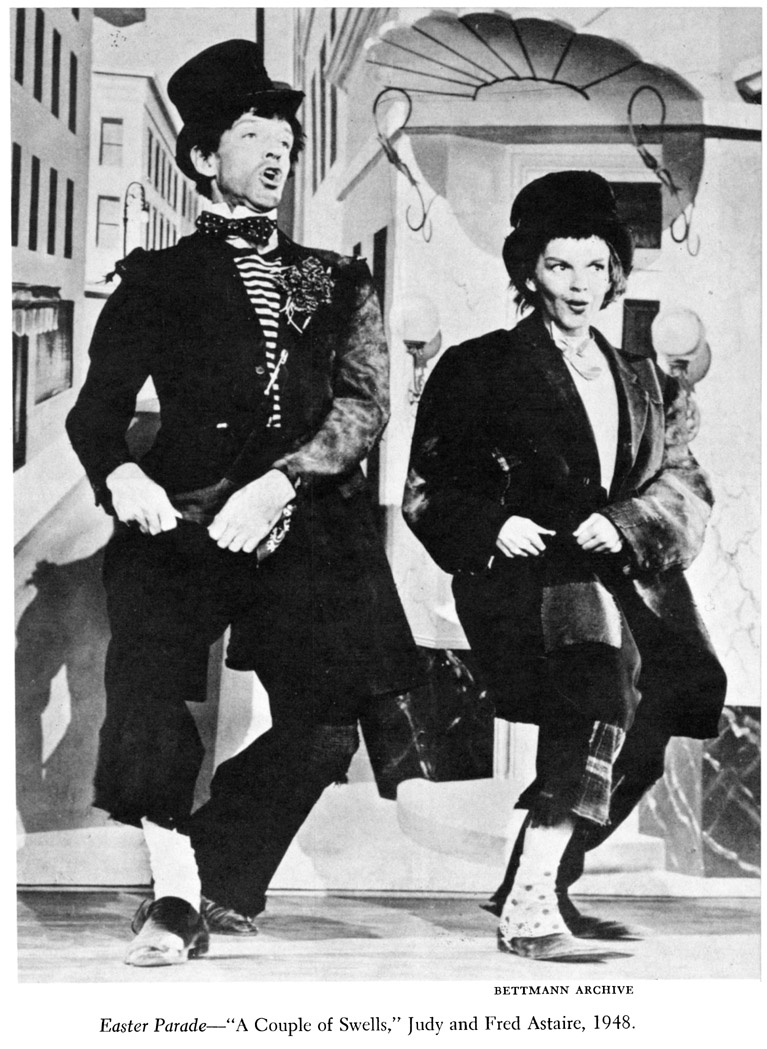
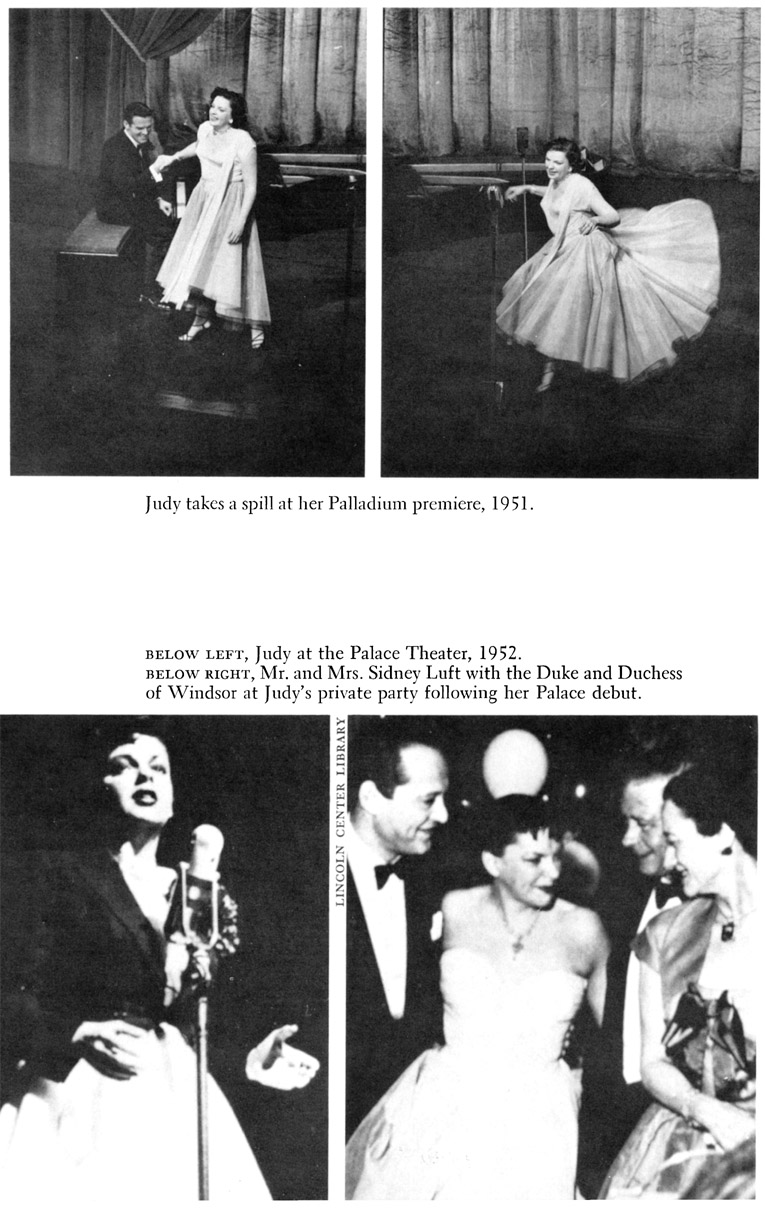
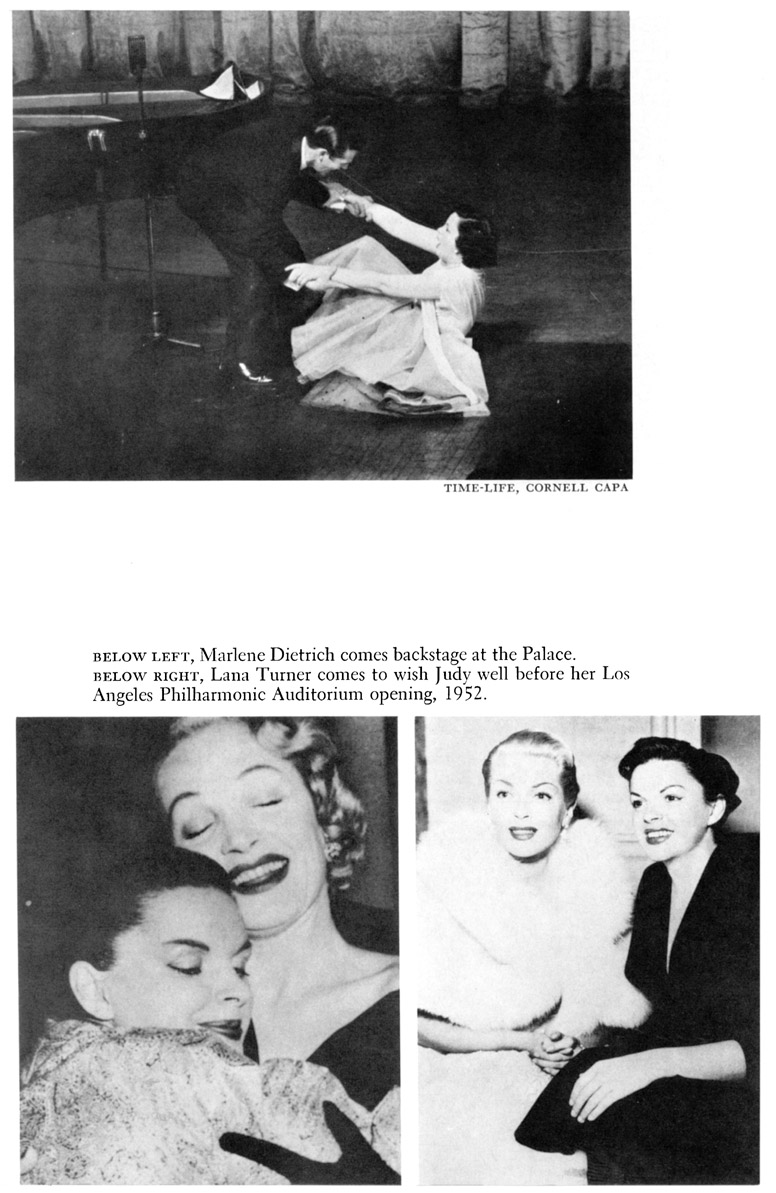
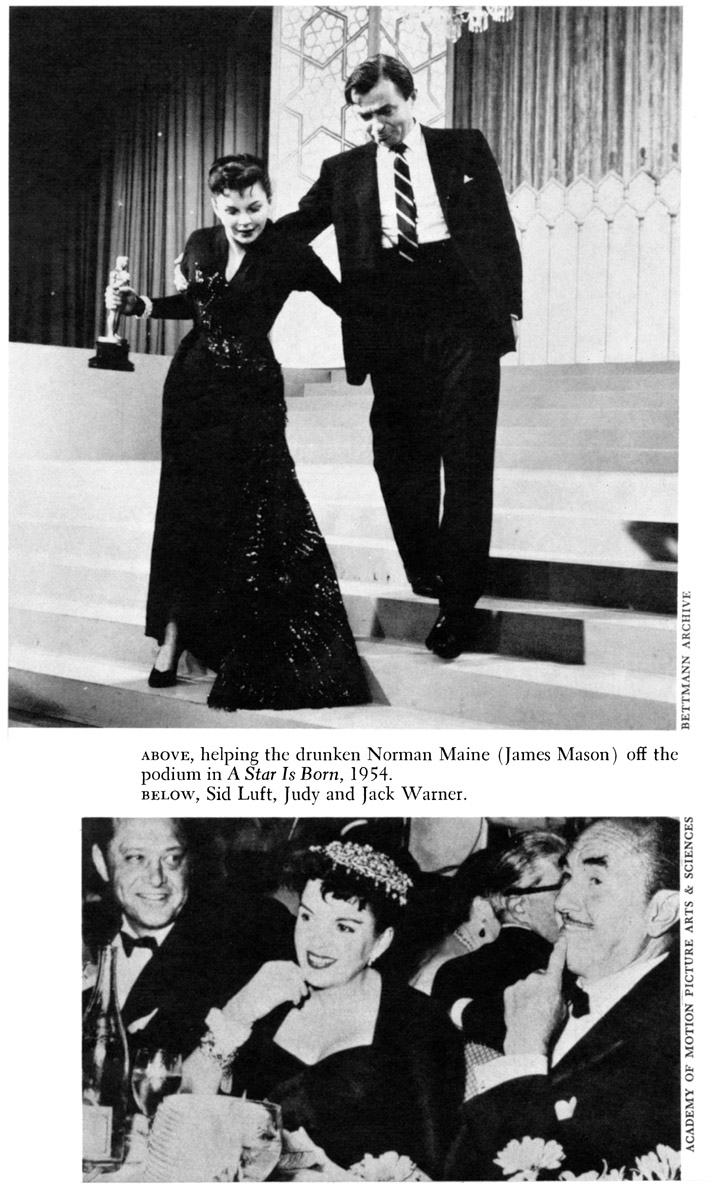
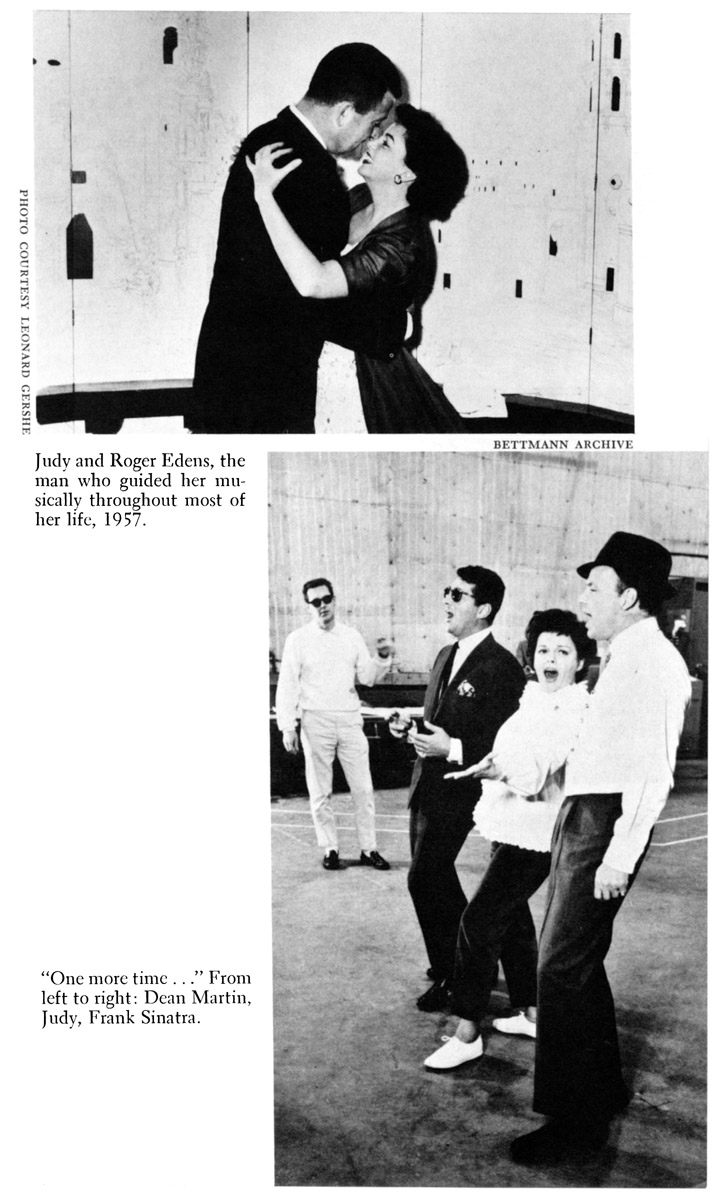
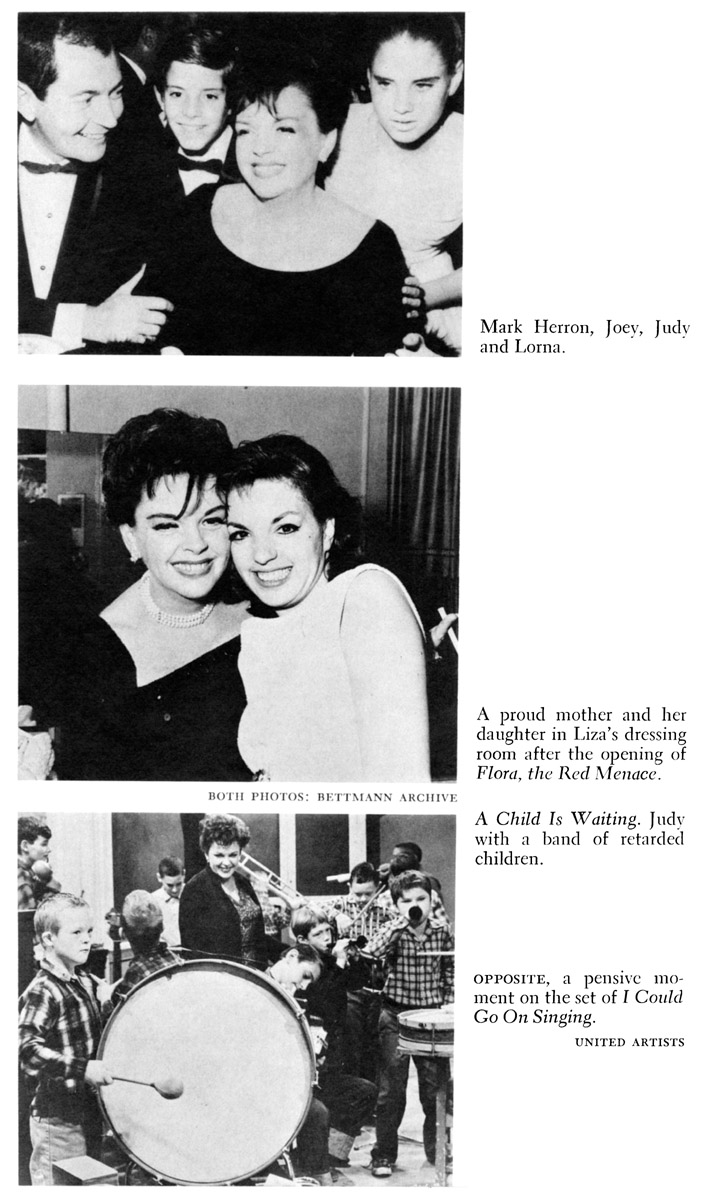

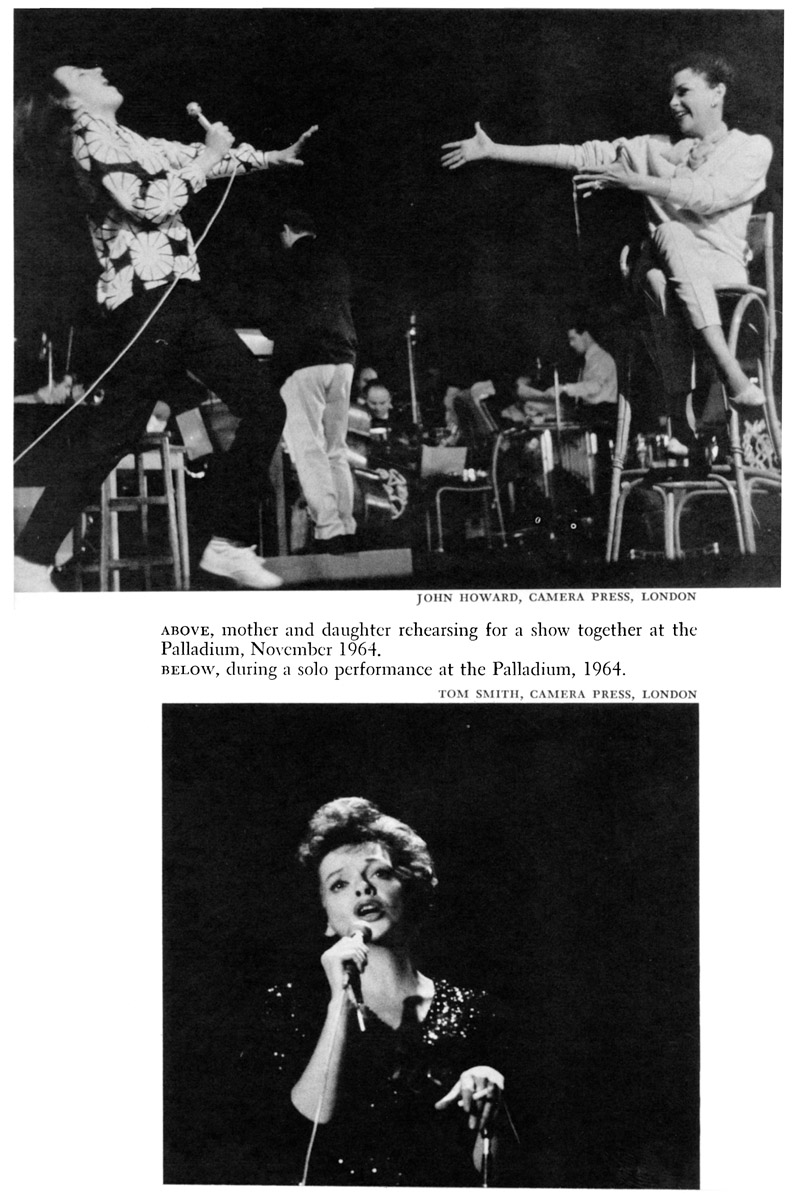
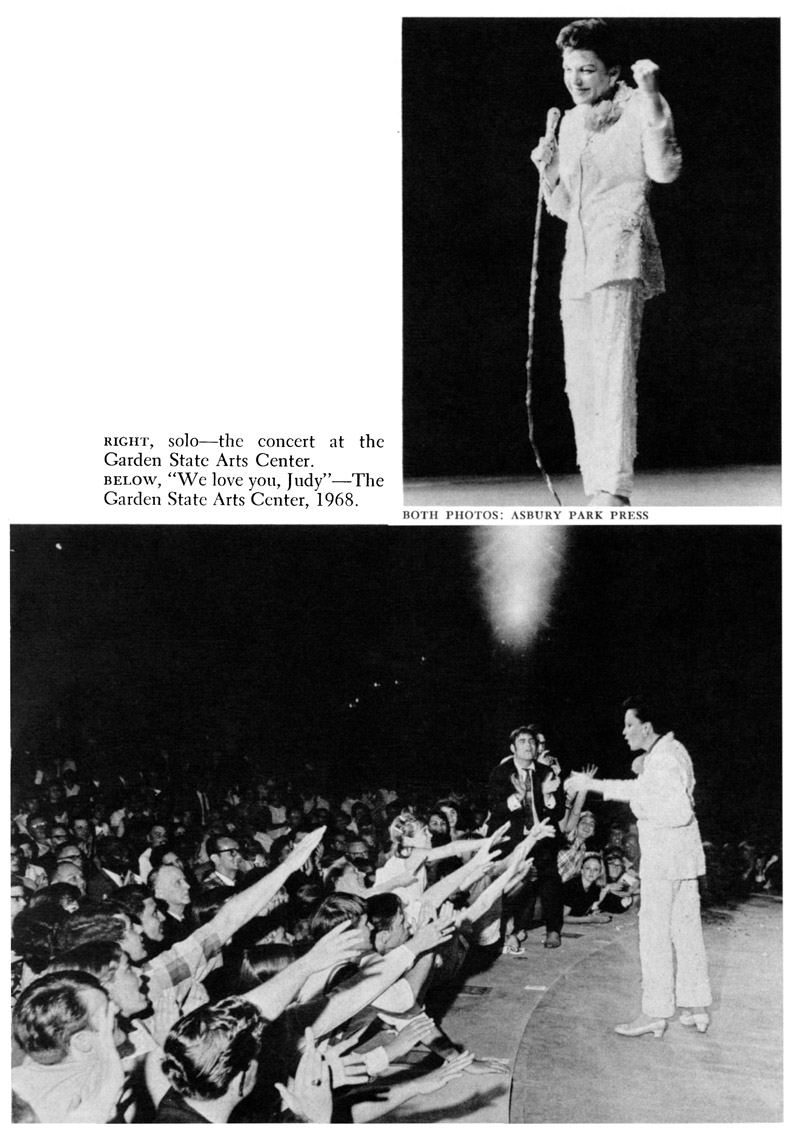
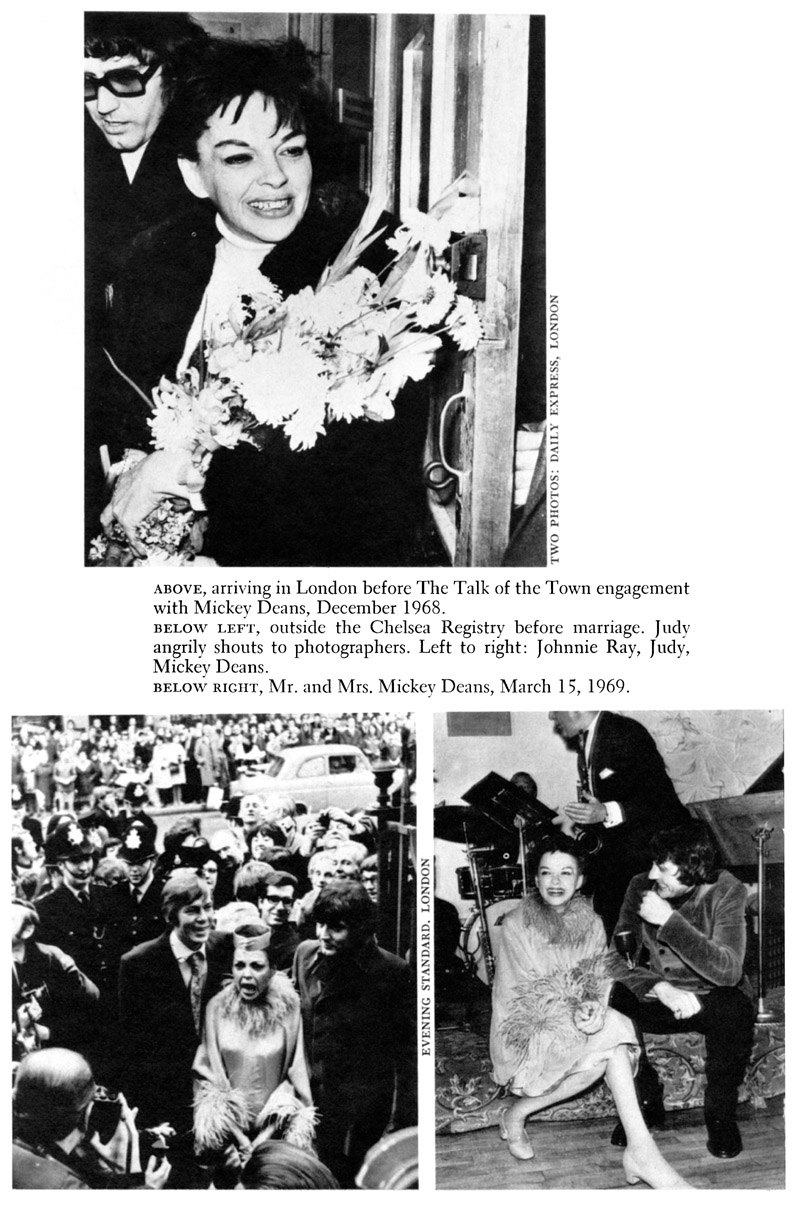
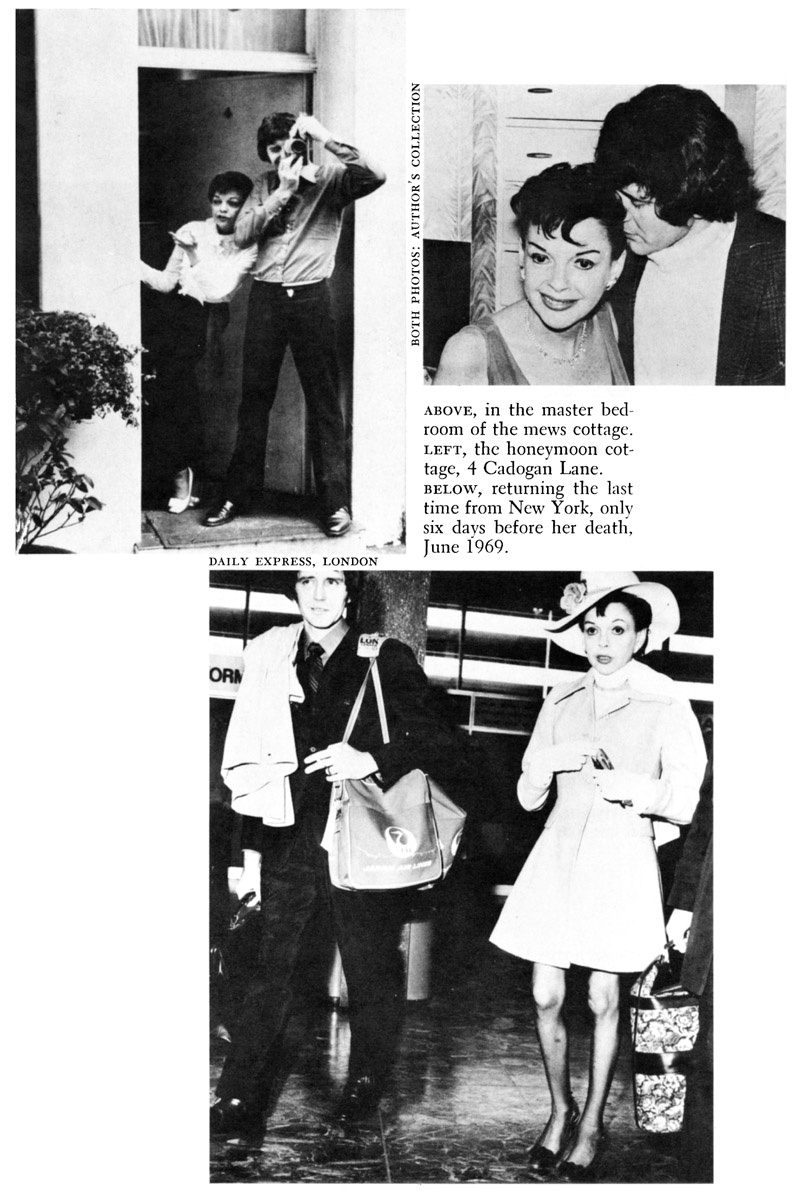
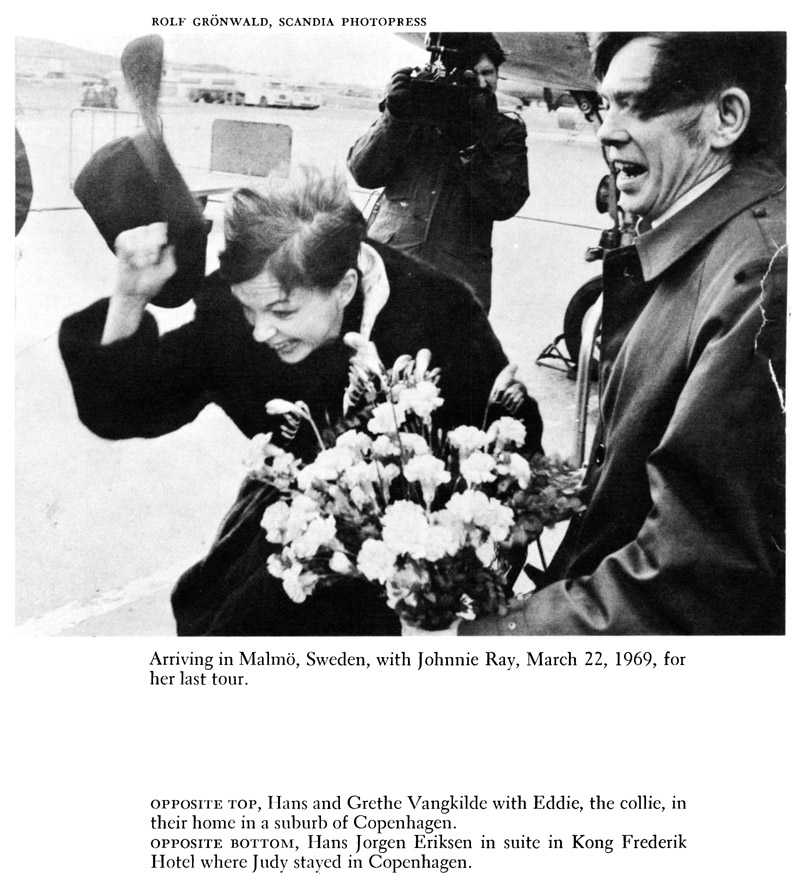
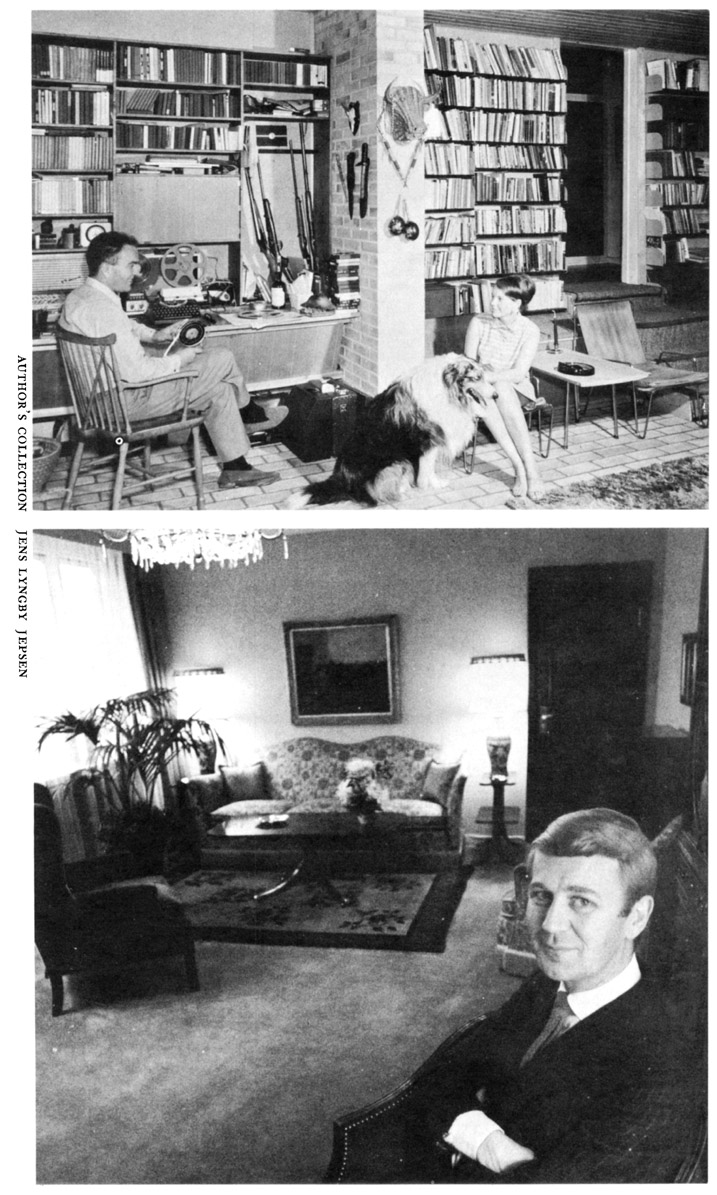
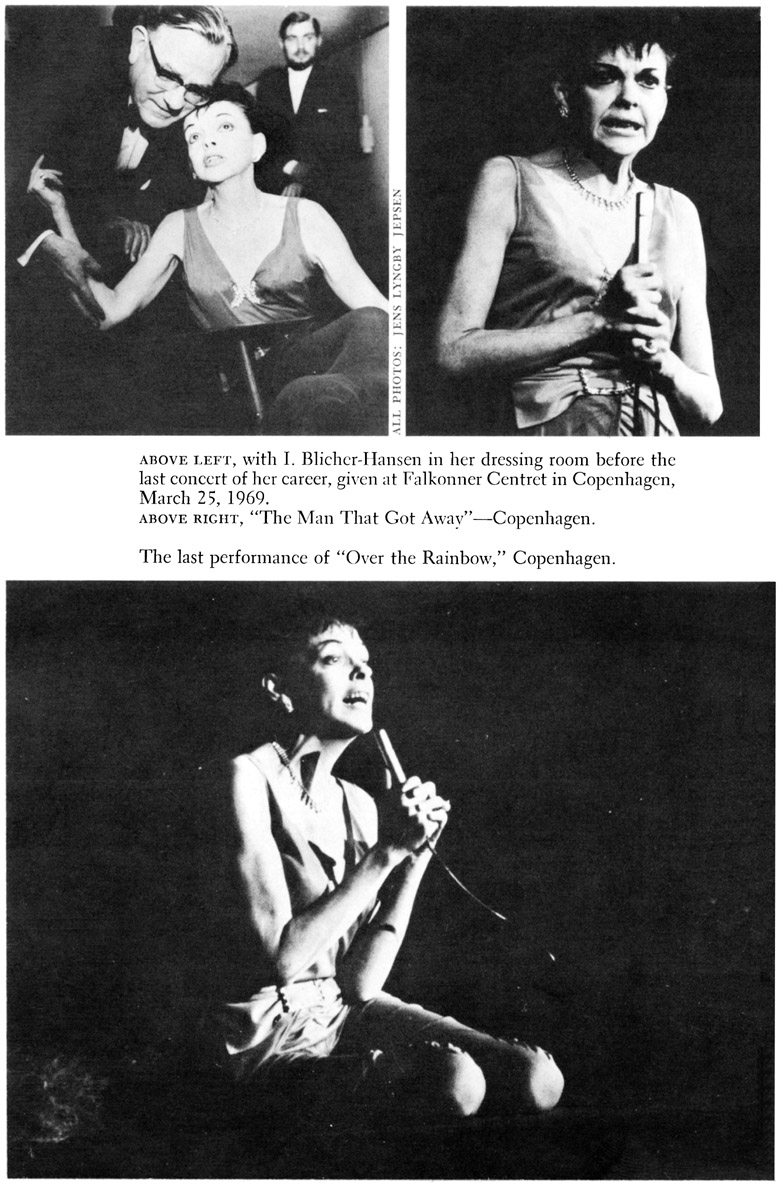
And he succeeded, for in July—nine weeks later—he booked her for a seven-city West Coast tour. In each city she thought she might not make it through her performance, but she did. In San Diego, during one of her best shows, she asked her audience, “Do you think this kind of figure will ever come back?” She was once again as heavy as she had been four years before at the Palladium; and though she was both starving herself and relying heavily on diet pills, she could not lose weight.
Before the end of the summer and without a respite, Luft booked her into the New Frontier at Las Vegas for her nightclub debut. She sang for forty minutes straight out of the sixty-eight-minute show and broke all the New Frontier’s existing records. Then on September 24, 1955, she entered television with a Ford Star Jubilee one-and-one-half hour spectacular. Ostensibly the show was a replay of her Palace performance. She was under pressure, not well, and exhausted. Still she was what The New York Times called “tremendously appealing,” and in the view of the Journal-American she was also “the greatest natural talent in show business.” The show was a success, but Judy was once again near collapse. To add to her tension the Government had swooped in, claiming most of her large earnings for the year yet, because of interest and taxes, still leaving her with a debt close to $300,000. What remained of the salary she was permitted to keep got hacked away by staff expenses, travel expenses, and Luft’s sizable percentage.
At home there were the three children—Liza, nine; Lorna, not yet three; and Joey, five months. Judy desperately wanted to remain at home and be a mother. But the acrimony between her and Luft grew more intense each month. She claimed his gambling was throwing the family into severe jeopardy, and he countered that her inability to work was responsible. “We were losing our ability to communicate with each other,” Judy has said of that period. “I had learned how to handle audiences again, how to be an entertainer. But I didn’t seem to be learning much from my marriage.”
For the next few years Judy and Luft were to part, file suit for divorce, and then dismiss the suit again and again. The first time was on February 4, 1956, just three and a half years after they were married. Three days later they were reunited.
This was a period in which Judy claimed Luft was violent. Peter Lawford tells the story of being called over to her house late at night by a hysterical Judy and arriving there to find her with small jagged cuts all over her face which she insinuated Luft had inflicted and which in privacy the maid confided that Judy had inflicted on herself.
Whether Judy or the maid spoke the truth, on March 4, 1958, Judy again filed suit for divorce—this time charging that Luft “has beaten and attempted to strangle the plaintiff on many occasions, the last occasion being on February 21, 1958.”
Directly after this—on March 25 of that year—a tax warrant was filed against her by the New York State Tax Commission. And on April 3, a warrant was issued for her arrest for failure to pay $8,000 New York State tax on income earned in 1952 at the Palace which Luft had never paid. She had to hand over to the court, for bond, personal jewelry and her costumes. The press made much of the matter.
The “Marie Torre incident” followed. Miss Torre was television columnist for the New York Herald Tribune at the time of the “incident” and in an article quoted an unidentified Columbia Broadcasting System executive as saying that Judy “is known for a highly developed inferiority complex.” Judy sued for over a million dollars, and Marie Torre was ordered by the judge to reveal her source. It was a test case. Miss Torre refused to do so and was sent to prison for ten days for contempt of court. It did not make Judy any more popular with the American press.
It was understandable that she suffered a great fear of insecurity along with all her other phobias. There were literally dozens of reasons for this, but the most basic at the time was her terrible indebtedness when she had earned so much money and her suspicion that Luft was riding the Garland bandwagon like everyone else in her life had and that he did not truly love her. As always, she blamed herself. She was fat and ugly, and she was not able to perform. The Ethel-Mayer self-recrimination pattern was reset into motion. It was a year after her first television appearance—a year of marital strife, self-loathing, and growing dependence once again on pills—before she was to make a major public appearance again.
In September, 1956, for the second time, she played an engagement at the Palace. As she entered her old dressing room, she was overcome by the shiny gold plaque that hung over the door: THIS WAS THE DRESSING ROOM OF JUDY GARLAND WHO SET THE ALL-TIME LONG-RUN RECORD, OCTOBER 16, 1951-FEBRUARY 24, 1952. R.K.O. PALACE THEATRE. Her appearance, as received by critics, was not so triumphant as her previous engagement. She seemed to lack the naturalness she had had before. Her weight certainly slowed her movements, but there was something mechanical in her performance that all the critics called attention to.
This point in her life also saw the phenomenal rise of The Garland Cult. It had begun years before. There had been followers like Wayne Martin—lonely people who worshiped her in the privacy of their homes; fans; collectors—but the slavish devotion of what was to become the full phenomenon of The Garland Cult did not swing into frenetic motion until the mid-fifties.
For a complete understanding of Judy and the Garland Cult, this period in her life supplies the most valuable clues. For years she had suffered pill addiction, insomnia, multiple neuroses, pressures, tensions, armies of creditors, ill health, traumatic relationships, and lost illusions. Her personal fears were at a peak, and she had fallen prey to such acute stage fright that Luft had to push her out onto the stage to perform. She did not perspire, according to her own words, but sweated so profusely during a concert that the costume changes were a necessity; and even so, when she came offstage, her body odor was so gamy that stagehands often visibly backed off. She would drench herself in Joy perfume, its pungent sweetness often causing fits of nausea right in the middle of a performance. Compounding all these horrors was the new fear plaguing her that her voice would go. There were times when it would crack or slip away during a performance. She was never sure when she could depend solidly on it. No longer the wide-eyed, dreamy Dorothy of The Wizard of Oz, she was now a woman who had been through it all and knew what it was about. Yet no matter how great the indignities she suffered offstage, onstage she exuded a sense, a feeling of dignity even in her lowest, her worst moments of performance.
It was this last that might be called her magic quotient—the ingredient that whipped her audiences into a frenzy and had such a hypnotic effect upon them. Judy appeared to be super-strong, able to endure superhuman trials. That was why when she was good, audiences went wild; why Luft and her musical arrangers made her test herself in each performance, allowing her no respite once she was onstage, setting her keys so that end notes were tough to reach; why with each concert her production was staged more and more with an eye to playing up this magic quotient; why, in the end, she made her entrance very often from the back of the audience, looking small, ill fitted, and proceeded down the aisle to stand alone on a huge, barren stage, one small light picking her out, clinging to a microphone as though it were her only connection to life. This was the image that the Garland Cult was dedicated to. Audiences reacted, were mesmerized and frenzied alternately. When those high notes at the end of a song seemed out of reach, they would pray softly, “Please, please make it!” If she did, they would cheer wildly; and if she did not, they would still cheer wildly to let her know they knew she could and would next time.
Jerry Lewis once said it very well:
People now know the troubles Judy has been through. Who among us isn’t plagued with troubles too? So people of all kinds, with worries and problems and heartaches, go to see her; and they identify with her. And when she sings, she is communicating for them all the emotions they can’t communicate themselves because they don’t have a stage and a microphone and talent. The stout women in the audience identify with her; and the people who remember their own unhappy childhoods identify with her. All the people whose in-sides have been torn out by misery identify with her, and she is singing for all of them. In a way, she’s singing with a hundred voices.
There were a lot of concerts in the years between 1956 and 1959 and too many ups and downs to even recount, but the press diligently did so, dogging her heels and rehashing the old sordid stories whenever they related any new crisis in her life. Seldom was a review of a performance printed in which her personal tragedies and problems weren’t dragged in, and always it referred to her as being “on the comeback trail.” During all this time her marriage to Luft had become a series of psychotic actions and reactions. She could not live with him and she could not live without him. Luft certainly did everything possible to achieve the latter, for he had set himself up in control of her finances, her career, her health.
On October 29, 1958, Louis B. Mayer died at the age of seventy-two of acute anemia. That previous July he had embarked upon a fight to regain a voice in the operation of MGM—or Loew’s, Incorporated, of which MGM was now a production arm. Mayer had joined with millionaire Canadian road builder Joseph Tomlinson, a Loew’s director, and the two men had initiated what was termed the Mayer-Tomlinson Scheme to obtain control of the company. Court fights had followed, but Mayer was terminally ill and could not conduct the final battle. Richard Nixon, then Vice President, made a public announcement of sympathy at Mayer’s passing: “I was among those fortunate enough to be a close, personal friend to him,” he began; then told of Mayer’s genius. Mayer’s death deeply affected Judy. She slipped into a period of depression. The past must have come flooding back to her then; and much of it was hard to face, painful to recall, difficult to bury.
For New Year’s 1958, she returned to Las Vegas, appearing at the Flamingo Hotel. It was a drunk and celebrating audience, and she wasn’t at her best. After she had struggled through five numbers performed in a jam-packed, smoke-filled room, having to compete with a noise level that forced her to overreach for her notes, a woman screamed out from the audience: “Get outta here. You’re too overweight and we don’t want to hear you anyway!” Then two women climbed over the footlights and began to dance. Judy walked offstage—and into another lawsuit for breach of contract. Luft declared he would never allow her to appear in a nightclub again.
Finally in 1959 he chose the massive Metropolitan Opera House for a concert, and after that the Chicago and San Francisco opera houses. It would seem he did so simply because they were the largest houses available. By fall her voice suddenly deserted her, and her body swelled up monstrously. Suffering severe pain, she was rushed to New York’s Doctors Hospital. The doctors there believed she had hepatitis. She remained there in crisis and under treatment several weeks. She came very close to death. Luft took a room at the hospital to be close to her. The doctors confided in him that Judy might not be able to perform again.
It is difficult to know what went through Luft’s head at that time. Judy gave out a number of interviews in which she asserted that the doctors’ proclamation rather pleased her and that she was looking forward to retirement. However, in their circumstances at the time, retirement would not have been what Judy fantasized. They were several hundred thousand dollars in debt with no assets or capital, and at no time in their marriage had Luft proved he could support the family—certainly not in the style they both enjoyed! He must have been fairly frantic with concern, especially when her condition worsened before it got better. Getting her to agree, he came up with the money-making idea of Judy’s writing her autobiography (with a ghostwriter).
Always a good promoter, he left Judy in a very weakened condition at the hospital and went to see Bennett Cerf at Random House, whereupon he talked Cerf into agreeing to advance him $35,000 against a signature by Judy on a contract to cooperate fully in the writing of her autobiography. Luft then convinced Judy she should sign, but as her health improved, she had a change of heart.
Upon her release from the hospital, they returned to Los Angeles and the heavily mortgaged home in Holmby Hills. Judy, semi-invalided, was forced to remain inactive for over four months. Once again she gained heavily, tipping the scales at one hundred fifty pounds. She had a few sessions with a ghostwriter, but now felt her signature had been obtained under undue duress and refused to complete the interviews. But, shockingly, the money from the advance was gone. Random House did not take a complete loss on the $35,000, as the interviews were turned into a two-part article, sold by Cerf to McCall’s.
Judy was in a severe state of depression and hating Los Angeles. There were constant unpleasant articles about her, and she was always being deluged by bill collectors and creditors and pressed for money that she did not have. Recalling her happiness in England and the kindness of the British press, she decided she would like to return there. Luft and the three children accompanied her. Her fans—who had now reached cult proportions—rose up en masse on both sides of the Atlantic. For the first time they became truly active, physical, seen. Her ability to return to the stage after her serious illness and ill fortune, their own desperate need to see and hear her, was paramount—the only thing in their minds. Her life became theirs, her suffering their own; and in this transference her failure to overcome would mean their own failure. They now moved in to become part of her life, and Judy permitted— perhaps welcomed—it. Wherever she went from this time there were members of the Garland Cult, each one living only in the hope of somehow touching her life and so gaining some small measure of importance to their own lives by so doing.
After six months in England during which she was trying to be “just a housewife and mother,” the true situation came clattering down on her head with the harshness of hailstones. No money had been coming in for the entire time they had been in England. They were in desperate straits. There was only one thing for her to do if the rent was to be paid: sick or not, she had no alternative but to allow Luft to arrange another concert.
In the fall of i960 she returned to the Palladium and did two concerts. They were a departure for her in one way: she occupied the entire evening and was the only artist on the bill. Rather than being a vaudeville appearance, the two concerts were truly “An Evening with Judy Garland.” The concerts were successful, but her marriage was near its end. Knowing the only way she could break with Luft was to find another manager, she signed with Freddie Fields of Creative Management Associates. Fields flew over to London to close the deal, and Judy liked him. He was personable, charming; had a sense of humor; and—most important—assured her he could get her out of debt.
She left London without Luft, returning to New York in the midst of one of its worst blizzards and on a New Year’s Eve; and according to her own words, she had “fallen out of love.” She went on to say: “. . . During that awful blizzard of January, 1961, I went for a walk in the snow one night. I thought I was the blizzard. Suddenly I realized I didn’t give a damn about him ... for a few hours there it was difficult—like being shot out of a cannon. It was really terrifying.”
That was understandable. For ten years Luft had been in absolute control of her life—his influence perhaps even more powerful than Ethel’s or Mayer’s had ever been. For a decade he had been as necessary to her survival as her pills had been, and she was not at all sure she could make it without him.
29In order to help her become financially solvent, Freddie Fields and his partner, David Begelman, involved her in two years of such intensive activity that only a superwoman or a robot could have survived. First they settled a three-year legal battle that had raged between Luft and CBS, setting up two television spectaculars for her. Then they negotiated a $50,000 contract for a cameo role in Stanley Kramer’s film Judgment at Nuremberg (it had been seven years since A Star Is Born) and a voice-over in an animated film called Gay Purr-ee, in which her voice was that of a little cat named Mewsette; signed her to star in two films—A Child Is Waiting and I Could Go On Singing; booked her first on a fourteen-city, six-week concert tour (to end in New York at Carnegie Hall); followed that with a second concert tour which brought her one-night concert appearances to a total of forty-eight in the time span of one year; and arranged for the recording of what was to be a best-selling album. It was almost humanly impossible, but Judy did it all, managing at the same time to receive a nomination for an Academy Award for Judgment at Nuremberg and giving a concert (Carnegie Hall) that would go down as an all-time great in entertainment history. She had become a living legend; but the price she was to pay was to be excruciatingly high. Daniel Webster never made a worse deal with the Devil.
The harder she drove herself, or Fields and Begelman drove her, the more towering her fears became. She relied upon the same arrangements, always sang in the same key, and seldom introduced new material. For her audiences, who loved the ritual of the familiar, there most probably would have been a riot if she had not sung her standards, but the truth was that she felt safer with old material.
“It was practically impossible for Judy to learn anything new,” Bobby Cole (who was her musical director in many concerts in the sixties) states. “She was afraid. And I tell you something, you take forty Dexedrine a day, fifteen milligrams, and you’re going to be afraid too. She was a medical phenomenon. Forty Dexedrine in one day—that’s enough to keep a horse up for ten years! Honey, how are you going to sleep unless you take downers too? You’ve got to take Seconals and then you take something else—ten, twelve downers; and even then you’re going to wake up. To get her to go to bed you had to use a narcotic sledgehammer. She’d take them and sit there for fifteen minutes, and we would have to carry her to bed. It ruined her. It killed her.
“You can’t explain anyone who lives on speed. Heavy speed. It is complete, total paranoia. I don’t mean she wasn’t conscious of her performance or her audience. She knew everything she was doing. I’ll tell you something: a performer is like a fighter, you know; the bell rings and you’re on. I’ve seen her. She had a little [dressing-room] tent at the side of the stage. We used to walk through the little tent before she went out. I threw up my hands—that’s it, I thought. I was going out and killing myself. I would walk through and there she was! She was on. That operates. When you’re a performer, that operates.
“I’ll never be able to say that Judy Garland was not aware of her audience—never,” Cole continues. “She was always aware of her audience—always. As a matter of fact, she was thoroughly other-people-oriented. So that’s not what speed does. What speed does is to make you very nervous, very paranoid. If there was one guy in an audience of thirty thousand who didn’t clap quite as hard as somebody else, she’d know that. That’s what she felt.”
There is no way of soft-soaping the brutal truth. Judy was a confirmed and habitual addict; and during all the years she had been one, no one close had done anything about withholding pills from her or helping her get assistance to withdraw. Many of those financially dependent upon her aided and abetted her habit, with or without evil intent. It was no longer easy for her to obtain pills, as it had been during her MGM days with pill-dispensing doctors in the studio’s employ. Fearing she might not be able to make a performance without “ups” (thereby jeopardizing their own security), some of those closest to her made sure she had an adequate supply at hand during these times, often withholding them from her until she was in her dressing room or wings, to ensure that she would appear.
A former U.S. Commissioner of Narcotics, Harry J. An-slinger, once recommended to MGM executives that she be given a year’s rest because of her drug problem. It was rejected by the studio and Anslinger was told, “We have fourteen million dollars tied up in her.” That was after a Los Angeles policeman, knowing Judy’s problem, reported it to Anslinger. Anslinger met with Judy, and Judy confessed a doctor was supplying her with vast amounts of morphine and amphetamine; but his agency was unable to move in because of the studio’s intervention. Then Anslinger had gone to Charles Seragusa, former Executive Director of the Illinois Crime Investigating Committee, and then his superior. They managed to get the doctor’s license revoked, but another immediately took his place.
And that was how it was. One supplier would replace another. Judy never dealt with these people directly. It was always through someone exceptionally close to her, and that person was generally the recipient of much of her love and dependence.
She gave her first concert without Luft and under the aegis of Fields and Begelman in February, 1961, in Dallas, Texas. It was essentially the same show she had given six months before at the Palladium, but the performance was harder-edged, better. What gave the show a new quality was the overpowering chemistry between Judy and her audience and the exultation her appearance brought out in them. They shouted encouragement, screamed their love. “No entertainer has ever given such a show in Dallas,” a Dallas newspaper declared.
Two nights later she was in Houston, and so were many members of that same Dallas audience. The Garland Cult had swung into action. They gave her four standing ovations in Houston; and a stagehand, carried away along with the audience, unwittingly entangled himself in the curtain, struggling for ten minutes before his muffled cries for help were heard.
After the Dallas debut, Judy complained that she had made a lot of money in her life but had never really touched it. Fields and Begelman came to her hotel after the concert with a large brown paper shopping bag filled with the night’s receipts—ones, fives, tens, twenties—and throwing it into the air, let the money cascade down and around her. Judy roared deliriously with laughter. They stayed close to her on tour and often thought of similar antics to make her laugh. It helped her through, for Judy had a great sense of humor and never, never lost her ability to laugh.
Twelve cities and fewer weeks later, Judy returned to New York thirty pounds lighter, nervous, but tremendously excited about the last concert of this tour—Carnegie Hall. Backstage before the performance, Judy was more keyed up than usual. It was not only because this was New York and Carnegie Hall, not only because she would be singing before a star-studded audience comparable to the one that had greeted her first Palace appearance—but because she had one new number, “San Francisco,” to sing, and because the song included a tough comedy opening. New material always frightened her. Those close to her managed to reduce the potency of her pills without her knowledge, but she was still heavily on speed. The concert was to be recorded live as well. It remains as testimony to the incredible heights to which Judy rose that evening.
Inside, Carnegie Hall was filled to capacity. Outside, those Garland fans who could not get in waited on this cool, brisk evening (April 23, 1961) for comments from those who had been fortunate enough to secure seats. All were ready to rush around to the stage entrance at the end of Judy’s performance —to comfort her if she failed, to cheer her if she succeeded.
Speaking on a Barry Gray radio show, Rex Reed, who was shortly thereafter to become a noted film critic and columnist, recalled his own impressions. “I’d just come to New York, and that was the thing I wanted to do all my life—to see Judy Garland. I think it was probably the greatest experience I’ve ever had in the theater. I had never seen that much love given to a performer. I had a marvelous seat—right next to Eli Wallach and Anne Jackson. I only knew them by reputation. I wasn’t writing then; I was working as an office boy in some publicity office.
“Eli Wallach and Anne Jackson grabbed me. We were holding on to each other, and Tony Perkins was right in front of me; and [Leonard] Bernstein . . . even Hedda Hopper was there—and Betty [Comden] and Adolph [Green] and Lauren Bacall—just everybody I’d ever heard of; and they were all really with this lady. And it wasn’t just the cult who supported her. This was show business and this was the hardest audience to please—really an audience of hard-nosed professional critics. And it was the greatest triumph in anyone’s life. I mean, it was something unequaled to me.”
And Judith Crist recalls on the same program, “I remember Bernstein, the tears running down his face, screaming. But not just Bernstein, but Hank [Henry] Fonda, who is normally an impassive man—’Bravoing.’
“No one had any intention of leaving the theater,” she continues. “It was absolute pandemonium. It ended and the entire audience, instead of rising to leave, ran to the footlights like moths attracted to a screen door. They ran to the footlights with their hands in the air, screaming, ‘Judy! Judy!’ and she touched all the hands she could. Then Rock Hudson lifted Lorna and little Joey on the stage, and she hugged them and leaned down to kiss Liza, who was in the front row, and the audience screamed for more; and the children were touching people’s hands and it was like a sea. You couldn’t tell where the seats were and where the aisles began because the entire Carnegie Hall was a sea of People. She came back out to kind of throttle the emotion and the pandemonium. People couldn’t get back to their seats so they all sat in the aisles, disobeying all the fire laws of New York City—and they all just sat there together bathed in perspiration.”
And John Springer, who handled her public relations and spent part of the night backstage and part out front, added, “It was like the lemmings. They just moved in one mass forward.”
She came onstage, svelte-looking, vibrant; her hair was in an upsweep; she was back to a measure of her once-slim self and wore modish black toreador pants and a blazing-blue-sequined Mandarin jacket. Behind her was Mort Lindsey conducting one of the largest orchestras she had ever appeared with.
She began the first half with “When You’re Smiling”—and for forty-five minutes, without pause, went on singing one favorite after another. No tricks, no gimmicks; set aside were the chorus boys and the tramp routines. There was just Judy on that cavernous stage, a microphone clutched in her hand and that symphony-sized orchestra backing her up. She looked like some small tropical, glittering bird perched in the center of a massive black forest.
The first half of the concert ended with “That’s Entertainment.” Her audience was exhausted, and yet on some sort of emotional binge. Strangers were grabbing each other’s hands. Yet when the house lights went out after intermission and the stage lights came on, and as they waited for Judy to reappear, there was once again that unexplainable terror that she might not make it—that she had nothing left to give.
And Judy, if consulted, might have agreed with them. Staggering to her dressing room, she gasped and held her arms tightly about herself as if in excruciating pain. Near sobs, she told anyone close she was too exhausted—that she didn’t see how she could go back on. In her dressing room she tore off her drenched and unpleasant-smelling outfit, then sipped a glass of white wine as her hairdresser blew icy air over her heaving back and shoulders with a portable dryer. Yet within ten minutes her makeup had been repaired, her soggy hair dried and repuffed, and she had been zippered into another costume.
Someone commented that she had made a miraculous physical recovery. “Well, you know, I’m like Rocky Graziano,” she replied. Then, managing a nervous laugh, she headed back for the stage, where the curtain was about to rise.
“You stand there in the wings,” Judy reflected a few weeks later, “and sometimes you want to yell because the band sounds so good. Then you walk out and if it’s really a great audience, a very strange set of emotions come over you ... A great reception can really throw you. You can lose control of your voice and it takes two or three numbers to get back into your stride. I lift my hand in a big gesture in the middle of the first number; and if I see it’s not trembling, then I know I haven’t lost my control.”
When she stepped back out onstage, she ran nervous fingers through her stylish hairdo, causing it to collapse. Standing center stage, she smiled as she waited for the encouraging applause to fade and then, with a toss of the microphone wire and her head, sang “I’m Gonna Love You Come Rain or Come Shine” with all her heart. In the middle, she raised her hand in that famous palm-out, exaggerated gesture. It wasn’t trembling. For forty-five incredible minutes she sang as she had never sung before—bringing down the house with her new number, “San Francisco.” Near the end she asked, “Aren’t you tired of hearing me sing?” Her audience screamed back their denials. And she went on singing, closing finally with “Chicago.” The applause, the screams were thunderous. She called out to them, “Good night! I love you very much!” They screamed louder. “Good night! God bless!” she called from the wings. That was when the audience moved down to the edge of the stage and she returned to touch their hands. “I don’t ever want to go home, do you?” she had said to them earlier in the evening. No one seemed to want to.
There was an evangelical frenzy in the auditorium. The crowds were screaming hoarsely, “We love you!” and Judy, leaning over the footlights to touch them, seemed incapable of holding anything of herself in reserve.
“There was an extra bonus at Carnegie Hall last night,” Judith Crist wrote the next day (April 24, 1961) in the New York Herald Tribune.
Judy Garland sang ... And she sang, let it be reported, as she hasn’t in years—not at the Palace and not at the Met: she sang with all the heart that has been her hallmark, but added to it is a happy self-confidence that gives new quality and depth to her performance. It’s a performance that deserves all the pre-commitment her very name evokes.
And Shana Alexander, writing for Life, reported:
Judy Garland is not only the most electrifying entertainer to watch on stage since A1 Jolson, she has moved beyond talent and beyond fame to become the rarest phenomenon in all show-business. Part bluebird, part Phoenix, she is a legend in her own time.
30Once again Judy was near the top of the roller coaster. She went back to California to shoot a television spectacular with Frank Sinatra and Dean Martin. And the small, key role in Stanley Kramer’s Judgment at Nuremberg followed. She appeared in the climax of the story in three brief scenes in which she touchingly created the wretched German hausfrau Irene Hoffman. The film was about the second of the Nuremberg Trials and zeroed in on the final cases against four members of the Nazi judiciary. Irene Hoffman, a plump, middle-aged woman, testifies that on account of his innocent friendship with her during her girlhood an elderly Jew was executed and she herself imprisoned. Her heartbreaking court appearance helps to convict one of the judges on trial. It was an electric performance, and once again she was placed in nomination for an Academy Award (this time for Best Supporting Actress) and once again she was the loser. But Hollywood was ecstatic about her film “comeback.”
“She’s a great technician,” Kramer told the press. “There’s no one in the entertainment world today, actor or singer, who can run the complete range of emotions, from utter pathos to power and dimension, the way she can. . . . She’s like a piano. You touch any key and the pure note of that emotion comes out. She knows how to laugh and to cry on cue. When we made Judgment at Nuremberg, I’d just have to say, ‘Jurty, register hate and fear like a German hausfrau who had been persecuted by the Nazis,’ and the hate and the fear would be there.”
In the hands of a studio again (this time United Artists), she was requested and expected to appear at both the world premiere of the film in Berlin and the English premiere (before the Duke of Edinburgh) in London a week before Christmas, 1961. Only a few weeks before, she had ended a series of one-nighters that had brought her concert appearances up to forty-eight in that one year, the last concert being performed to a capacity house (13,909 seats) at the Boston Garden. She was coming close to the end of her physical endurance, but somehow she managed to get to Berlin. Directly after the premiere she was flown to Rome, where she was taken to the Excelsior Hotel. Thereupon she collapsed. She was suffering severe pain, and the Italian doctors diagnosed her illness as a serious case of pleurisy. Confined there, she did not reach London and, when able, returned to the States.
Her “comeback” appearance in Judgment at Nuremberg had proved so successful that Kramer had come up immediately with a second offer, for her to play the lead opposite Burt Lancaster in a film about a state institution for mentally retarded children. Judy was in no condition to appear before the cameras in a taxing, emotional, full-length role. Once again her pill addiction was brutalizing her body and overwork taking its toll. But once she had read the script it was impossible for her to turn down the role of Jean Hansen—music teacher on the staff of the institution. It brought back all the memories of her stay at Peter Bent Brigham Hospital and of the little retarded girl who had broken through a wall of silence to speak her name. She told Fields and Begelman (whom she now called Leopold and Loeb!) to accept.
The film, A Child Is Waiting, went into immediate production and was shot at the Pacific State Hospital in Pomona, California; and except for the lead boy, all the children in the film were patients. Judy gave her all before the cameras and then would entertain and talk with the children in any spare minute she found. She was reliving a time in her life, and it had not been a happy one. By the time principal photography was completed, she was in a severe state of depression, far from well, and totally and irrevocably dependent on pills to survive a day. The roller coaster was beginning another precarious descent. Fear and desperation grasped hold of her. Work seemed to be the only answer. It was one of the few times in her life that there was not a man by her side; and so she retreated into the old routine of calling friends in the middle of the night—including John Kennedy, whom she had once campaigned for and who had been kind to her during one of her previous sieges of depression and illness.
Stuart Millar and Lawrence Turman (who later did The Graduate) submitted a script (by Mayo Simon) for her to read. At that point it needed a great deal of work—but the character of Jenny Bowman hit a tender and aching void. There was much of herself in the role, and it struck Judy that perhaps through this film she might be able to explain away a lot of her own foibles.
The script was then called The Lonely Stage (later it became I Could Go On Singing) and dealt with a short, traumatic period in the life of a world-famous singer. It was to be shot in England and released, like her last two films, through United Artists; Dirk Bogarde was signed for the male lead. Judy wasted no time in signing along with him and packing up the children to leave immediately for England.
She stopped en route in New York, checking in at the Stanhope Hotel into an eleventh-floor suite. There she was confronted by Luft (who was at the same hotel in a sixth-floor suite), who demanded that she leave his children Lorna and Joey with him. They had a violent argument and Luft claimed that then two “hired goons” burst through the door of his suite and held him in a tight grip while Judy went off with the children. Terrified, she later claimed she feared that Luft would somehow snatch the children from her, for he had threatened to do so and to bring court charges against her to declare her an unfit mother. Luft, in a statement to the press, said that he would fly to London soon to see his children. “They won’t be there long,” he added, but he did not elaborate.
That September she had filed suit for divorce once again—this the fourth time in Las Vegas, Nevada—charging Luft with extreme mental cruelty. He then had filed a divorce complaint at Santa Monica, California, shortly thereafter obtaining a restraining order prohibiting her from proceeding with her divorce action. Directly after this New York confrontation with Judy, he filed charges in Las Vegas against Judy alleging that she had concealed $2 million in “community property” earned since their business severance.
He also charged that she “is presently suffering from mental illness as a result, in part, of her use of barbiturates to the degree that, in the absence of prolonged rest and hospitalization, she is unable to care for her minor children.”
The “community property” assets that he charged were concealed were identified as royalties or percentages from the films Gay Purr-ee and A Child Is Waiting, her Columbia record albums, and contractual future payments and percentages on The Lonely Stage (not yet called I Could Go on Singing). And he asked for custody of the children.
What he was suing for was 50 percent of Judy’s income since she had left his management, claiming it as marital community property.
Judy was not due in London for several days, but she was frightened Luft might take the children away from her. Pale and distraught and suffering from an attack of laryngitis, she huddled them together and with three burly hired private detectives as guards, bundled them off to Idlewild Airport (now Kennedy). The decision to leave sooner than planned was so precipitate that Liza was wearing slacks and sandals and had slips, dresses, and sweaters draped over her arm and told reporters that she hadn’t had time to get her clothes for the trip. Liza now had a career on her own mind. She had been studying dancing at the New York High School of Performing Arts and had given a moving portrayal of Anne Frank in a school production. On a high school guidance card Liza wrote that she wanted to be a dancer and film actress.
Once in London, Judy feared Luft might follow and spirit the two youngest away. She declared to the London press that she and Luft had been estranged for two years and that the marriage was over. Almost immediately she moved to have Lorna and Joey made wards of the British court—so that Luft would have a legal battle on his hands and face a possible jail sentence if he did try to take the children from her illegally.
Her worst fears were realized. Just before filming began on I Could Go On Singing, Luft arrived in London. They had been estranged for two years, and in that time she had zoomed right back up to the top of the ladder and reconquered both stage and screen. She had earned over $1 million (though not the $2 million Luft had claimed) and for the first time in decades was finally out of debt, even being able to put aside a small amount of money for the future. She believed very deeply in her upcoming film and she loved London and the English. But she was physically once again at breaking point. Fields and Begelman had given up playing constant and private nursemaid to her, and she truly did not know how to fend for herself. Not being able to publicly face her addiction, she was never able to secure her own pills. And she had a mammoth, taxing, important role to perform.
Luft, in Las Vegas, had filed a countersuit for divorce against her; and the marriage was never to be repaired.
31At the start of shooting on I Could Go On Singing, I the crew, according to co-star Dirk Bogarde, called Judy “Miss Garland.” By the end, they referred to her as “It.” He claims the crew hated her. “They had had a wallop of her. She would keep them waiting hours and hours. But when she delivered, no one delivered like her. She lived with an intensive I, I, I. There seemed to be no other life but hers. And she simply could not take stress.”
Judy, badly off center because of the pills and her health and the emotional roller coaster her daily confrontations with Luft kept her on, was indeed almost impossible to work with. Yet in the film Judy gives a performance equal in stature and intensity to her performance in A Star Is Born; and had the story allowed, it could have been a truly great film. All of the scenes between Judy and Bogarde were written with her cooperation, and often by Bogarde and herself—and came as close to expressing the truth about Judy, in terms of the character she portrayed, as any she had done before. The part was that of Jenny Bowman, an aging but great performer who has sacrificed her personal life for her career. Then, during an engagement at the Palladium in London, she makes a last grasp for both her son and her lover, whom she had long ago let go. Bogarde, her lover and father of their illegitimate son, tries to stop the boy from disrupting his life to follow Jenny.
“I know how much fun she can be to be with,” he tells him, “how good and wise—and life would be more exciting. You’d go to places you’ve never seen before. You’d fly; you’d catch boats; and you’d laugh a lot. I loved her—I still do love her. But mark this: Jenny gives more love than anyone but takes more love than anyone can possibly give.”
The lines in the script were very close to the truth, and Judy was aware of it. All the neuroses the pills had induced had made her a monster. The more someone gave, the more she demanded. By giving, the person had proved she could trust him; there weren’t too many people she could trust, and her needs were overwhelming.
“You see,” Bobby Cole has stated, “anybody that becomes a friend of Judy is working all the time—working keeping this one away from her; don’t let So-and-So do this. ‘Delores, [Cole’s wife],’ she’d say, ‘you’ve got to get Sid away from here.’ And [the producers] would say, ‘Delores, you’ve got to make sure she’s at the Saint Regis at four o’clock.’ ‘Delores, we’re counting on you,’ and before you know it Delores is working her ass off. Delores is counting Dexedrines. No matter how it drove you crazy, there was something—Judy was like the eternal victim. . .
The most powerful scene in the film occurs after she is told by her son that he will not join her. Due to appear at the Palladium, she gets outrageously drunk, trips, hurts her ankle, and is taken to the hospital. Her lover (Bogarde), who is a doctor, is called.
“No more coffee,” she screams at him. “I couldn’t take any more coffee. You’d have to feed me through the veins. I’m full to the brim with it. I’m full to the brim with the whole damned world.”
Bogarde calms her and moves in very close, and the camera seems to be on top of them.
“Have you come to take me home?” she asks pitifully (for Jenny really has no home).
“No, I’ve come to take you to the theater.”
“Oh, no, you haven’t. I’m not going back there again—not going back there ever, ever, ever again.”
“They are waiting.”
“I don’t care if they’re fasting. Give them their money back and tell them to come back next fall.”
“Jenny, it’s a sellout.”
“I’m always a sellout.”
“You promised.”
“The hell with them. I can’t be spread so thin. I’m just one person. I don’t want to be rolled out like pastry so that everyone has a nice big bite of me. I’m just me. I belong to me. I can do whatever I damn well please and no one can ask any questions.”
“You know the last is not true.”
“... and that’s final! It’s just not worth all the deaths that I have to die.”
“You have a show to do,” he reminds hei. “You’re going to do it and I’m going to see that you do.”
“You think you can make me sing? You can get me there, but can you make me sing? I sing for myself. I sing what I want to, whenever I want to—just for me. I sing for my own pleasure. I’ll do whatever I damn well want. You understand that?”
“I understand that. Just hang on to that.”
She sobers almost instantly, and her voice becomes desperate. “I’ve hung on to every bit of rubbish in life there is and thrown away the good bits. Can you tell me why I do that?” she asks.
And before the scene ends she tells him, “There’s an old saying: When you go onstage, you don’t feel any pain; and when the lights hit you, you don’t feel anything . . . It’s a stinking lie.”
I Could Go On Singing was the only film for which Judy had worked on the screenplay. From that point of view it satisfied some of her desire to write. But it was an emotionally draining experience. She was at one time analyzing herself and then having to demonstrate her. findings before a full film crew, exposing every weakness, every source of inadequacy she had. She was aware throughout of the delays she caused. At one point in the shooting she purportedly fell and hit her head in her hotel bathroom and was hospitalized in London Clinic while filming was held up a week.
She was also aware of the growing hostility of the crew, of the lack of patience on the part of Bogarde and the executives; she could not seem to help herself. She was particularly fond of Bogarde and feared losing his friendship. Before she completed the film, she warned him, “One day you’ll have your back to me. You won’t walk away facing me. No one does.” Bogarde said afterward, “Judy is a schizo; Judy is a mess; Judy is a genius.”
The film was not a successful one. It is difficult to understand why, for with all its failures, it was (and remains) an exciting film portrayal and a beautifully mounted picture. Judy looked ravaged—time and trauma had eroded her. It was a real, moving, and revealing look at one of America’s living legends. It was being filmed at the same time the Marilyn Monroe-Arthur Miller film, The Misfits, was in general release. Judy was beginning to see some parallel in Marilyn’s and her lives. She was aware that Marilyn was almost as desperately addicted to pills as she was. “Why don’t they stop her?” she was heard to comment angrily. And The Misfits disturbed her. “It’s like seeing someone naked and exposed,” she said. She felt that Miller’s screenplay was drawn from his wife’s (Marilyn’s) own character. Her objection was not that Marilyn should expose herself, but that someone else was doing the exposing. Perhaps it had some bearing on her working so closely with the script of I Could Go On Singing.
“You’ll see her in close-up,” Judith Crist said in the New York Herald Tribune,
... in beautiful, glowing technicolor and striking staging in a vibrant, vital performance that gets to the essence of her mystique as a superb entertainer. Miss Garland is—as always—real, the voice throbbing, the eyes aglow, the delicate features yielding to the demands of the years, the legs still long and lovely. Certainly the role of a top-rank singer beset by the loneliness and emotional hungers of her personal life is not an alien one to her.
It was her thirty-sixth—and last—film and stands alone as the only one that reveals the true essence of the mature Judy Garland. Shown as an aging woman in it, nonetheless she exposed her own high-strung vitality, her tensely gay personality. She had that elusive, indefinable attribute known as star quality; and at no other time, except in A Star Is Born, did she so dazzle one with it.
London critic Philip Oakes, in his review of I Could Go On Singing, summed it up:
She is a star; the genuine outsize article. . . . She is an actress of power and subtlety; a singer whose way with a song is nothing short of marvelous.. . . She is a great artist. She is Judy. She is the best there is.
Yet the failure of the film at the box office led one to ask many questions. Where was the support of the Garland Cult? Was her career coming to an end? Had she lost her audience and their love? Judy fretted about all these things and about most of the other unhappy circumstances in her life. English director Carol Reed lent her his country house in Epsom; but she was terrified, because of Luft’s presence in England, to leave the children alone there. First she hired round-the-clock guards. Then she moved them into her London hotel. Luft now alleged they had been kidnapped. She initiated out-of-court negotiations with Luft, agreeing to give him a percentage of her earnings. Whatever the final agreement was, Luft seemed satisfied. She had the British wardship lifted and, having received permission for the children to leave the country, departed England for Lake Tahoe, Nevada, where she intended to rest and wait out her divorce in familiar surroundings. It was the first of August.
On the night of the fifth of August in Hollywood, Marilyn Monroe took to her bedroom without eating dinner. She was alone in the house except for her housekeeper. The telephone was by her bed and she made a number of calls. A light shone under the door (she did not like to be in the dark). She had been deeply depressed. Her marriage to Arthur Miller had failed. Her last film, The Misfits, had been unsuccessful. She had recently been fired from another film. Friends were deserting her, but perhaps worst of all, she was wholly dependent upon pills —and upon those people either in her employ or close to her who could supply her with the pills. Before morning came, her housekeeper had become apprehensive and called for help. They had to break through the glass door of the bedroom from the garden. Marilyn was lying nude on top of the bed. She was dead, and on the bedside table was an empty pill bottle and a silent telephone.
Judy had known Marilyn through her early years in Hollywood—before she had become the blond sex symbol of the world. She had commented to Marilyn and others that there was a similarity between them as women and as performers. In an interview with Ladies’ Home Journal she tells the following story:
I knew Marilyn Monroe and loved her dearly. She asked me for help. Me! I didn’t know what to tell her. One night at a party at Clifton Webb’s house, Marilyn followed me from room to room. “I don’t want to get too far away from you,” she said. “I’m scared.” I told her, “We’re all scared. I’m scared too.”
The incident had occurred just before Judy’s return to England.
The news of Marilyn’s death sent Judy into a deep depression. For several weeks she kept very much to herself and to her room. Liza, at sixteen, had decided to go to New York and try to break into the theater. There were just Joey and Lorna with her now. It preyed on her mind that somehow—somewhere—she had to make a proper home for them. Having paid all her current and past-due taxes out of what she had earned these past marathon-earning years, and then splitting what was left with Luft, she had a clean slate but certainly not enough money to retire on; and the strenuous nature of her work in those years had left her feeling physically depleted. She did not see how in her present condition she could cope with another concert tour, and no one was submitting film scripts for her approval. Fields and Begelman were discussing television, but it was all tentative. Still, she was heavily on pills and dieting to lose weight if and when it did come through.
Once again, in Ladies’ Home Journal, Judy comments:
I don’t think Marilyn really meant to harm herself. It was partly because she had too many pills available, then was deserted by her friends. You shouldn’t be told you’re completely irresponsible and be left alone with too much medication. It’s too easy to forget. You take a couple of sleeping pills and you wake up in twenty minutes and forget you’ve taken them. So you take a couple more, and the next thing you know you’ve taken too many.
And later in the article she adds:
There have been times when I have deliberately tried to take my life ... I think I must have been crying for some attention.
“Care must be taken; attention must be paid,” Arthur Miller said of the aging salesman Willie Loman in Death of a Salesman, and Judy had commented on the play, “That’s the way I feel about myself, too: ‘Care must be taken; attention must be paid.’”
On the morning of the fifteenth of September, 1962, not quite six weeks after Marilyn’s death, Judy was discovered unconscious on the floor of her room and rushed to Carson-Tahoe Hospital. The chief of staff of the hospital, Dr. Richard Grundy, saved her life; and noting certain medical warnings of serious trouble, ordered a complete examination to determine her true physical condition. He found that she was suffering from acute pyelonephritis in her right kidney, which produces a severe pain similar to that of kidney stones and which she must have been suffering over a long period. To the press he reported that his patient had taken an accidental overdose to stifle the pain she had been suffering and that there had been absolutely no suicide attempt whatsoever. Dr. Grundy prescribed rest and treatment; but Judy was now growing fearful of the future.
Liza tells stories of their life at this time—of how, whenever reporters or photographers wanted an “at home” story on Judy, she would borrow a friend’s house and, bringing pictures and personal memorabilia with her, place them all over before the interview and then whisk them away directly afterward. Life was truly a series of borrowed houses and hotel rooms during this period, and Judy fretted constantly over this way of life.
The following February found her with Lorna and Joey at the Sherry-Netherland Hotel in New York and Luft there at the same time. Liza was appearing out of town in Carnival at the Mineola Playhouse. One night when the younger children had gone to see Liza, Judy was found unconscious on the bed by the hotel maid. She was suffering cuts on her forehead and mouth, and was rushed to Mount Sinai Hospital. The first editions claimed she had once again attempted suicide, but the doctors counterclaimed that she had suffered a fall (Judy had said she had tripped and fallen in the bathroom and could not recall how she had gotten back to the bed). They had feared cerebral bleeding but in the end, released her after treating her for minor wounds.
A few days later Judy and Luft were reconciled, the divorce action seemingly set aside. They flew together to London for the premiere of I Could Go On Singing; then, rushing back to New York, gave a large party for Liza, who had just made her New York professional theater debut in Flora, the Red Men-ace.
The Lufts were now registered at the St. Regis Hotel together, but Judy appeared to be alone most of the time. Once more she was found unconscious. Again the press shouted “Suicide!” and another time a doctor issued a statement of denial adding, “Miss Garland is just suffering from exhaustion.”
Luft was taking back the reins of her career. Fields and Begelman were ostensibly her agents, but Luft was her manager. All of them convinced her she had to remain before her audiences. They booked her into Harrah’s in Tahoe as a compromise. She managed to get through the first week of the engagement, but then collapsed. Mickey Rooney stepped in and finished the engagement for her. Just barely recovering, she flew back to London to do a live television spectacular at the Palladium (a very popular English variety show called Sunday Night at the Palladium). Twice she missed song cues, and once she went to leave the stage by the wrong exit. She was confused and appeared out of it. Directly after the show, which was kindly but poorly received, she flew back to the States to do a television special there.
It was infinitely better than the English show, but the press still found it disappointing; and because of it, negotiations that Fields and Begelman were having with James Aubrey for her to do a weekly sixty-minute television show on CBS were temporarily set back.
The roller coaster had gone over the top and now seemed to have no place to go but down.
32Jim Aubrey, then president of CBS, was responsible for the final decision to sign Judy for a weekly one-hour series at $30,000 a show. After paying the huge entourage that wound up in her personal employ, Sid’s managerial fees, agents’ fees, and taxes, Judy cleared perhaps $5,000 a show. But as she did not shoot one each week (the first thirteen took twenty weeks), that amount was actually reduced to approximately $3,250 take-home—not much of a percentage, and a far less awesome figure than $30,000, but a fairly solid chunk of money all the same. Judy returned to the Coast and moved into her house on Rockingham Drive in the Holmby Hills area of Los Angeles.
Mel Tormé functioned as musical arranger on the show. He was brought in by the producer, George Schlatter, and from the first rehearsal, Judy felt insecure with him. Their music followed two separate philosophies: as musical arranger Tormé felt the need to introduce new material all the time, and Judy preferred to rely on her standards. There was a professional hostility that carried itself over to their personal relationship.
However, there is no question that Judy was as emotionally off center and difficult to work with during the filming of this series as she had been during the filming of I Could Go On Singing. Both crews must have experienced the same unbearable conditions. She was, for one thing, trying to maintain a crash diet in order to remain slim for the cameras; was heavily on “speed”; suffered insecurity because of her lack of know-how in this new and devastating industry; and though she refused to face the whys of it, experienced excruciating physical pain.
There is also no question that in the last six years of her life Judy Garland fought for her survival with superhuman endurance—and that there were periods when it appeared she had won the battle. It was during these periods that she gave her best performances, and it was because she could bounce back so rapidly that those around her were often unaware of or insensitive to her grave physical condition.
Judy now drank only small quantities of hard liquor due to her recent past history of hepatitis, when she had been told alcohol would kill her. She drank Liebfraumilch, sipped wine or vodka mixed with tonic or juices, but actually consumed very little. However, even a small quantity of alcohol combined with the amount of narcotics she took a day (and she was now taking morphine along with her heavy dosages of “uppers” and “downers”) would give anyone who might not know her true condition the idea that she was drunk.
According to Bobby Cole, she would ask, “Will you fix me a drink?,” then would take two sips, put it down, and ask, “Will you make me another?” As Cole tells it, “By the end of the evening there would be eighty bucks’ worth of vodka and six bucks’ worth of tonic sitting around in stale glasses, but she never drank it. The only reason she drank was because she was being dehydrated. Dexedrine dehydrates you. Some people who didn’t understand might not have seen the truth . . . she was never drunk. I wish she had been drunk as a skunk. At least with booze you go to bed; you wake up the next morning. But all the time she was on pills.”
In his book (The Other Side of the Rainbow) Tormé recalls an incident when Judy takes what his wife fears is an overdose of sleeping pills and is out cold. Tormé frantically calls the doctor he knows has been treating Judy and the doctor is calm and refuses to come to see her, claiming she is used to the dosage she took. In the morning Tormé goes off to CBS figuring he will have to make excuses for her not showing up at rehearsal, but not too much later, he reports, Judy came literally bouncing in looking sharp and singing great. He deems it a “miracle.” Perhaps—if the use of twenty to thirty Dexedrines taken at one time to wake up from a sledgehammer of Nembutal could be called a “miracle.”
The producers in the beginning decided Judy should talk and do skits as well as sing. With seven cameras glaring at her from all angles and one looking down her throat as she sang, Judy felt anxious and threatened. She always had a slight stutter under trying conditions; now it became more pronounced. And every week she had the weight over her head that the show’s rating might not be so high as that of the top-rated program Bonanza, which was on NBC, the competitive network. Judy commented with humor at the time, “You know, I used to watch Bonanza all the time; and if my show doesn’t get better, I’ll go back to watching Bonanza!”
The series’ first executive producer, Norman Jewison, commented after the show’s first shift in personnel, “This show is the Cleopatra of television.” Certainly nothing was spared once Schlatter entered the picture. A forty-by-one-hundred-ten-foot house trailer, air-conditioned and emblazoned with red and white candy stripes, was hoisted to a second-floor ramp and converted into her dressing room. Behind the trailer’s kissing-Cupids door knocker, an interior decorator had created a miniature replica of the star’s home, complete with wall-to-wall carpeting, antique marble tables, and indirect pink lighting. The furnishings included a piano, a stereophonic sound system, a tape recorder, a serving bar, and a refrigerator containing Judy’s favorite wine, Blue Nun Liebfraumilch.
Adding to that extravagance, nearly $100,000 had been spent to raise the stage and to embed a separate revolving stage with new electronic Marconi cameras that the technicians claimed removed wrinkles from faces. Workmen had also painted the long corridor from her dressing room to the stage door to resemble the winding yellow brick road in The Wizard of Oz.
An amusing incident occurred shortly before the series began shooting. Facing a gathering of several hundred representatives of stations affiliated with CBS, Judy sang a parody of the Carolyn Leigh song “Call Me Irresponsible,” to wit: “Call me irresponsible/ Call me unreliable/ But it’s undeniably true/ I’m irrevocably signed with you.” All present cheered loudly.
The show premiered on September 29, 1963. “What should never happen to Judy Garland did last evening in the premiere of her weekly program over the Columbia Broadcasting System,” said Jack Gould, the New York Times television critic.
The busybodies got so in the way that the singer never had a chance to sing out as only she can. To call the hour a grievous disappointment would be to miss the point. It was an absolute mystery . . . The thinking of C.B.S. executives was to develop a “new” Judy, one who would indulge in light banter and make way for suitable guests to share the weekly tasks . . . Those telephones on the twentieth floor of C.B.S.’s home should buzz this morning with but one directive to Hollywood—Free Judy.
And CBS talent chief Michael Dann replied with this statement: “We have decided that she [Judy] should never appear in sketches and never play any character but herself. And she’ll be singing more medleys, more standards. Songs are her babies. We told her what we think and she’s listening. She’s far too insecure about television to exercise her own judgment. She knows what’s good for her.”
And Judy replied, “I’m the original take-orders girl.”
But now that was no longer true. She had a temperament clash with Jim Aubrey which she could do nothing about, but she could try to get rid of other unsympathetic personnel. She wanted familiar faces around her—people she felt she could rely on. Thus there was a mass “firing” after the fifth show, and for whatever reasons—personal or professional—she had turned against Tormé and was demanding a new musical arranger.
Finally asserting her own wishes, she brought Mort Lindsey and the orchestra onto the stage and, with an onstage tent in which to change costumes, did a one-hour concert which highlighted many of the great numbers she had performed at Carnegie Hall. She was alone except for one number in which she sat on the edge of the stage singing “Happiness Is Just a Thing Called Joe” to Joey, and a very beautiful new lyric, “Lorna,” put to the show’s theme music by Johnny Mercer, to Lorna. She also sang “Liza,” but Liza was not present on that show. That hour was one of the greatest ever recorded for television. (It was recently re-aired, to overwhelming enthusiasm, and received an exceptionally high rating.) But unfortunately, as many shows were already shot that had not been shown, and as CBS had high-salaried commitments to the stars it had lined up as future guests, Judy was not allowed again to get out there in front of the band to sing.
The decision was to appeal not to her cult, who they felt wanted to treat her like a goddess and not share her, but to the “camera and sneaker clan.” An attempt was made to dispel the legend surrounding her. Instead of guests’ flattering her, they would “bring her down.” “Judy, you used to be so fat,” guest star Steve Lawrence needled. “This isn’t the original, this is the twelfth Judy Garland; the original went over the rainbow years ago,” resident comedian Jerry Van Dyke quipped, adding, “There’s a little farm in Pasadena that grows Judy Garlands.” Often Van Dyke would repeat the same “joke": “What’s a nice little old lady like you doing on television?”
“The absurd notion of debasing Judy’s reputation as a legendary figure,” television critic Richard Warren Lewis said in Life, “and molding her show into an imitation of other prosaic variety shows has been a disaster where it hurts most, in the audience-rating polls.”
But her producers never gave up. She was forced to make chitchat with her guests and to take a back seat while they performed. Only one guest show truly stands out. In that one she had Barbra Streisand and Ethel Merman as guests, and there are two classic numbers—one in which all three ladies try to “outbelt” one another, and one in which Judy sings “Get Happy” as Barbra sings “Happy Days”; and according to Tormé’s book, that idea was Judy’s.
“I went down to see her,” he writes. “She was playing Streisand’s record of ‘Happy Days Are Here Again’ on a portable phonograph. She took the arm off the record, invited me to sit, and said, ‘Listen.’ Then she began to play the record from the beginning again. As Streisand’s voice came through the speaker, Judy started to sing ‘Get Happy’ in counterpoint to ‘Happy Days.’ The result was electrifying, one of those chance discoveries in which two great songs jell into one extraspecial opus.”
When Barbra came into his office, Tormé writes that he told her, “Since you sing in any key, try ‘Happy Days’ in this one.” Then, beginning the introduction in a key suitable to his own range, he motioned to her to start, whereupon he joined in, as Judy had, with “Get Happy.” “Barbra kept singing as she half-turned to me, a wide smile on her face. When we finished she exclaimed, ‘That’s terrific! I mean it! Your idea?’
“No. Judy’s,” Tormé replied honestly.
During the time of the filming of the television series, Judy was seeing and appeared to be very much in love with Glenn Ford. He was very attentive, and Judy dropped small hints that they might marry.
By the end of the series, the affair was over and Judy in romantic limbo. Luft was in California and they once again had drawn swords. And Judy, in fear—by her own admission—of being bodily attacked, hired a bodyguard. Perhaps it was good that the personal side of her life was as traumatic as it was then; for after Judy had gone through twenty-six torturous shows and nearly a year of exhausting work; of having to fight through the cyclone winds of her addiction and her physical disabilities; of suffering monstrous tensions, crash dieting, infighting, and the insecurities caused by the ups and downs of television ratings, The Judy Garland Show was dropped. But it seemed destined to happen. A weekly hour format for Judy Garland was never a feasible idea. With her physical and psychological problems, there was no way to ensure that she could be consistent each week. And had she been able to hold up, and had she been presented each week alone and “in concert”—her best format—no audience could have sustained such a weekly assault on their emotions.
Norman Jewison had said when he began the program: “Judy is a legend in her own time. She is a combination of Sammy Davis, Jr., Aimee Semple McPherson, and Greta Garbo.” Recognizing that, it is difficult to understand why both Jewison and CBS would then try to turn her into a combination of Crosby, Como, and Shore.
What was wrong with the genuine, the legendary Judy Garland?
33Directly after the cancellation of the television series, Judy was booked on a Far East tour to begin at Melbourne, Australia. For the first time on any such extended tour, she was to go without a manager or agent close at hand. But she had met a tall, dark, slender, aesthetically attractive young man, recently returned from Europe where he had performed a walk-on part in the Federico Fellini film 8½. Mark Herron, who was then in his late twenties, had graduated from theater groups in Los Angeles and Arizona and was now a Hollywood film hopeful. A friend, former child star Roddy McDowall—who was also close to Judy—introduced the two. Nervous about making the long trip “unchaperoned,” Judy asked Herron to join her as her secretary or tour manager. Early press reports referred to him, however, as her “traveling companion.”
In looking back, it seems inconceivable that sensible men like Fields and Begelman would have arranged such a strenuous tour for Judy at a time when her health was failing badly and her addiction ruling her mind and body. But one must also be aware of Judy’s incredible ability to pull herself together time and time again and to appear so vibrant and full of energy (as she had during the shooting of the television series) that her true condition was masked and visible only to those sensitive enough to perceive the truth: that her “highs” were induced by grit, guts—but mostly pills. It was difficult for those on the outside to grasp the truth of her physical condition. Many of her hospital visits were attributed to nerves, exhaustion, or pills; and observers were prone to chalk up her “indispositions” as emotional disorders rather than physical warnings. For those close to her, it was another matter. Their own needs took precedence, coloring their final judgment. Any other man or woman in Judy’s state of health would have been hospitalized for a complete medical rundown, institutionalized for drug addiction, and finally retired—or at the very minimum, restricted to some less demanding work.
Liza said, after her mother’s death, “Mama was just like a beautiful flower that withered and died.” That was now exactly what was occurring. She was withering. Her liver and kidney were both diseased. She had the beginning of a colon obstruction which made digestion painful—later she was to have a rectal obstruction, causing excruciating pain; she was plagued by anemia; and her nervous system was badly shattered. The pills had created a serious imbalance—a lack of coordination, at times, which caused her to fall as often as she did, requiring medical attention over twenty times. There is no way of knowing how often she hit her head during those falls, perhaps suffering minor concussions.
As though she were not beset by enough trials, her stutter had grown increasingly noticeable. She became terribly self-conscious about it—but finally was able to employ the disability to her advantage, playing it up for humor or effect, covering it by adding a little circular, swinging gesture of her hand whenever a word was difficult to enunciate. The stutter, accompanied by that gesture, was to become a private “trademark” that all those close to her eventually aped even in her presence. In fact, one could pick out any person close to Judy by the use of Judy’s mannerism. The hand would seem to stutter with her, moving forward in tiny jerks. Finally the letter or word would roll out, and the hand would roll forward with it in a flourishing circular movement. The palm would open, the fingers spread—and the word would be freed.
From the time of the Far East trip, she had no weight problem. It was quite the reverse—as with each passing year, she grew frailer, more birdlike. It is difficult, in fact, to know or understand what kept her going and even more difficult to comprehend how she was able to perform at all. For a Garland appearance was as physically debilitating and exhausting as a fighter going ten stiff rounds.
The flight to Melbourne, because of her fear of flying and the imbalance produced by the nineteen-hour time difference, nearly did her in. In order to remain awake at the proper hours so that she could appear when scheduled, she had to take an extra large dosage of amphetamine. This made her unsteady on her feet and caused her to be an hour late at her concert. When the impatient and massive crowd of seventy thousand in that giant outdoor amphitheater saw her stumble from the wings, they assumed she was drunk and began to yell insults at her.
“I love you too,” Judy called nervously back at them, but her audience was not in the mood for humor. They continued to heckle her. “Sing, sing! Get on with it!” they shouted.
Judy stood unsure of herself for a few moments. Her hand was shaking and she had trouble with the mike. She was keenly aware of a hostility from her audience and she was badly thrown by it.
Not being in her best voice, she nonetheless gave them a vital and conscientious performance lasting forty-five minutes. Considering her physical condition at the time, the performance was a miracle; but the Australians, set back by the delay and still suspecting she was drunk, as her footing was unsteady, could not be warmed up. They reacted indifferently, occasionally calling out a rude remark. Finally, during the song “I’ll Go My Way by Myself,” Judy put the microphone down on the edge of the stage and, in her own words, “got the hell out of it.” It was an upsetting experience. It was the first time she had run away from an audience and the first time she had ever felt she had to.
The Sydney concert that followed went on without incident, but Judy was finding the trip exhausting and perilous. Her next scheduled stop was Hong Kong. There had been typhoon warnings, but in order to arrive in time, she had flown through extremely bad weather—reaching the Mandarin Hotel just before ninety-mile-an-hour gale winds began battering the city. Feeling very strange on arrival, she chalked it up to the strain of the last two concerts, the terror of her recent flight, and the unnerving sound of the storm winds beating at the hotel shutters outside her room, and asked to be left alone to rest. Some hours later Mark Herron checked to see if she was all right. Finding her unconscious on her bed, he rang for help, whereupon she was rushed to a nearby hospital. Local doctors, finding she had already been in a coma many hours, administered oxygen and worked over her body in a desperate effort to save her life. Finally, after fifteen long, critical hours, she gained consciousness. At that time a sobbing Herron spoke to the press. “She is very bad, very bad. The doctors won’t tell me anything,” he cried, and he asked the reporters—who had access to Telex machines—to immediately notify Freddie Fields in California.
By the following day Judy was able to speak; she smiled; but she was pathetically weak. The press now hinted at an overdose of sleeping pills. Herron and the hospital denied this, as they did reports that it had been a heart attack. Exhaustion was given as the cause of her serious collapse. Fields had flown Dr. Lee Seigel in from Hollywood. Dr. Seigel diagnosed her ailment as “pleurisy, a chest inflammation usually accompanied by high temperatures and difficulty in breathing.” Rest was prescribed; and Dr. Seigel, after assuring himself and Judy, too, that she would be all right, returned to Hollywood. Judy weighed a frail and dangerous seventy-eight pounds. She was very weak, but she told the press with a smile, “I’m going to be all right.”
Then on June 11, just fifteen days after her traumatic fight for life, Judy and Herron appeared in a local nightclub, wearing matching jade rings, and announced they had been married. Her “recovery” seemed incredible enough; but her marriage was unexplainable, as she was not yet legally divorced from Luft. Still, she insisted, “We’ve been married five days now,” and added, “I’m very happy.” Then, though still frail, Judy appeared able enough to join in the entertainment and sing a rather breathy version of “Over the Rainbow,” to overwhelming applause. She beamed and leaned heavily on Herron’s arm as they left the club.
Reporters piled in on them at the hotel, and Herron was quoted the next day as saying, “We were married about six days ago—I don’t know what day it was. It was on board a ship. We had rented it for the day. We were just anchored in the harbor here in Hong Kong. It was sundown. I don’t know the name of the ship. A very nice Chinese fellow stood up for me. I don’t know his name. Judy wore a tan suit and she looked lovely. We’re both very happy and excited.”
Irving Erdheim, Judy’s New York lawyer, did not have similar emotions. Alarmed that maybe his client had committed bigamy, he muttered a statement about beginning an immediate check to see if a Mexican divorce from Luft had come through. Freddie Fields told the press: “It’s impossible. Judy isn’t divorced from Sid Luft yet.” Guy McIllwaine, her press agent, declared, “It must be a gag!”
Now came the even more unbelievable news release from Herron that they had just been married a second time in a traditional Chinese ceremony. He added the information that they had exchanged their first vows aboard the Bodo, an eighteen-thousand-ton Norwegian cargo ship, and that the service had been performed by a Captain Naavik with the crew as witnesses, and that the boat had been three miles off the Hong Kong coast.
Norman A. Zierold in The Child Stars has this to say about the reports of what followed:
With mystery trailing behind, Judy and Herron now sailed on board the liner President Roosevelt for Tokyo. Back in Hong Kong, the marine department stated it could find no record of the Bodo, on which the first ceremony presumably took place outside Hong Kong territorial waters, and a government spokesman said that in any event it was only a widely held myth that ships’ captains have the authority to marry people. As for the second ceremony, the spokesman declared, the colony’s law had long recognized Chinese-style traditional marriages as being for Chinese only. Judy dismissed repeated questions about their marriage certificates by saying they were “locked away!”
After leaving Japan, Judy, a few pounds heavier but still birdlike, and supporting herself against Herron, spoke to the press: “Mr. Herron and I were blessed for a life together, but we were not married. We are blessed to be married and will be married later.” They revealed that their plans were to go to London and appear in a play together. But what is the most overwhelming impression of this entire Eastern charade is the resolute fashion in which Judy sought to prove the marriage to the world.
Herron and Judy returned to Los Angeles, where Luft wasted no time in filing an affidavit for the custody of the children, claiming that Judy should be denied the custody because “she is emotionally disturbed and imbalanced.” He claimed in the same affidavit that Judy had attempted suicide more than twenty times. Judy was present in the courtroom when the charges were read, but left the courthouse extremely distraught.
She had been met on her homecoming with the distressing news that her sister Sue had died while she had herself been ill in Hong Kong—word having been withheld from her at the time. A week later, she was back in the hospital (Cedars of Lebanon, where Joey had been born), and the doctor in attendance declared to the press that she had been suffering severe abdominal pains and that he was conducting further tests. There was some speculation about the possibility of appendicitis, but nothing further came of that.
Following her hospital release, apparently well enough at least to travel, Judy and Herron flew to Copenhagen and then to London. It was supposed to be a holiday, a vacation away from all her woes—but on her arrival in London, she appeared in a very distressed state. Shortly thereafter she was admitted to the casualty department of St. Stephen’s Hospital, suffering from injuries to her wrists—which she claimed had occurred while she was using scissors to open a trunk bound with metal. Ninety minutes later, she was released, but she entered a nursing home.
Receiving an invitation to appear at the biggest charity show of the London season, Night of a Thousand Stars, Judy disobeyed doctors’ orders and left the nursing home on her own recognizance, appearing only a few hours later backstage at the Palladium, where the show was being held. She told the show’s director that she could not sing, but that she would simply take a bow and say a few words. Following the Beatles, she stepped out of the wings into a single spotlight. As soon as the audience saw her, they went absolutely wild. A spokesman for the Palladium said, “I think if Judy hadn’t sung, there would have been a riot.” They cheered and stamped and shouted, “Sing, Judy, sing!” with far different meaning in their voices than when her Melbourne audience had shouted similar words, and Judy reacted emotionally to them. There were tears in her eyes, and she kept mumbling, “Bless you—bless you.” There were cries for “Over the Rainbow.” Judy beamed, but shook her head and waved as she began to back away from the microphone.
But the cheers continued, and she returned to stand alone on the gargantuan stage, the huge Palladium orchestra in the pit below her. Pitifully small, very pale, and weighing only ninety pounds, she looked as if she might need support. Taking the mike in her hand, she sat down on the edge of the stage—her huge eyes seeming vast in the frailness of her tiny face as the spotlight hit them. The audience hushed immediately. You could have heard a match strike. The band played the familiar introduction, and Judy began to sing in a soft, breathy voice that became more vibrant as the song progressed. Never had she sung the song “Over the Rainbow” more poignantly; never had an audience been more moved. They jumped to their feet when she had finished and cried and cheered, refusing to let her off the stage, then hushed again as she laughed nervously—to encore with a rousing performance of “Swanee.”
Shirley Bassey was to follow, but Judy’s encore had ended in such wild acclaim that it was impossible to do anything but end the show with Judy onstage, thereby cancelling Miss Bassey’s number. There was the same audience madness that had occurred at Carnegie Hall. The Beatles and all the other stars, including Miss Bassey, came out onstage and massed around her, congratulating her as the audience surged forward in an effort to come as close as the pit orchestra would permit.
And once again the press stated, “Judy Garland sang her way back to the dramatic comeback of the year ...”
Happy in London, she remained there throughout the summer; but things were not right between Herron and herself, and he was often away (later Judy was to say that Herron had “conducted our relationship from a moving telephone booth”); and by September she had taken ill again—September 24 finding her back in a nursing home with an “acute abdominal condition but there is no danger.”
Within a month, Luft’s charge that she was an unfit mother came to Superior Court in Santa Monica, California. Judy was in London. The portrait sketched of her in the courtroom was a frightening one. Luft had as witness a young man in his employ, Vernon Alves, who was to function later as his “production assistant.” Alves claimed Judy used barbiturates, had once tried to jump from a hotel window, and many times had spoken to the children in a loud and intoxicated voice. He also claimed he had seen Judy in a hotel suite in Philadelphia “running around without any clothes on . . . from room to room, screaming and accusing everyone of everything. I spent most of my time trying to catch her as she was bouncing off the wall. The last thing I did was catch her before she got out the window and throw her down on the couch.”
The second witness was a maid—Rhoda Chiolak, who was in the Lufts’ employ from 1954 to i960 and from 1962 to 1963, and who substantiated Luft’s charges. It was a wild picture of Judy and was made more bizarre by Luft’s introducing Glenn Ford’s name and also asking that Judy’s money be held in receivership for the two children on the ground that she was squandering “the family fortune” on her current companion, Mark Herron. With all of this, Luft still failed to win any portion of the case, and Judy retained custody of the children. But Judy, in turn, dropped a “petition for contempt” order against Luft.
Liza joined her mother in London and on November 8, 1964, shared the bill with her at the Palladium. It was Liza’s first major concert appearance, and Judy gave her full rein. Liza, long-haired and teen-aged, youth and talent brimming over, showed more than future potential. She was the stuff of star material, and sometimes it was difficult to tell the two voices apart.
The concert with Liza seemed to be a turning point. Judy returned to the States on a concert tour, but it was obvious that her health was on the decline and that her performances were being badly affected. Many concerts were either cancelled or postponed. During one in Cincinnati she had to walk off in the middle of a performance; this time, though, it was because she had become too ill to stand on her feet.
In April, 1965, she appeared at the Academy Awards Show in Hollywood, not as a contender, but singing one of the nominated songs. The awards were being held in a large auditorium in Santa Monica. Until the time she appeared, the audience had seemed very complacent. But as she strode out onstage with a mike on a long, trailing cord, flipping it over her shoulder—something in the way she looked making them fear she might lose the words, that any moment she might just trip over that wire and collapse—her audience became one. For once in their egocentric lives, the Hollywood “elite” wanted someone else to succeed. Her voice was off, but she must have felt the great concentration of passion on the part of her audience for her to “do it,” and somehow she managed to come through brilliantly for them.
On May 19, she received word that she had been granted a divorce from Luft. Refusing any comment to the press, she continued her concert appearances, singing to critical reviews. If the press was against her, it was quite the opposite with her audiences. The cult was in full swing. Good or bad, they cheered her on; and Judy tried to give them the best that was in her. If she was badly indisposed, the performance would be off; but her American audiences, from this point, were sympathetic. Judy has said, “I try to bring the audience’s own drama—tears and laughter they know about—to them. I try to match my lifelong experiences with theirs, and they match their own sadness and happiness to mine.”
One month later she was back in the hospital—this time the Neuropsychiatric Institute of the U.C.L.A. Medical Center. The press release issued was that “Miss Garland has had a nervous collapse.” But she was scheduled to appear at the massive Greek Theatre in Los Angeles. She insisted she could make it, although her doctors felt she should not. Make it she did, but not until after tripping over one of her pet dogs and breaking her arm the day of her appearance. In the grand “the show must go on” tradition, she made the curtain—appearing with a cast on her arm—but the pain became too severe, and Mickey Rooney, as though in true-life replay of their old Metro musicals, rushed in to take over the remainder of the show for her.